




















































































If you’re one of the millions of people who are over the hill, you know
Connect with us by phone or online and schedule a personalized







new owner
Brothers Sushi
Srour

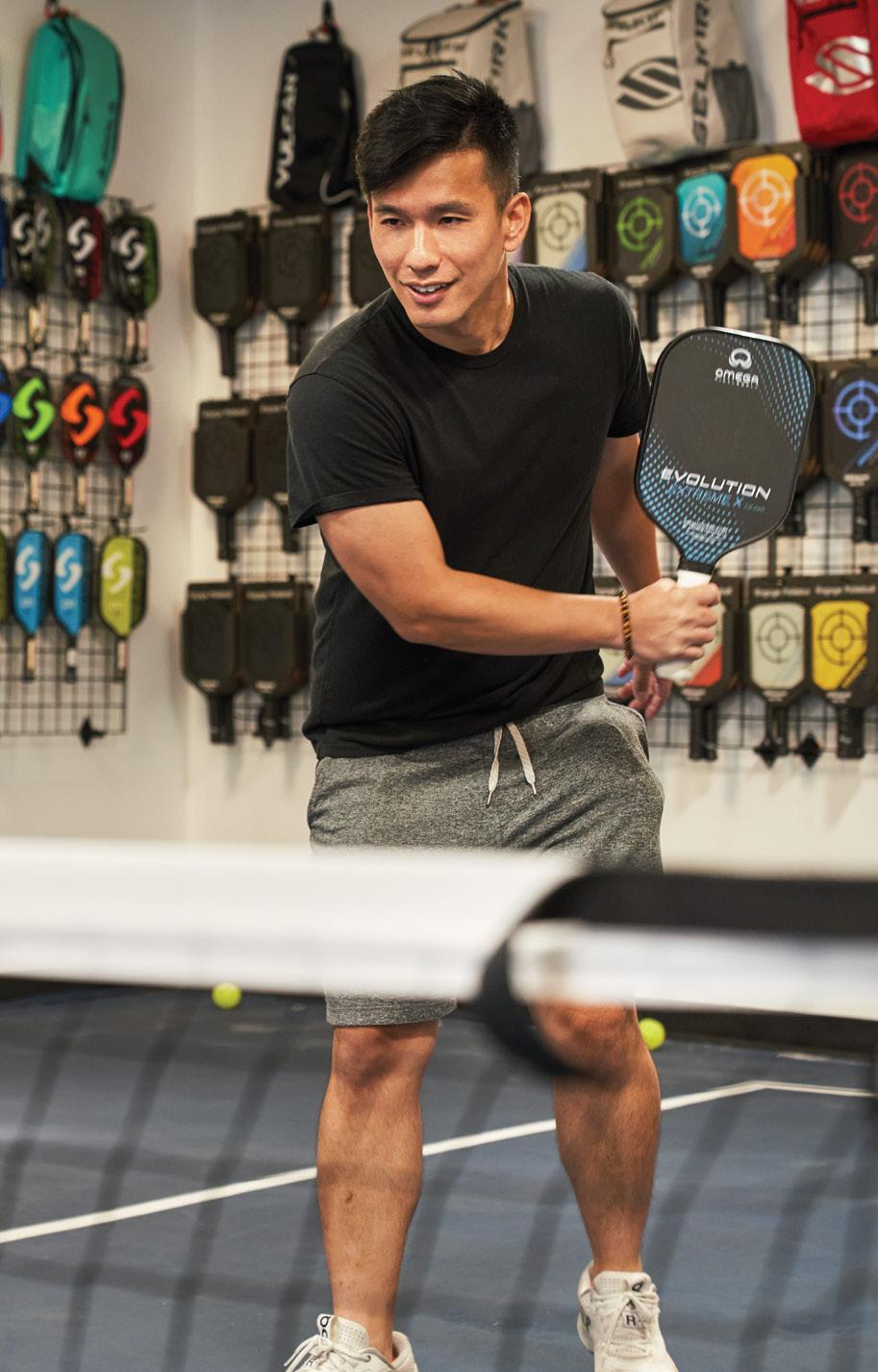

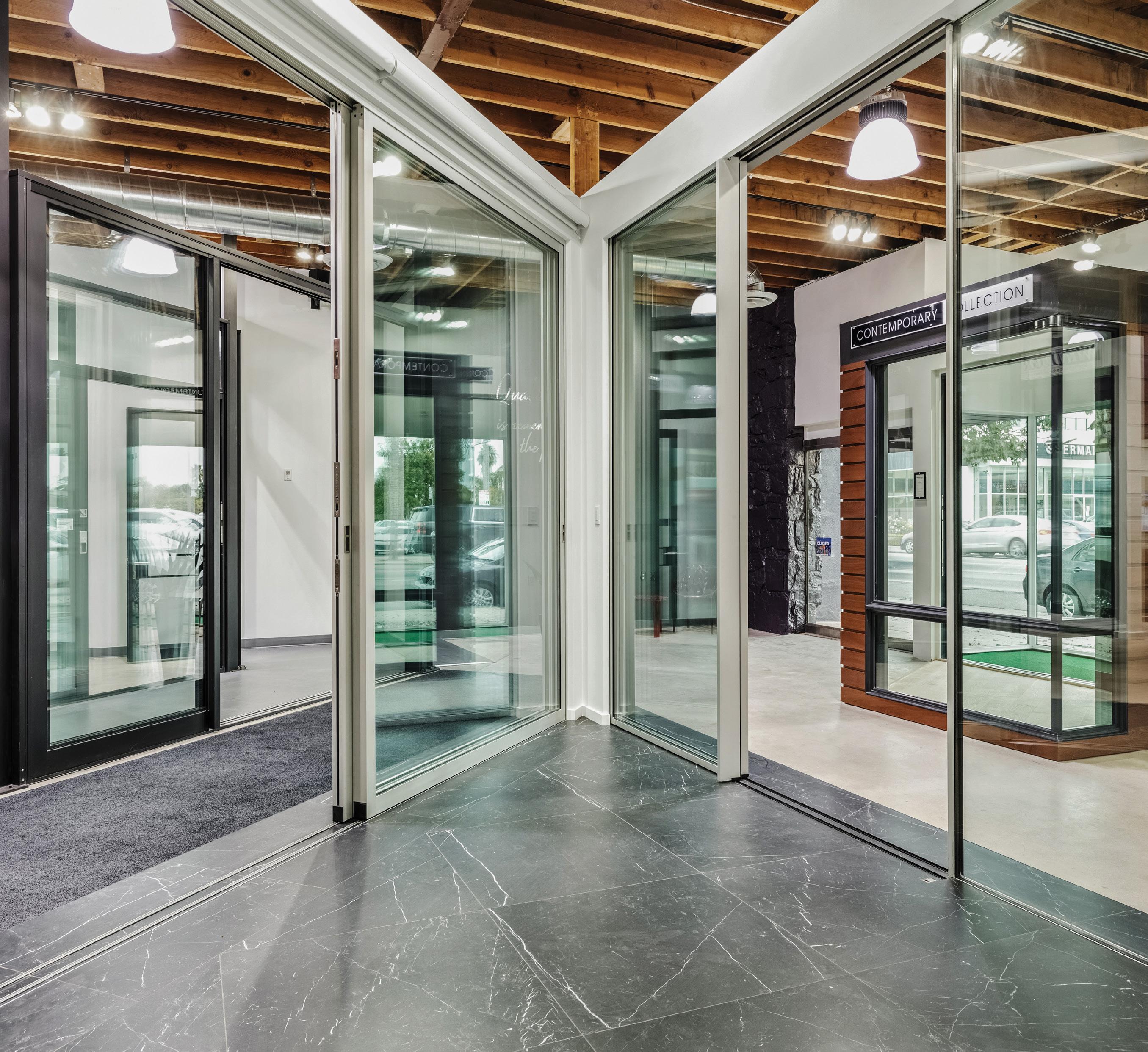
EDITOR-IN-CHIEF
Linda Grasso
EDITORIAL DIRECTOR
Darren Elms
COPY EDITORS
Bob Howells, Laura Watts
CONTRIBUTORS
Diane E. Barber
Robert Earle Howells
Jenny Karl, Dakota Kim Chloe King, Hadley Hall Meares
Allison Rae Marsh, Chelsee Lowe
Joshua Lurie, Anne M. Russell
Steven Stiefel, Jean Trinh
Michelle Villas
Ajay Peckham and Yuiko Sugino
Paul Fisher
PHOTOGRAPHERS
Michael Becker
Tameka Jacobs
Shane O’Donnell
Monica Orozco
PUBLISHER
Robin Sanders
424-220-6340 robin@thegoldenstatecompany.com
ADVERTISING
DIRECTOR OF BRAND PARTNERSHIPS
Sue Williams
818-625-3515 sue@thegoldenstatecompany.com
VENTURA BLVD IS A DIVISION OF THE GOLDEN STATE COMPANY
MANAGING PARTNERS
Charlie Koones Todd KlawinMARKETING & OPERATIONS
PARTNER/BRAND PUBLISHER | Emily Stewart
PARTNER/MANAGING DIRECTOR, MEDIA & ANALYTICS | Warren Schaffer MANAGING DIRECTOR, TECHNOLOGY | Charles Simmons DIRECTOR OF FILM & VIDEO | Bryce Lowe-White OPERATIONS DIRECTOR | Allison Jeackjuntra
SOCIAL MEDIA MANAGER | Melissa Hattab ACCOUNTING | Janet De La Cruz, Tanisha Holcomb
To learn more about us, visit thegoldenstatecompany.com.
No part of this periodical may be reproduced in any form or by any means without prior written consent from The Golden State Company LLC. Any and all submissions to this or any of The Golden State Company LLC publications become the property of The Golden State Company LLC and may be used in any media.
We reserve the right to edit.
SUBSCRIPTIONS Email: info@goldenstate.is or phone: 310-376-7800. Subscriptions are $29 per year.
TO OUR READERS Ventura Blvd welcomes your feedback.
Please send letters to: Reader Response Department, Ventura Blvd at address below.
Include your name, address and email. Edited letters may be published.
200 N. Pacific Coast Highway, Suite 110, El Segundo, CA 90245 Tel 310-376-7800 | Fax 310-376-0200 | goldenstate.is | venturablvd.goldenstate.is


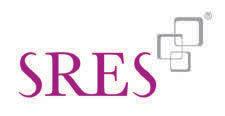
At the “Guy Gifting” photo shoot, page 24.
When the days start becoming shorter and the nights cooler—signs that summer has reached an end—I typi cally feel wistful. No more veggies from my summer garden; no more al fresco dinners by the pool. But it’s different this year. I’ve never been so happy to see fall and its cooler temperatures arrive. Weeks of stifling heat; staying indoors for days on end; watching my plants (even my hardiest perennials) die … I got pretty cranky. I’ve been trying to gradually shift to drought-tolerant plants over the years, and my lawn has been reduced to two slivers. My husband and I are both from the East Coast, where having a nice home equates to having a green lawn—and we just can’t seem to rid ourselves of this mindset and let it all go. Plus our fake-grass guy has literally doubled his prices over the past five years and we are having trouble diving on the grenade, even though our two small patches are a dismal shade of brown. But I am planning on doing more converting. Maybe not buying more fake turf, but instead more heat-tolerant natives. With temperatures expected to rise every year, it simply doesn’t make sense to replant what I had before. For me, a wonderful resource for gardening has been the Theodore Payne Foundation in Sun Valley
(theodorepayne.org). They offer a comprehensive roster of classes by local experts, all geared toward how we can have beautiful yet drought-tolerant gardens. Classes this October include how to irrigate California native plants and how to care for oak trees. I’m super interested in the latter. Other than deep watering trees monthly in the summer with an irrigation wand, I have no idea how to care for these majestic beauties. And don’t miss the non profit’s annual fall plant sale that kicks off November 8. It’s a chance to pick up natives at great prices and learn how to care for them.
Saying goodbye to summer also means a shift in fash ion, as illustrated in this annual MEN’s issue on page 28. For this year’s fall fashion shoot, we zero in on comfy, ca sual clothes with sumptuous textured fabrics and curated accessories that offer a sense of drama. It’s that effortless California casual look, where you could be having friends over or going out to dinner. Honestly, while fancy stuff is tons of fun and some might argue more aspirational, clothes that feel just thrown on—items you can live in— are what we get the most mileage from. Photographer Michael Becker, stylist Allison Rae Marsh and model/actor Nick Checket capture that look with aplomb.
Follow me on Instagram @she_sez




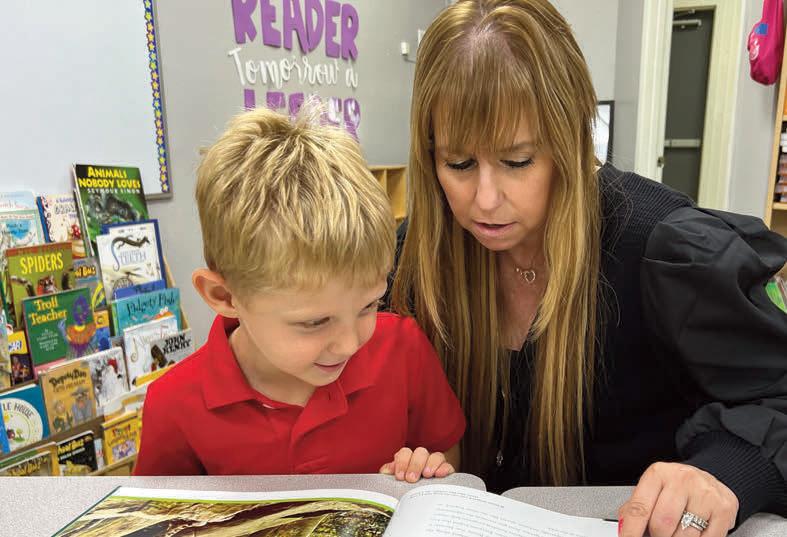

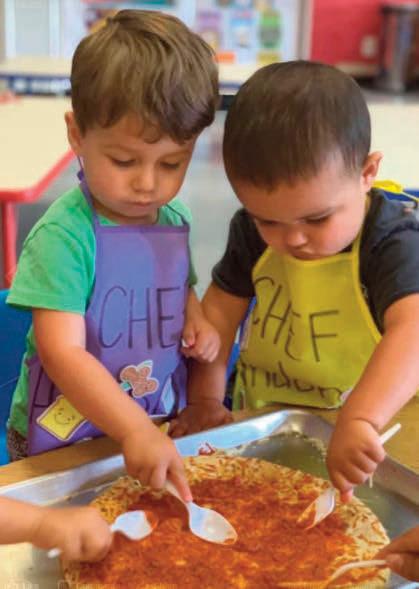


Sunday, November 6, 2022 | 12:30pm - 3:15pm
Grades 5-10 are welcome to come to our beautiful campus to meet Marymount’s incredible Faculty, Staff, and Student Ambassador Team! This is an interactive and exciting event featuring various breakout sessions, giving you the opportunity to learn about everything Marymount, including: Academics, College Counseling, Athletics, STEM, Arts, and more!



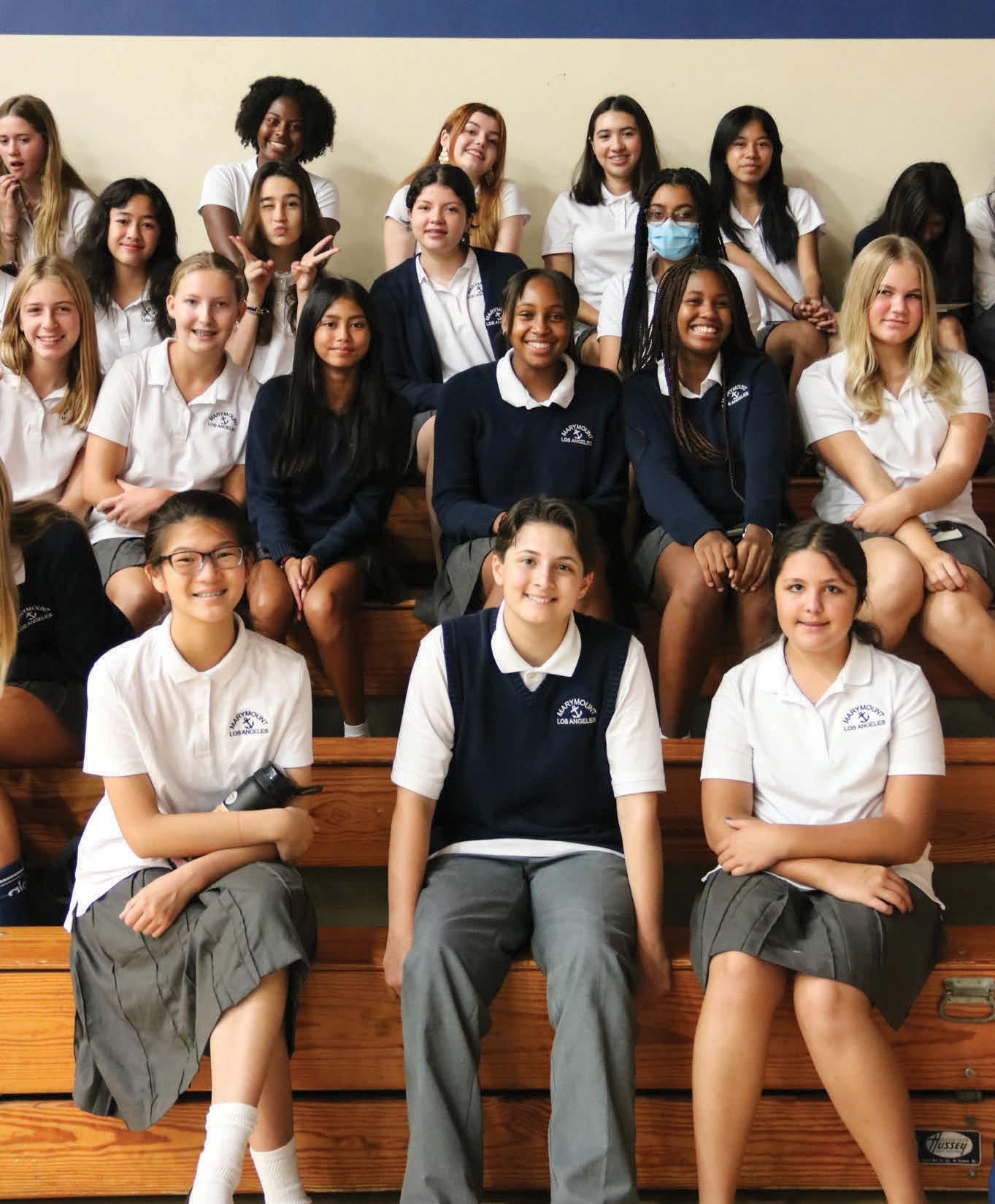

An artist paints his love for all things LA. More on the next page.



Scott Yeskel is a SoCal boy through and through. Raised in Orange County, he now lives in North Hills, where his home studio is filled with brightly colored canvases of familiar Valley scenes—historic restaurant interiors, cool pools ready for a dip, and landscapes featuring midcentury modern homes in a style reminiscent of the realist painter Edward Hopper. “It’s not the easiest place to survive, to live. It’s certainly not the prettiest all the time. It’s real,” he says. “It’s authentic. It’s diverse. So it keeps me visually very stimulated all the time. It’s just this imperfect facade of everything that constantly inspires me.”
Always creative, Scott graduated from the Academy of Art University in San Francisco in 2002. He found early success in San Francisco as a landscaper painter. “People embraced the work right off the bat,” he recalls.

But home was calling. After eight years, the artist moved back to Southern California, at first living with his brother in Venice. He found the local art scene a tough nut to crack, but the scenery was inspiring. “The one thing that kept me interested in being in LA was the landscape. I didn’t really want to paint San Francisco trolley cars,” he says. “That did not interest me.”
He soon found success painting the places here that intrigued him the most, from the freeways to taco trucks to lone Airstreams, all lit by the bright western sun. “The light down here and the romanticism of the flat landscape, the faded history, the new, the old, the different styles of architecture, the vast mecca that it is from the desert to the beach and everything in between, gave me a lot to think about,” he says.
Eight years ago, Scott and his young family moved to the North Valley, and he set up his home studio in the back house. He began to explore his new environs, finding inspiration in the area’s dichotomies. “It further reinforced

these crazy, ridiculous, mixed emotions that we have about LA,” he says. “The wonderful mid-century architecture, the pools in every backyard, the tall palm trees, the way the sun kind of hits the water in the morning, and then the absolute cruel grittiness of it all as well.”
His vibrant, realist works have become particularly popular with natives of Southern California, no mat ter what part of the country they currently live in. He has been featured in dozens of solo shows and group exhibitions and is in private and corporate collections including the Microsoft Art Collection and Fox TV in Los Angeles. He also teaches painting to artists of all ages.
During the pandemic, Scott embarked on a project that he describes as both personal and altruistic: paint ing some of California’s historic eateries, including VIP’s Cafe in Tarzana and Casa Vega in Sherman Oaks. “I donated some of the money to the 86FUND that helped restaurant workers who were out of work make ends meet,” he says. “This city has an incredible array of historic restaurants, and you just hate to see any of them go through something like that.”
Since the pandemic, Scott has shifted to vibrant, large-scale desert scenes in preparation for his
upcoming show at Dawson Cole Fine Art in Palm Desert. His nostalgic paintings reflect his deep appreciation for the history, architecture and lifestyle of SoCal as well as its constant evolution. “I’m the guy that walks in LA. I do that. And I like to see things that maybe people don’t think about as much,” he says. “There is love and appreciation, but it’s more discovery and respect. The theaters, the restaurants like Casa Vega—it’s just out of respect. It’s been there. I hope it stays there.” ■
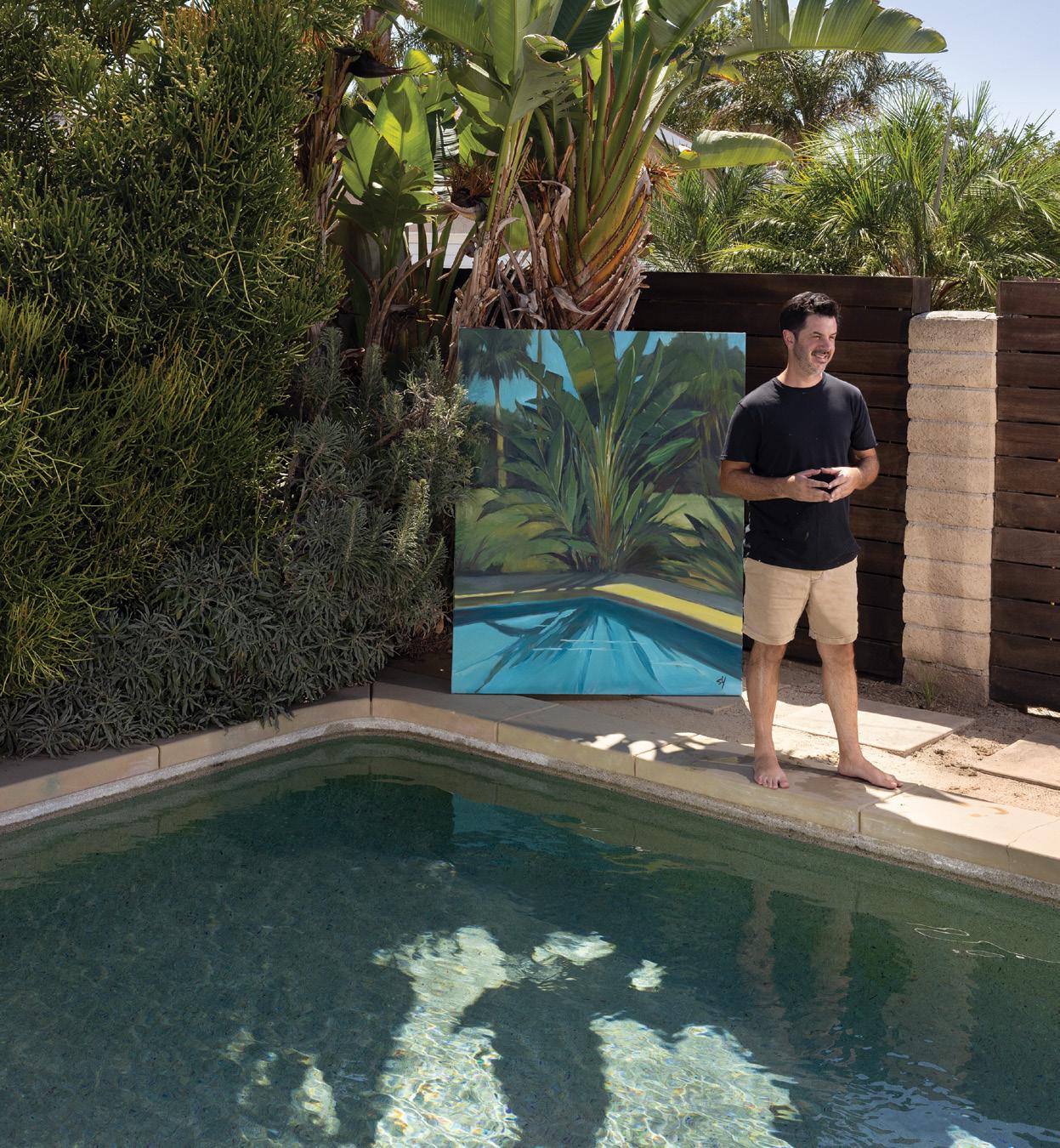
Jason B. Friedman, CFP®, CRPC®
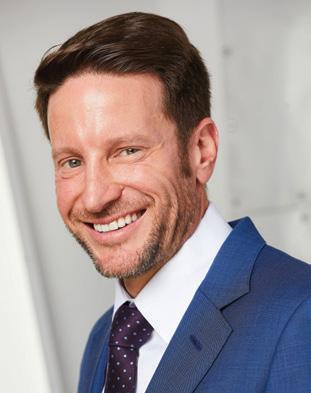
Vice President–
Wealth Management
Portfolio Manager
jason.friedman@ubs.com
The Tidik-Friedman Wealth Management Group

UBS Financial Services Inc.
4421 Riverside Drive, Suite 206 Burbank, CA 91505



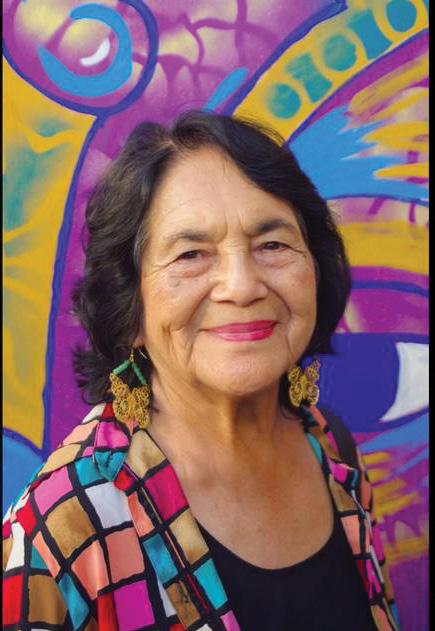
Dolores Huerta will be the guest of honor for a musical tribute hosted by The Soraya on Sunday, November 13 at 7 p.m. One of the most influential women of the 20th century, Dolores is an American labor leader and civil rights activist who has worked tirelessly for decades to challenge gender barriers, campaign for women’s rights and correct economic injustice.

Dolores was born in a small town in New Mexico. Her father was a farm worker and miner, as well as a union activist who won a seat in the New Mexico legislature in 1938. Her mother was an entrepreneur and activist. Dolores spent most of her child hood and early adult life living in Stockton, California. While working as a schoolteacher, she was distressed to see students with empty stomachs and bare feet, so she found her calling as an organizer.
Much of her work has centered around
fairness for farm workers like her father. She has advocated for safer working conditions, fought for unemployment and health care benefits, and with Cesar Chavez cofounded the organization that today is known as the United Farm Workers. She was instrumental in the enactment of the Agricultural Labor Relations Act of 1975, which allowed agricul tural workers to form unions and bargain for better wages and conditions.
Dolores has received many honors throughout her years of service, including the Eleanor Roosevelt Human Rights Award in 1998 and the Presidential Medal of Freedom in 2012. Four schools are named after her, and she was inducted into the California Hall of Fame in March 2013.
At age 92, she continues to work tirelessly developing leaders and advocating for the working poor, women and children. She works with immigrants in the San Joaquin Valley ensuring they become familiar with
laws and agencies that can protect them and the benefits to which they are entitled. As founder and president of the Dolores Huerta Foundation, she travels the country engaging in campaigns and influencing leg islation that supports equality and defends civil rights. She often speaks to students and organizations about issues of social justice and public policy.
At “Concierto Para Dolores: A Musical Tribute to Dolores Huerta,” performers and audience members will unite for an evening honoring Dolores’ lifetime devotion to the labor and civil rights movements. Directed by Dan Guerrero and musical director Cheche Alara, entertainers include come dian and the evening’s host Cristela Alonzo; musicians John Doe, La Marisoul, David Aguilar, Gaby Moreno, and Marilyn McCoo and Billy Davis Jr.; a world-class house band; and Mariachi Garibaldi de Jaime Cuéllar.
While many know Dolores for her
accomplishments and global impact, what might not be as well known is her passion for music, dance and culture. In creating this concert, The Soraya started with Dolores herself—her fondest memories and the music that inspired activist movements. The result is a unique collection of folk music, R&B, ballads and mariachi. The event will include clips of Dolores speaking to a variety of groups, courtesy of the Pacifica Radio Archives and radio station KPFK.

There is no better stage for such a
celebration than the one at California State University, Northridge, where Dolores has had a longstanding relationship including receiving an honorary doctorate in 2002.
The Younes and Soraya Nazarian Center for the Performing Arts (The Soraya) offers a wide variety of performances throughout the year that reflect Los Angeles’ many distinc tive communities, featuring new and original work from local and international artists.
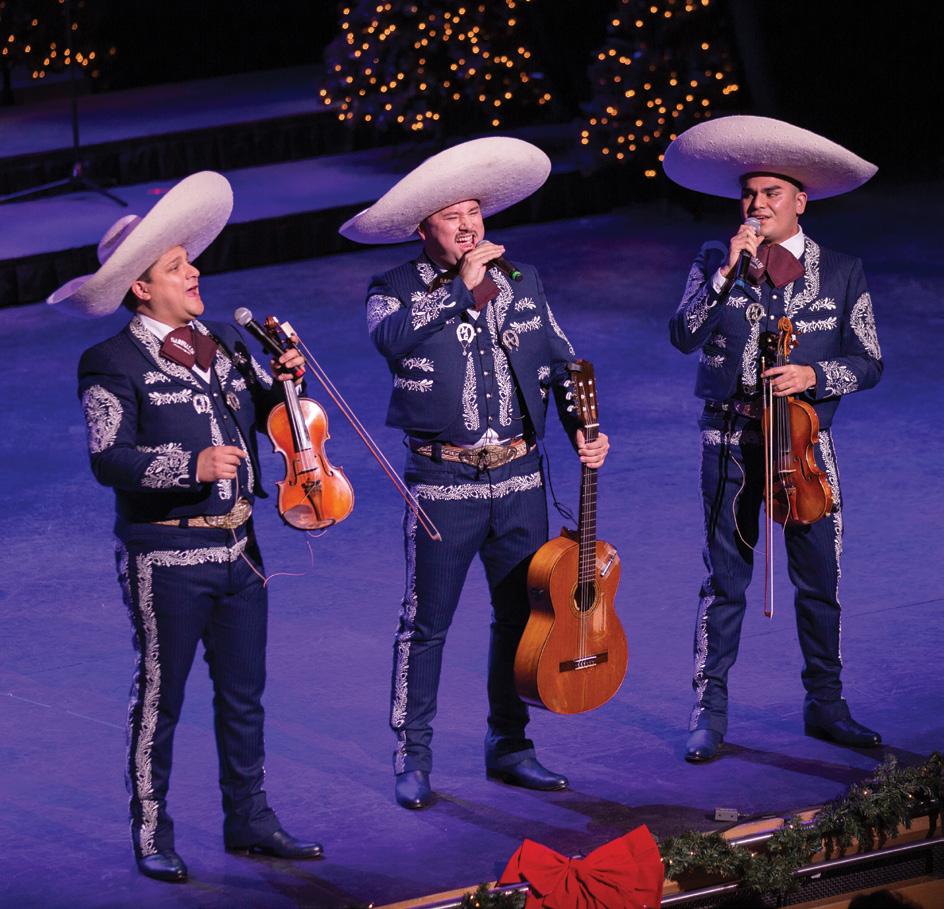
The Soraya’s 2022–2023 season features a vibrant program of nearly 50 classical


and popular music, dance, theater, family and international events to uplift and inspire its audiences. Contact The Soraya for ticket information.
NORDHOFF ST., NORTHRIDGE THESORAYA.ORG 818-677-3000
& IG: @THESORAYASTAGE

SENDING A THANK-YOU OR GIFT TO A MAN CAN BE A CONUNDRUM, ESPECIALLY WHEN IT COMES TO FLOWERS. WE ASKED THREE VALLEY FLORISTS TO COME UP WITH A MASCULINE ARRANGEMENT. HERE WE SHARE THEIR CREATIVELY NAMED, ARTFUL SUGGESTIONS.
 Photographed by Shane O’Donnell
Photographed by Shane O’Donnell
Includes: Cymbidium orchids and phalaenopsis orchids; $300
“If femininity is characterized by softness, movement and dimensionality, the Prince Charming is masculine in its simplicity, bold ness and sculptural quality. With neutral colors that symbolize reverence, humility, wealth and vitality, it’s sleek and unfussy.”
Carmela de Castro Co-owner, Orchid Republic orchidrepublic.com
Includes: Lisianthus, delphinium, kale, kiwi branches, ranunculus, amaranthus, stock, aga panthus sprockets, thistle, seasonal grasses; $500
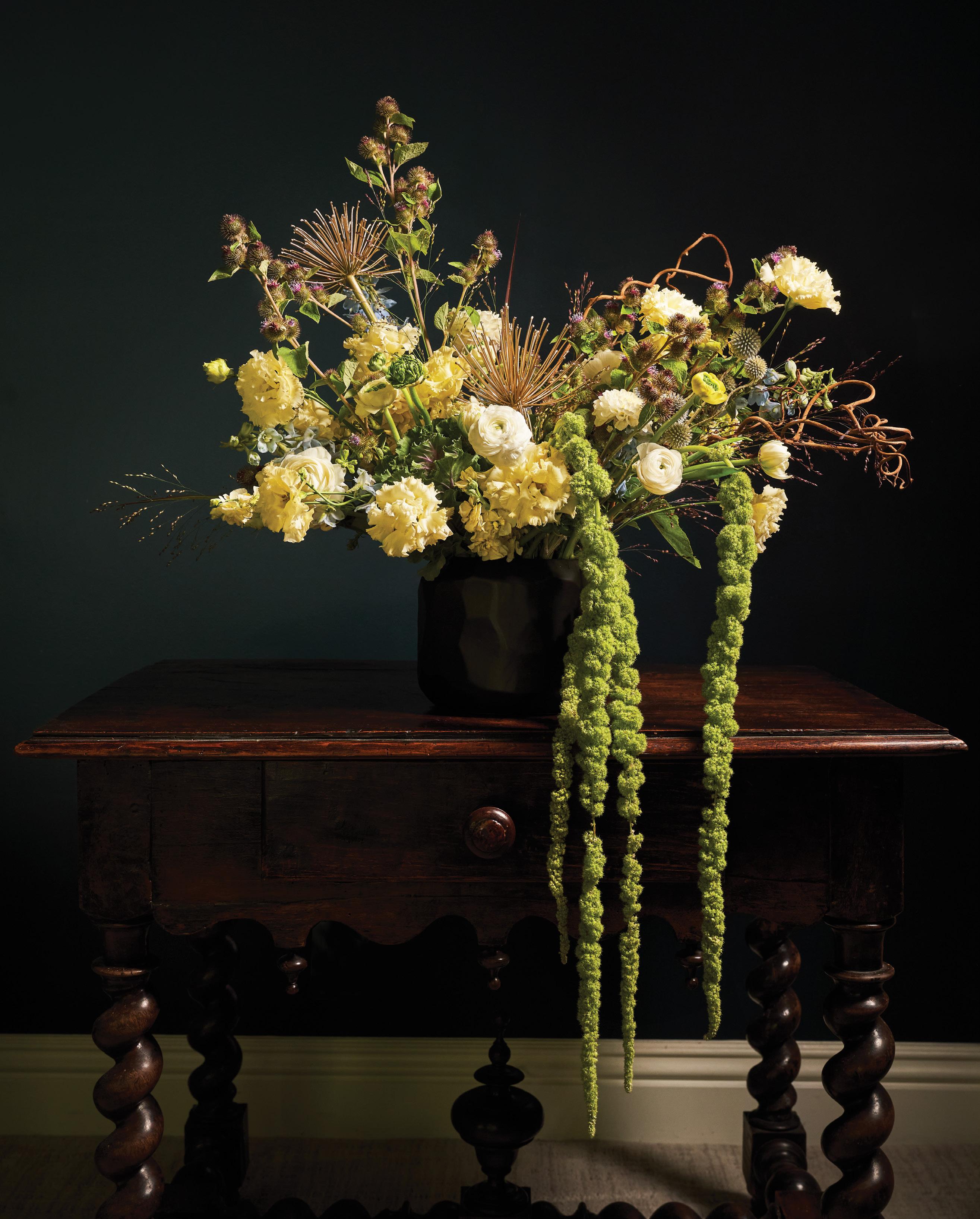
“This piece is visually interesting and strong. Masculinity exudes confidence, strength, and being comfortable in your own skin, and this arrangement offers that. It’s neutral enough to fit in any setting and offers a sense of luxury without feeling stuffy.”
Owner, Domonique Rose domoniquerose.com
Includes: Red torch gingers, anteriums, Bombay dendrobium orchids, birds of paradise heliconia, stargazer lily, pink mink protea, berzillia palm and ti leaves; $200
“With large blossoms in bold colors, tropi cal flowers are robust. When a customer asks for a masculine arrangement, I always sug gest a tropical vibe and something that has a strong structure and is impressive—like this arrangement.”
 Nancy Hasson
Nancy Hasson
Owner, Casa de Flores casadeflores.us
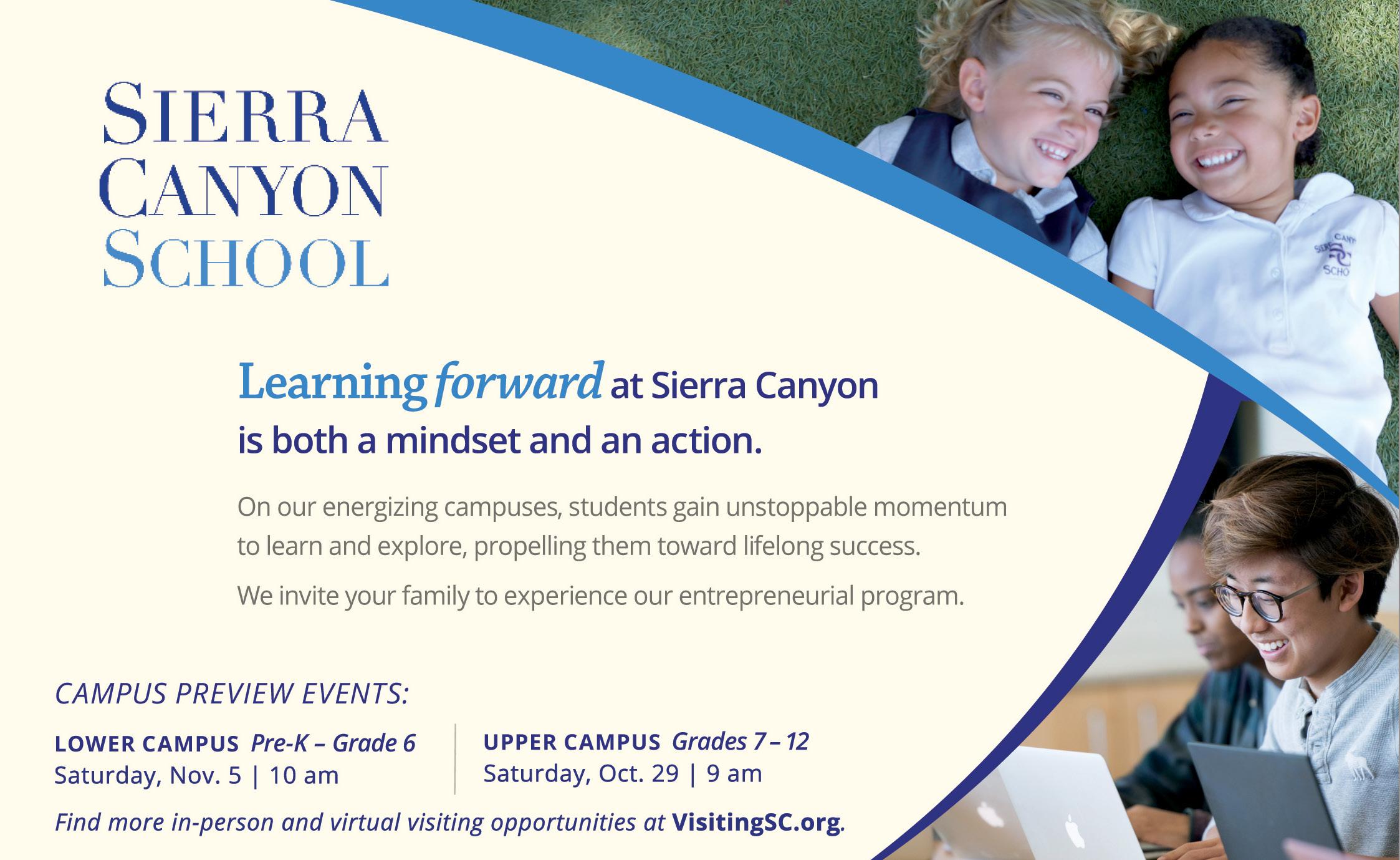


White Sand navy pinstripe pant, $295, Fradi merino sweater, $295, and maroon polka dot socks, $42; all available at Sy Devore in Studio City. Vinny penny loafers, $295; available at Bloomingdale’s. Rolex YachtMaster platinum watch with stainless steel bezel, crystal and sapphire, $13,000; available at Steven & Co. Jewelers in Beverly Hills.
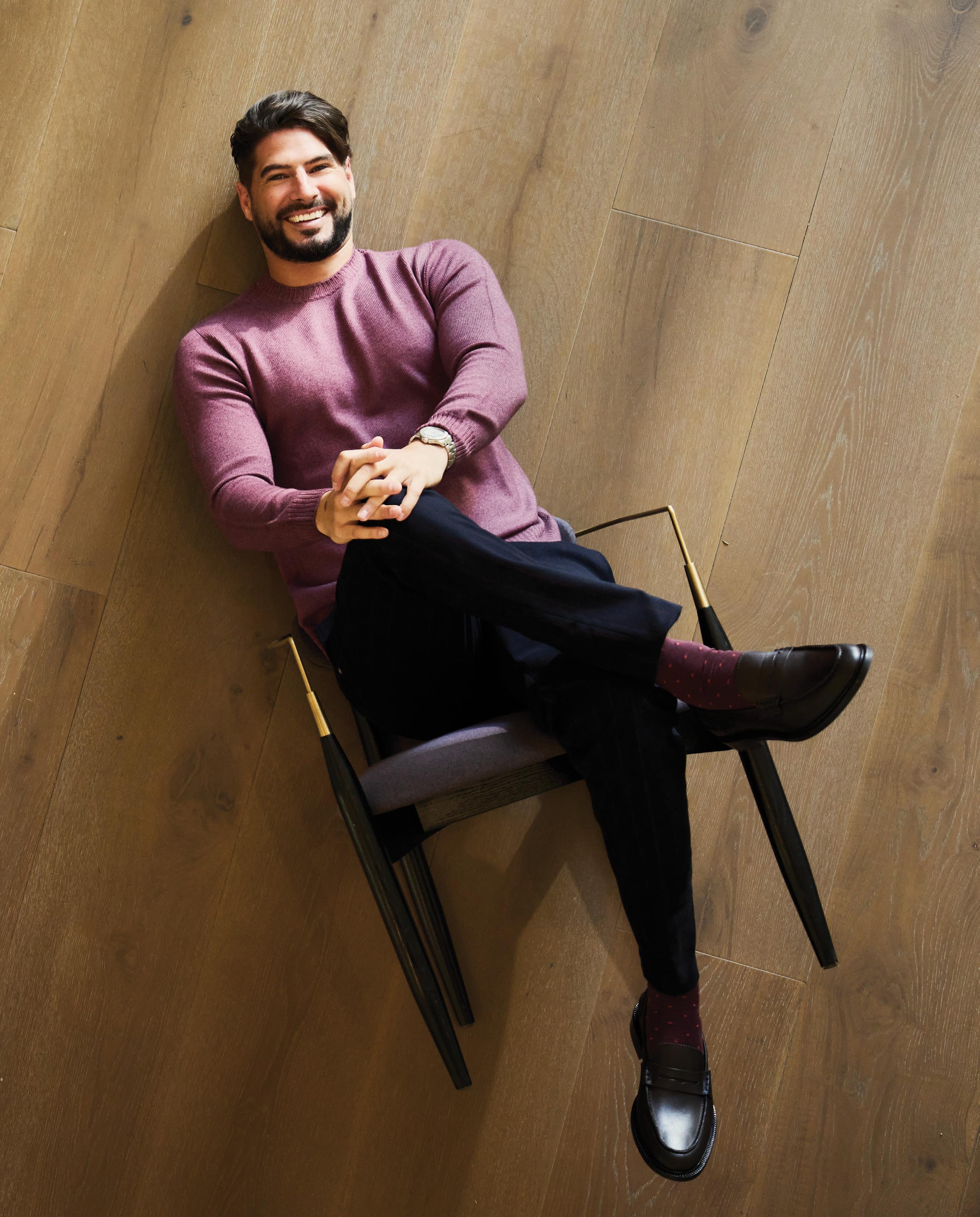
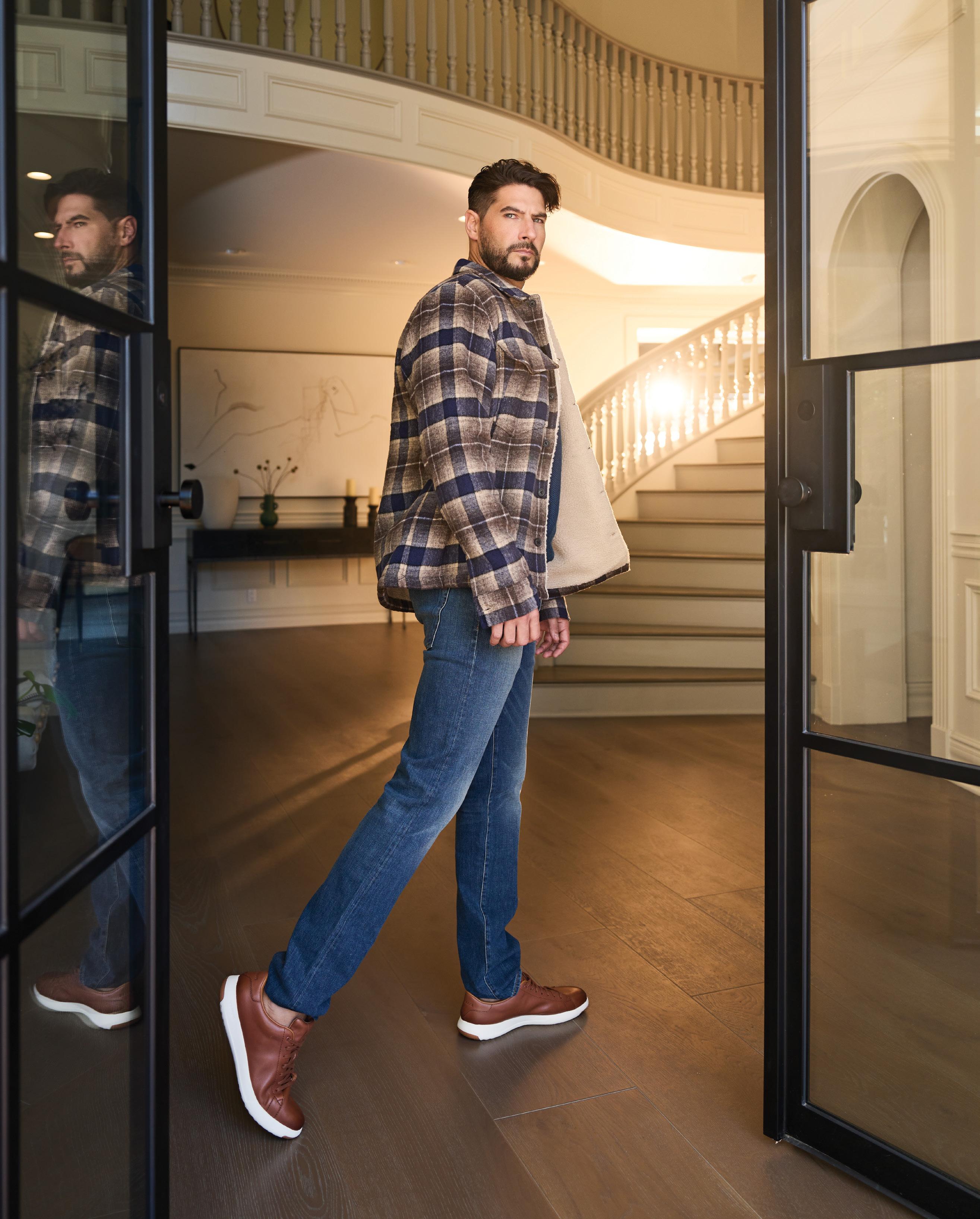
left:
Michael Kors blue sweater, $148, All Saints Willingboro plaid jacket, $299, and Cole Hahn Grand Pro tennis shoes, $150; all available at Bloomingdale’s. Kato jeans, $295; available at Sy Devore.
right:
Vince jacket, $1,250, James Perse T-shirt, $80, and All Saints pants, $169; all available at Bloomingdale’s.
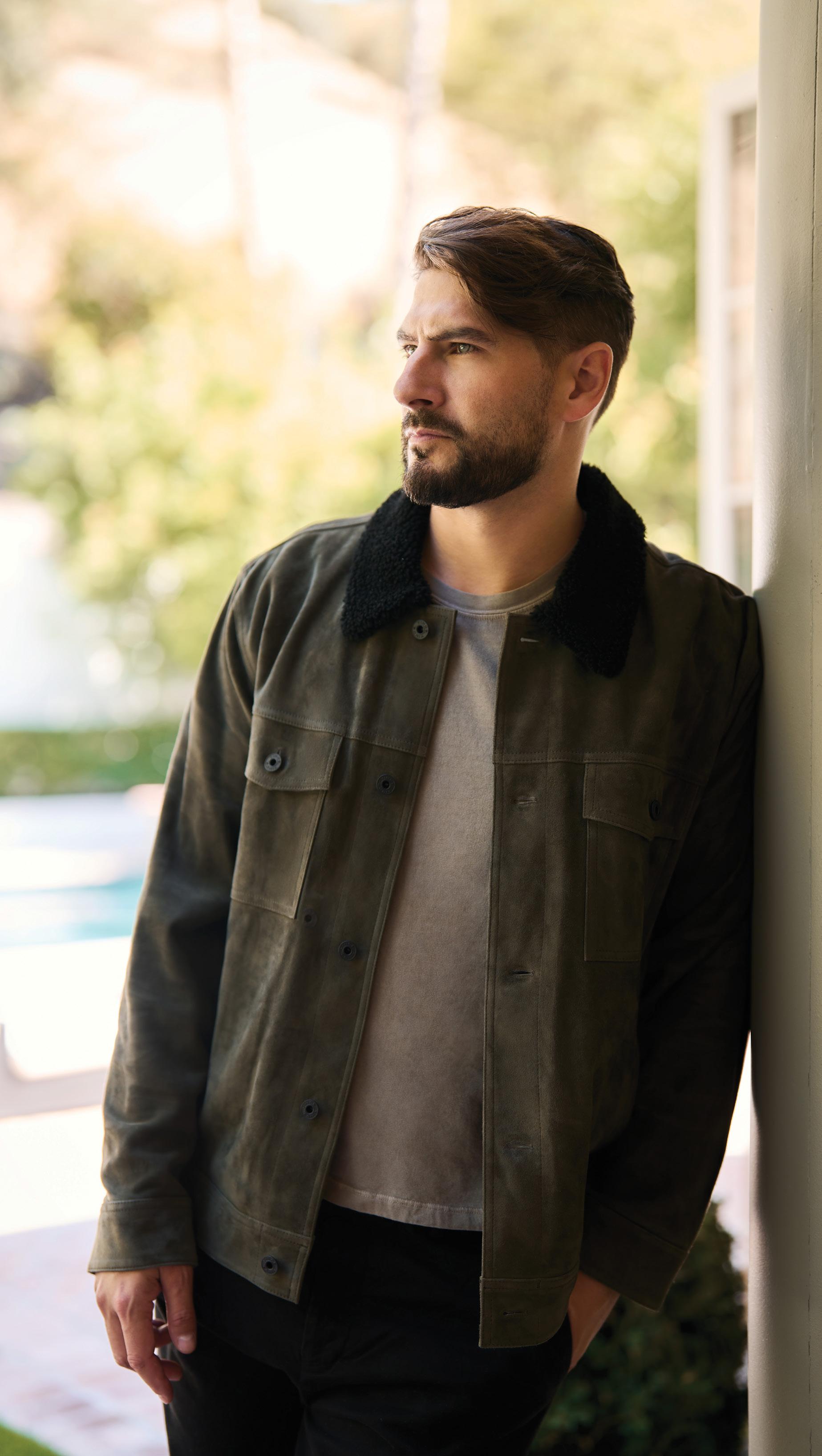
ATM Anthony Thomas Melillo drawstring pants, $225, and All Saints Mode merino wool cardigan, $149; both available at Bloomingdale’s. Jerry Kaye Collection T-shirt, $115, and Philippe Model sneakers, $395; both available at Sy Devore. Paisley scarf: owned by stylist.

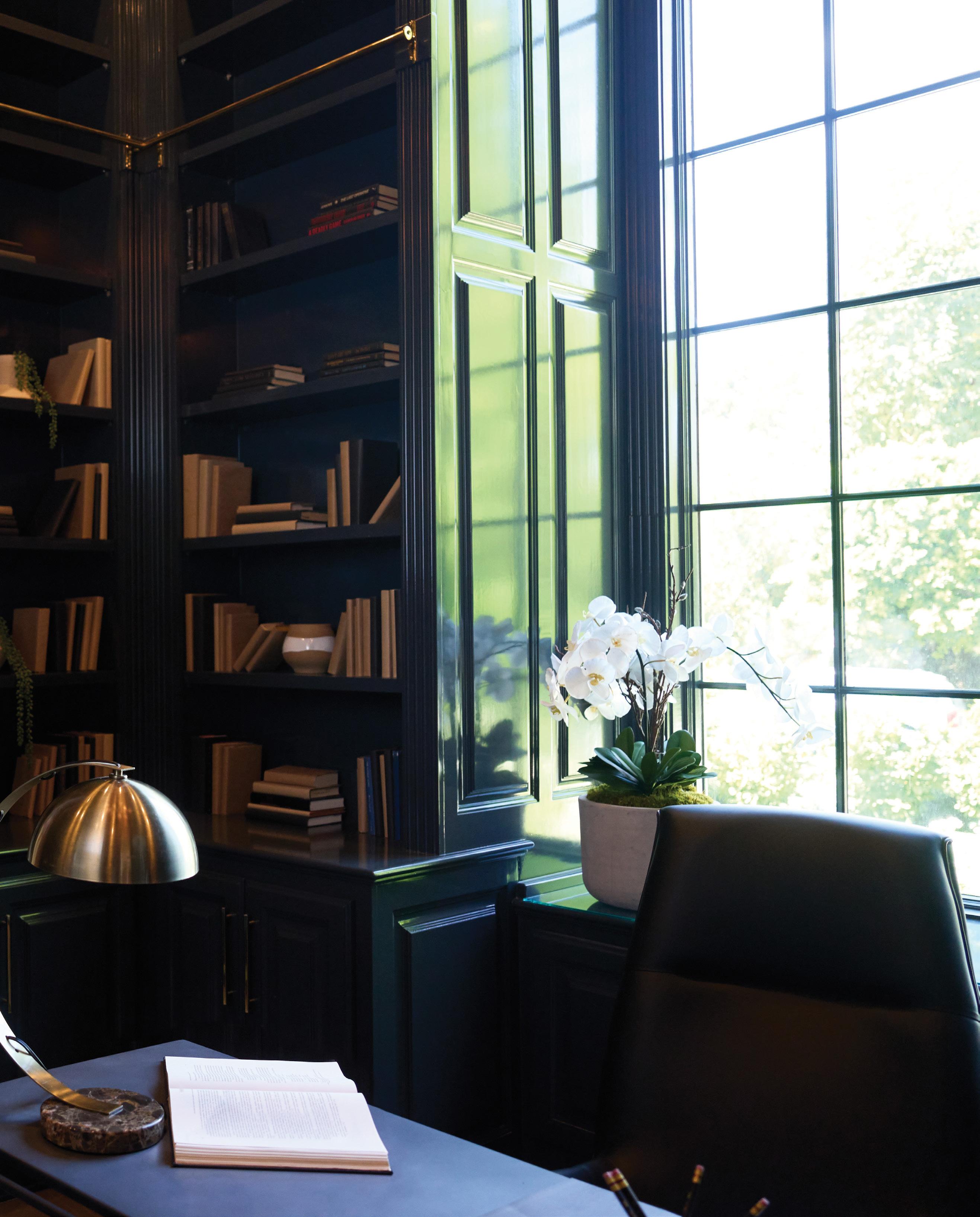
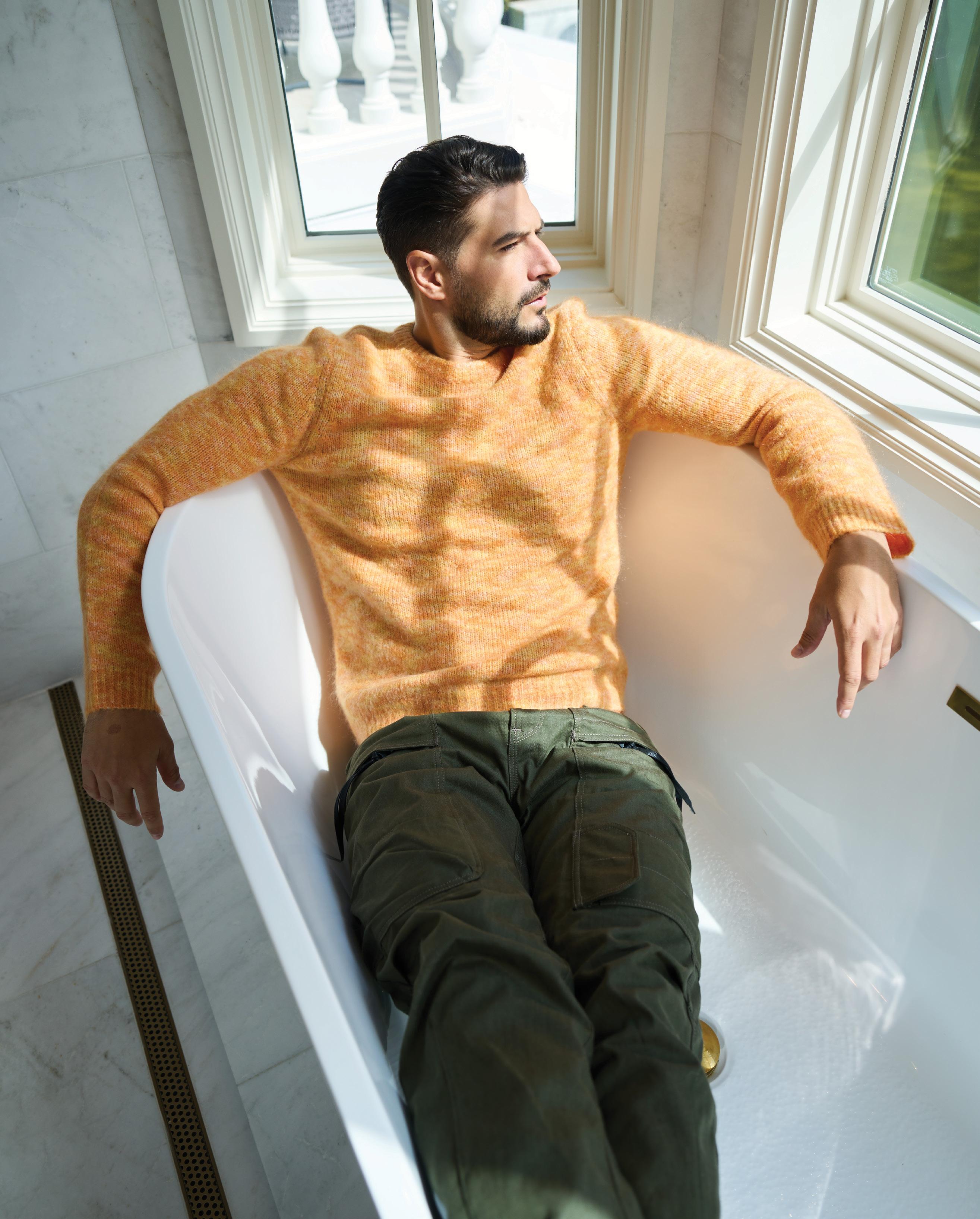
left:
G-Star Raw denim cargo pants, $210, and Sandro melon orange cashmere sweater, $490; both available Bloomingdale’s.
right:
All Saints sweater, $249, Puma sneakers, $89, and Paige pants, $199; all available at Bloomingdales’s.
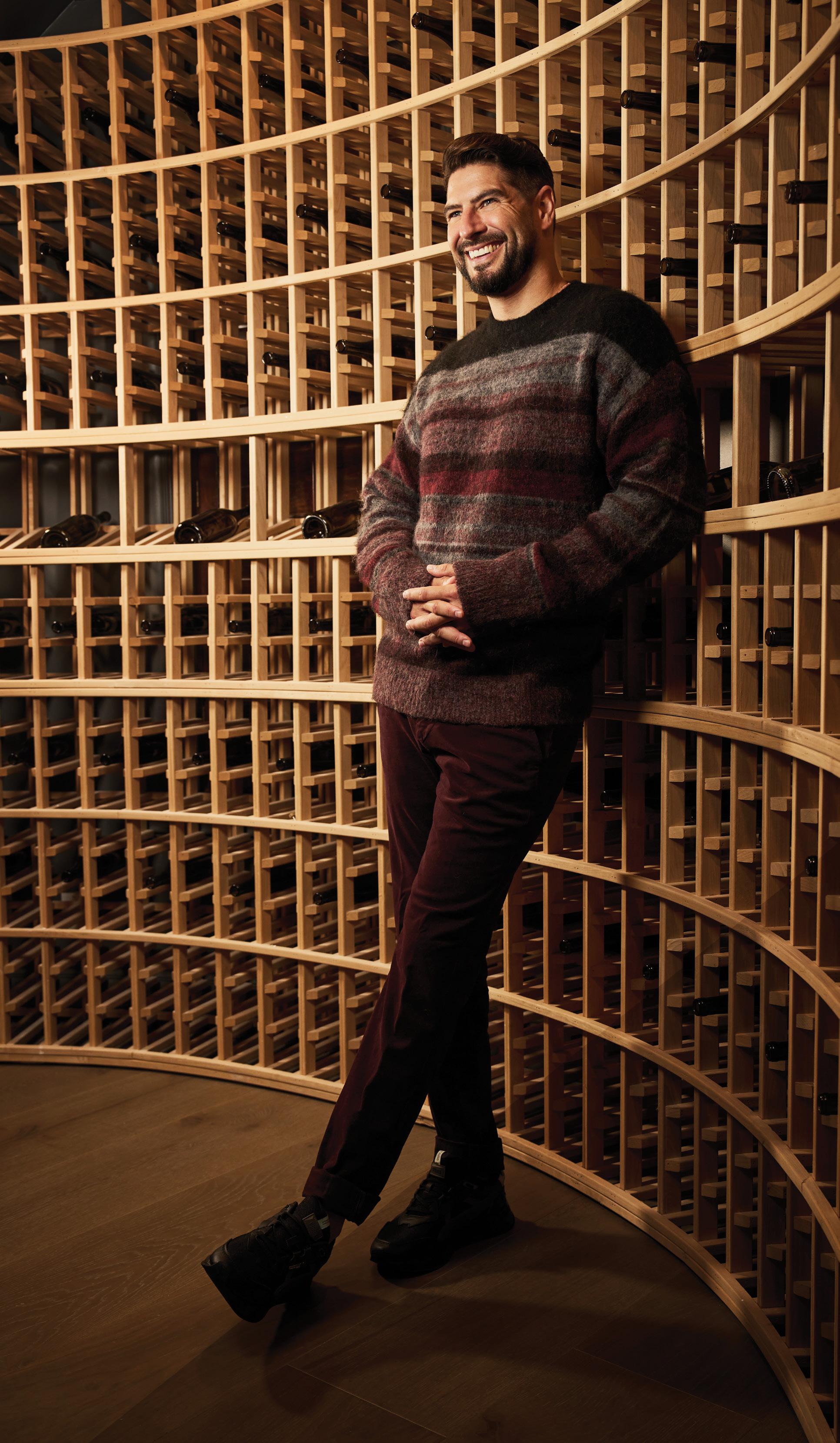
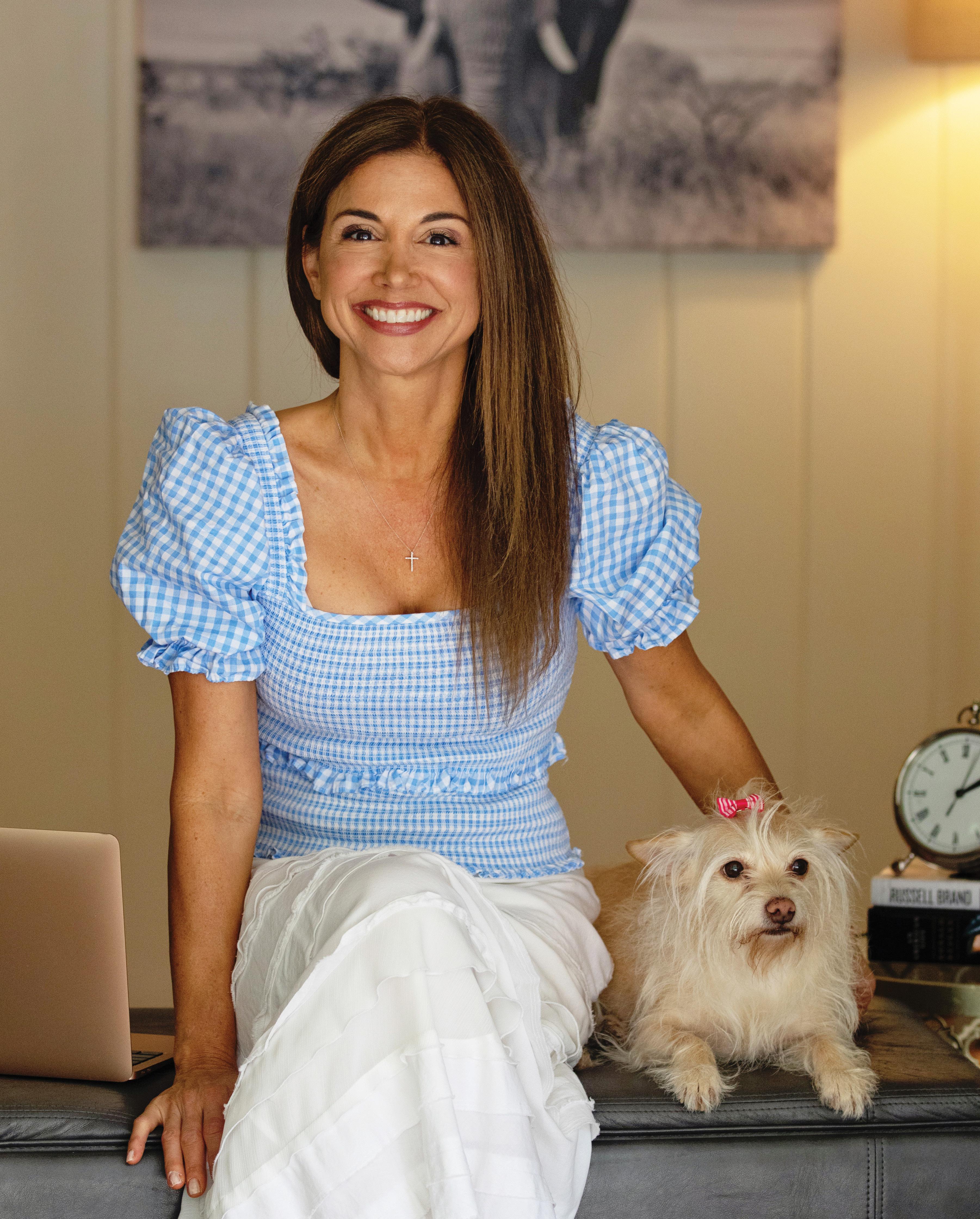
Real estate agent Jordan Reghetti connects people with a new home in a new city.
WRITTEN BY LAURA L. WATTS | PHOTOGRAPHED BY TAMEKA JACOBSYou’ve made the decision to relo cate. You know where you’re going … but now what? Making yourself at home in a new city can be over whelming. And that’s where Jordan Reghetti steps in.
A California real estate agent for the past 17 years, Jordan is familiar with the stress and emotions that often accompany a decision to buy a new home—especially in a new area. She created her firm, Reghetti To Move, to connect the dots for clients moving away from Los Angeles.

Over the years, she has created a vast network of colleagues across the United States who are ready to step in and be part of the process. Whatever her clients may need—from real estate agents to movers and organizers—Jordan serves as the coordina tor for their out-of-state moves. “Wherever you’re going, I can help you get there,” she says. “I am an agent and a concierge.”
Clients contact Jordan as soon as they know their new location and are ready to list their house. Jordan jumps in and helps them form a relocation team—assisting with listing their LA home while working with their Realtor in the new location. After an initial video inter view, Jordan creates the client’s individual ized plan, demonstrating from the get-go her highly developed organizational skills.
“From A to Z, I’m a point-checker,” she says. “I take the anxiety off clients so they can do what they need with their career and/or family to make the move.
Meanwhile, my team is in the background running the show so it’s seamless for them.”
Jordan says clients appreciate her open communication and blatant honesty. “There are very few agents who operate with total honesty, but I’m honest to a fault. Clients appreciate what I have to offer.”
When adding a new Realtor to her tribe, Jordan is thorough in her selection strategy. She attributes her stealth negotiating skills to watching her father—a successful entrepre neur—from a young age.
“I have a 21-question vetting process, as I have learned not to rely on referrals alone,” she explains. “The all-encompassing agents in my network offer specific expertise and strong familiarity with their local area. They can connect our clients with movers, housekeepers, organizers, dog walkers and city activities, and assist with utility hookups. They all go the extra mile. They know the
little details that make a big move as peace ful as possible.”
Jordan’s skills for connecting and helping organize people’s lives stem from the years she spent working in a supportive role for movie and TV professionals. “Being a personal assistant to producers and directors early in my life taught me to pay close attention to details and to make things as simple as possible,” she shares. “I learned very quickly that efficient communication and organization are crucial.”
A few tidbits and fun facts about Jordan and her favorite things:
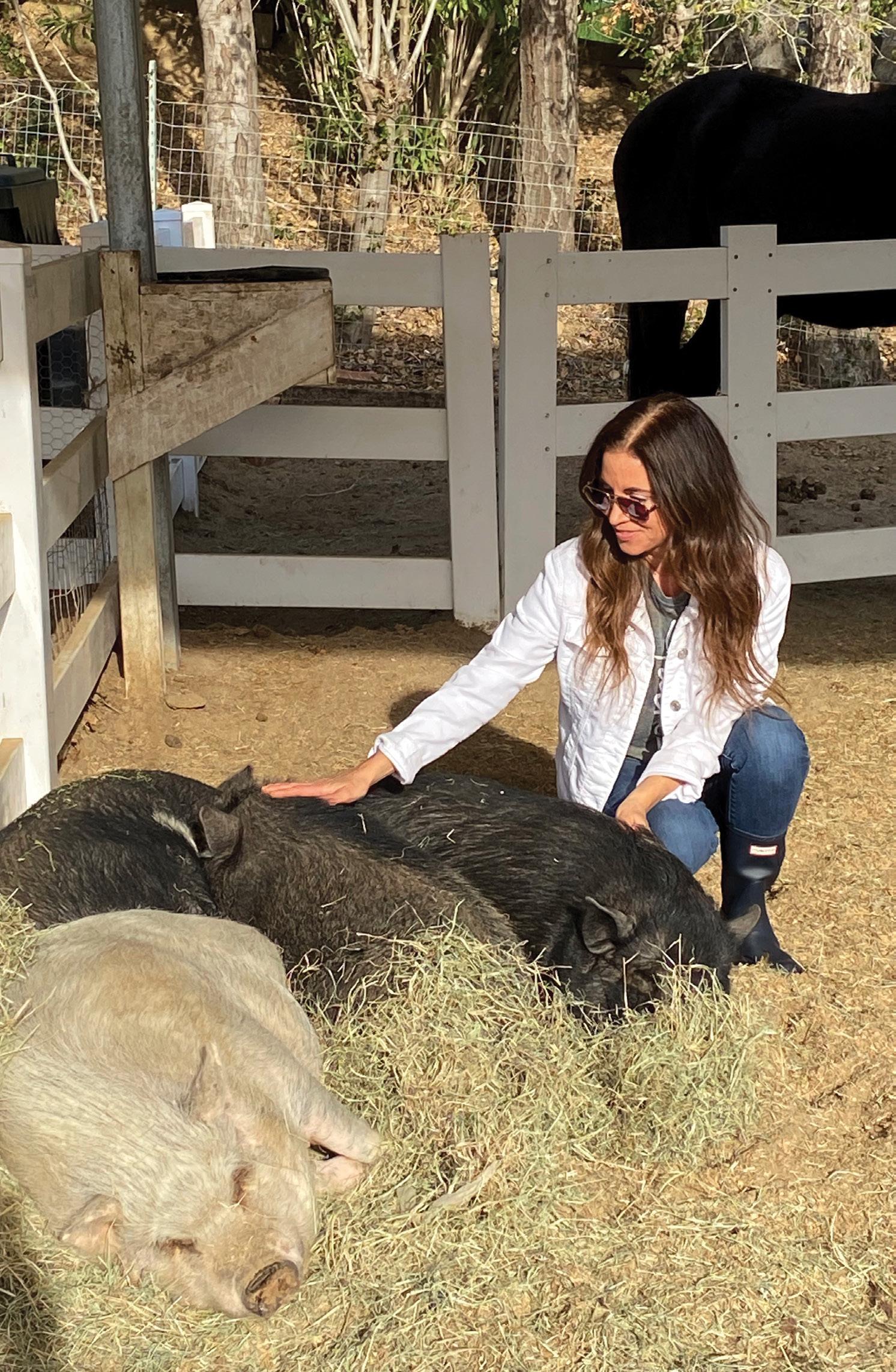
• If I had a second career, it would probably be nutrition-based. It is my most googled subject matter.
• I love to garden (my favorite thing to grow is tomatoes). I take after my Grampy; gardening helps me connect with my memory of him.
• I would love to be stranded on Avery Island with endless bottles of all nine flavors of Tabasco and overflowing bowls of popcorn.
• I am a strong woman of faith and a big God fan.
• I secretly love watching Hallmark movies! So much for the secret.
• My favorite animal is an elephant.
• I have OCD, which is a pain in some ways but can also be a huge benefit when it comes to organiz ing. My pain is my clients’ gain.
• I love fostering dogs and have adopted four of them: Cloee, Hank, Bodhi and Maggie Lew.
• I love to travel and have been to Italy, France, Switzerland, Germany and Belize ... so far.
She ventured into real estate in 2004, first working as an agent with Keller Williams, The Agency and now Compass for the past several years. “I wanted my clients to feel not only safe with me handling one of their
biggest assets, but to feel as little pressure as possible,” she says. “So I naturally became a real estate concierge, so to speak. There aren’t many other businesses out there like this; my concept is unique, though I welcome
“CLIENTS APPRECIATE WHAT I HAVE TO OFFER.”
competition. The more people helping make people’s lives easier, the better for all of us. There is enough to go around.”
A Los Angeles native, Jordan was raised by her single dad and her grandparents. She relocated to the Reno/Tahoe area when she was 7 years old and moved back to LA at age 18. Her family has always meant a lot to her, and she was deeply impacted by the tragic loss of her brother, Joey, who was killed in a car accident in 2003. He was not only her brother but also her best friend.
She has been an animal lover since she was a little girl and loves spending time with her dogs. She volunteers for animal advo cacy groups including the Humane Farming Association, which is dedicated to protecting animals in agriculture; Soi Dog, an organiza tion that travels between Thailand and China to save the lives of street dogs and cats; and John Oberg, a social media animal advocate.
Jordan plans to take an even more active role in rescuing animals in need, with the goal of establishing an educational res cue farm. “Animals are very important in children’s lives,” she says. “I grew up around a lot of animals—I was fortunate. I think it’s important for kids to see that side of life. I also advocate for senior citizens and would love to see this farm as a special place for them to visit.”
Helping reduce stress and enhancing the day-to-day life of others makes Jordan happy—whether for animals, friends or clients. “Moving is very stressful—especially out of state or cross-country,” she says. “I created Reghetti To Move to relieve some of that pressure.”

PROFESSOR JONATHAN KELBER IS MENTORING A TEAM OF CSUN STUDENTS STUDYING HOW AGGRESSIVE CANCERS KILL BY PROLIFERATING THROUGHOUT THE BODY.
Interviewed by Anne M. Russell | Illustrated by Yuiko SuginoCalifornia State University Northridge biology pro fessor Jonathan Kelber, Ph.D., has twice won $1.46 million grants from the National Institutes of Health. “Basically, NIH is saying ‘We like what you’re doing,’” Dr. Kelber explains.
What Dr. Kelber is doing in CSUN’s Developmental Oncogene Laboratory is studying the PEAK1 gene, which likely plays a role in facilitating the growth of cancer cells throughout the body as they disperse from the original tumor. For Dr. Kelber and his team of 13 train ees (undergrads, grad students and postdocs), the $3 million question is: How does that occur on a molecular and cellular level, especially in aggressive, hard-totreat cancers?
The Northridge resident received his undergraduate and master’s degrees at Cal Poly Pomona, and his Ph.D. and
post-doctoral experience at UC San Diego. Dr. Kelber won Fulbright scholarships in 2017 and 2019 and has worked as a visiting professor at Harvard Medical School’s Ludwig Center. He is now in his 10th year at CSUN.
Here we talk with the professor about the research he is spearheading, which he views as his chance to coach and mentor the next generation of scientists.
Why did you focus on the process of metastasis rather than on the origination of cancer?
We are very interested in addressing the issues that cause patient mortality. For solid tumors, what drives patient mortality is the spread of these cancers to distant tissues. Once it has spread, it becomes nearly impossible to treat.
Studying the process of metastasis is, roughly

speaking, a catchall for a lot of the same processes that drive the initiation of the cancer.
Your research centers on breast cancer and pancreatic cancer. Why those two?
By studying certain processes within those two cancer types, we’re studying processes that are relevant to a lot of different cancers.
We’re particularly interested in those minority of cases where breast cancer doesn’t respond to therapy or can’t be surgically removed—the more aggressive types of breast cancer. The majority of pancreatic cancers fall into that class—they aren’t responsive to clinical inter vention, and they progress very rapidly. Often patients are diagnosed late in the disease progression, so it allows us, within two different cancer types, to study similar processes that ultimately contribute to mortality.
How would your research into the PEAK1 gene translate into a real-world therapy?
Translating basic findings to improving patient out comes is a long-game process. It’s on the order of 20 years or so.
With regard to the PEAK1 gene and the protein prod uct of that gene, we’re still very early in that transla tion effort. But we know PEAK1 does have some enzy matic activity. Most reports suggest that when PEAK1 is active in that way, it exacerbates cancer progression. So we could envision developing antagonists that might inhibit or suppress that enzymatic activity.
The second way is understanding what events lie upstream or downstream of PEAK1. What turns on PEAK1 gene expression? What turns on PEAK1 activity? Or when PEAK1 is active, what else gets turned on? Our lab is looking right now at upstream events that we can target to ultimately inhibit the production of PEAK1.
What do you think the future direction of cancer treatment will be—is it DNA editing? Immune therapy? I think the future will lie in trying to understand the specific needs of patients themselves—delivering
personalized or precision therapies. That involves tar geted approaches: immune therapy or small-molecule therapy or antibody therapy, along with more tradition al chemotherapies that don’t have cancer-specific tar gets but tend to target cells that are highly proliferative.
We’re getting to the point where we can evaluate what is best for a specific patient almost in real time. With patient biopsies in the laboratory, we can know within a few weeks what that patient’s cancer will respond to. It won’t be a one-size-fits-all approach. It will be: What is best for patient X? What is best for patient Y? And developing a combination approach that is tailored to their disease.
What do you wish that nonscientists understood better about cancer?
There are cancers like cancers of the breast, the skin, and of the lower GI tract that have exceptional screen ing approaches. For women, that’s mammograms. For all people, colonoscopies. I think they’re underutilized by the general public. These diagnostic measures are really important.
Is it realistic to hope that in the future no one will get cancer?
No. Cancer is generally a disease of aging. Our cells age and certain environmental influences like UV light cause those processes to speed up, and essentially the DNA gets damaged. I suspect we won’t eradicate the incidence of cancer.
But I also think that treating cancers with a more personalized approach may drastically improve out comes over the next decade or three or four decades. We may, in some cases, be seeing cancers that are com pletely curable from a post-diagnosis stage through the end of the patient’s lifetime so that they begin dying of other causes. I don’t think we’re going to cure death. But it would be preferable that people have high quality of life in their end stages. Unfortunately, cancer is a really tragic way of dying. ■
Golf is a stuffy old game, as everyone knows, with arcane sartorial requirements and entrenched etiquette that proscribes boisterous laughter, loud music or any behavior that might distract from the task of hitting a tiny, dimpled ball. Did we mention that it’s kind of slow?
Enter Topgolf. Exit stuffiness.
Topgolf is a driving range for the digital age, where golf meets sports bar meets video arcade meets let’sget-outta-the-office and have some fun. The first LAarea version recently opened in El Segundo, and sure, there’s a 102-bay driving range where you can hone your swing. But that’s where the similarity to anything familiar ends.
The range is arrayed with targets both drivable and chippable, while your tee is perched on a swath of artificial turf bordered by a video console that spits out your ball and then proceeds to record your swing in detail. Actually, what it records is the flight of your shot and all concomitant details, promptly replayed to your chagrin and the delight of your pals.
Topgolf treats your pathetic 90-yard shank with all the respect of CBS covering Tiger in Augusta. You get to see the mighty arc of your ball’s flight and its subsequent landing, replete with stats such as ball speed, carry, total distance, hang time and height—all in embarrass ing detail.
In a basic Topgolf game, you score points for dis tance and accuracy, and, of course, a leaderboard is
prominently displayed. You can play any number of other digitally enhanced games, from a links version of Angry Birds to virtual-reality rounds at St Andrews or Pebble Beach.
The bays are arrayed in an arc high above the range surface on three levels. Six can play at a time at rates that range from $55 to $75 an hour for the whole group.
Hungry? Of course you are. Bar snacks, burgers, munchies, sandwiches, salads, flatbreads and drinks are delivered to your bayside table. Or you can wander off and order your own, in which case you might get dis tracted by a giant video monitor the size of a drive-in movie screen showing whatever sport is in season.
Never swung a club before? Doesn’t matter.
“There are barriers to entry in traditional golf,” says Topgolf real estate director Tanner Micheli. “We want to make the game unintimidating to eliminate those barriers.”
Peter Bowman, director of operations for El Segundo, echoes that. “At a normal facility, someone trying to learn is stressed and nervous,” he points out. “We throw that out the window. Anyone can play here.”
That’s further endorsed in the broader golf com munity. Phil Lopez, general manager of El Caballero Country Club in Tarzana, says, “I love Topgolf. It’s a ton of fun. More fun is good for the game, good for business all around. It’ll expose more people to golf and show them that it’s not only for elitist rich people.”
Do some golfers miss just quietly hitting a bucket of balls? Maybe. But it’s pretty compelling to head out

with pals and/or workmates for team building or party ing. SpaceX has booked several times. Paul George held a birthday party there. Justin Herbert from the Chargers has dropped by.
The advent of Topgolf shouldn’t overshadow the course it’s attached to: The Lakes at El Segundo. The pairing is the first of its kind; normally Topgolf is a stand-alone operation. When Topgolf waltzed in to El Segundo, it dangled what it thought was a win-win-win for the city, for traditional golfers and for itself: a total overhaul of The Lakes. But it was a nine-year journey for Topgolf to secure all the necessary local approvals. Plenty of naysayers were concerned that the Topgolfication of an old-favorite course would spell its demise.

“Credit the local golf community,” says Craig Kessler, public affairs director of the Southern California Golf Association. “They insisted that Topgolf be faithful to their message that they’re into the game of golf and committed to growing it.”
Hence arose an agreement to not only build a $40
million driving range but to overhaul The Lakes and contribute $1.9 million annually to the city’s general fund. And to retain the course’s exemplary junior pro gram. Peter Bowman points out that Topgolf has also created 500 new local jobs.
The rehab of the course comprised extensive land scaping while keeping the course’s signature tall trees. Bunkers were reshaped and refreshed with new sand, and once-bumpy greens were retailored with new bent grass. The clubhouse and retail shop are new and truly lovely.
Was the course Topgolfified? Sure, to an extent. But no one’s complaining about new lights and night golf till 11 p.m., or the music spilling out across the fairways from judiciously spaced speakers.
The 9-hole Lakes course actually has a 10th hole. You’re on camera when you play it, as a huge ban ner on the backside of a giant screen proclaims: “JUST
FYI—EVERYONE IS WATCHING.” Meaning the crowd up in the Topgolf bays can see see you and snigger at your pathetic drive off the tee. More likely, though, they’re focused on their own intense game of Angry Birds. They’re thoroughly Topgolfified. ■



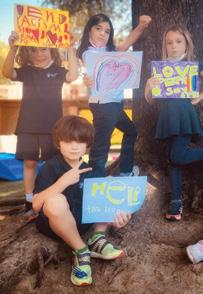
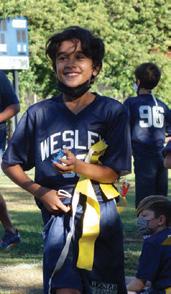




Orthopedic surgeon Dr. Nirav Shah gets patients back to the activities they love.
WRITTEN BY LAURA L. WATTS | PHOTOGRAPHED BY TAMEKA JACOBSIt can impact anyone—from the most sedentary to the most athletic. Millions of Americans of all ages suffer from knee pain. Perhaps they have trouble standing up or climbing a flight of stairs—or even sit ting in a low chair. Maybe they’re no longer able to enjoy their favorite activity like golf, surfing or jogging.
If you’re one of the millions of Americans of all ages suffering from knee pain—whether from injury, overuse or arthritis—you know how much it can impact your life and even your emotional state. If this common condi tion is not responding to home remedies, you may be a candidate for robotic joint replace ment surgery.
Doctors have been performing knee replacements since the 1960s, and the technologies and techniques involved keep getting better. This surgery is performed about 800,000 times annually in the United States alone, and that figure increases every year.
A robotic knee replacement is similar to a traditional knee replacement. Your surgeon removes damaged tissue in your knee and replaces it with an artificial joint. The dif ference is the method of surgery. Roboticassisted procedures allow for greater preci sion, are safer and less painful, and can lead to shorter recovery times and better results.
While state-of-the-art robotic instruments have the potential to improve the outcome for patients, you still want to choose a highly experienced orthopedic surgeon. The results
will only be as good as the surgeon perform ing the procedure.
Nirav J. Shah, MD, a board-certified orthopedic surgeon with Providence CedarsSinai Tarzana Medical Center, performs 400 total joint replacement procedures per year. Trained as a biomechanical engineer at Columbia University in New York City, he relocated to Los Angeles for medical school and joined Providence Center for Orthopedic Specialists in 2014. He lives in Tarzana with his wife and two children and enjoys the active Southern California lifestyle.
“When I explored my various career oppor tunities,” Dr. Shah shares, “I asked myself how I could best utilize my experience as a biome chanical engineer as well as give patients the most direct route to recovery. Orthopedics pro vided me the opportunity to utilize my knowl edge of biomechanics to help my patients.”
Specializing in minimally invasive tech niques, Dr. Shah uses the most advanced technology in each surgery he performs— including the ROSA® Knee robot. While the surgery remains in Dr. Shah’s skilled hands, the robotic assistant ensures that the mea surements and bone cuts are appropriate for each patient’s unique anatomy. Providence Cedars-Sinai Tarzana Medical Center chose to invest in the ROSA system to offer patients several advantages over other systems.
Dr. Shah strives to restore each patient’s lifestyle. “Orthopedic surgery is a field where, once recovery is complete, the patient gets
their quality of life restored,” he points out. “I do not have to rely on medication to improve my patient; I get to do it with my own hands.”
The doctor and his team provide a com fortable environment where patients and their families can get answers to all of their questions. A collaborative effort results in an individualized treatment plan for each person.
“I want patients to understand the pro cedure they are about to undergo on their body,” says Dr. Shah. “I have a very friendly style that makes patients and their families feel comfortable asking questions and that we are a team.”
The knee is a hardworking joint that depends on a well-tuned system of bones, ligaments, cartilage, muscles and nerves. If your continuous pain is adversely affecting your quality of life, make an appointment to speak with Dr. Shah and his team.
“The most rewarding part of my job is when a patient who was in immense pain prior to surgery tells me after surgery that they have their life back,” he says. “Nothing is more important than that.”
TARZANA MEDICAL CENTER
NIRAV J. SHAH, MD
18321 CLARK ST., TARZANA 818-881-0800
PROVIDENCECEDARS-SINAITARZANA.ORG
FB: @PROVIDENCETARZANA
IG: @PROVIDENCECALIFORNIA
WITH THE POPULARITY OF PICKLEBALL SKYROCKETING, THE VALLEY’S FIRST DEDICATED STORE, THE PICKLEBALL EXCHANGE, IS A BUSTLING SCENE.
Written by Chelsee Lowe | Photographed by Shane O’DonnellIt may have a somewhat silly name, but its players are serious. A mash-up of Ping-Pong, tennis and bad minton, pickleball involves hitting a perforated plastic ball—much like a Wiffle ball—with a paddle over a net. The game is typically played as doubles on what looks like a mini tennis court. Its early popularity was among middle-agers and elders, but during the pandemic, pickleball popularity moved from cult following to mainstream, appealing to all ages. With an estimated 5 million players, it is now considered one of the fastestgrowing sports in the United States.
The sport crept up on Pickleball Exchange owner Joey But. After watching a couple of kids smack a ball around at the Van Nuys/Sherman Oaks Recreation Center, he set up a pickleball net inside his soon-to-debut racket store in Encino. As a former competitive tennis player, he intended to carry mostly tennis gear in the shop. He got two paddles, hit a ball around with his wife—who is “not a sports enthusiast”—and was further intrigued. When his usually stoic parents also enjoyed themselves on the indoor court, he had a gut feeling: the focus of his new store should switch to pickleball.
He says players tend to catch on quickly.
“It’s so satisfying for a player to have a long rally, but it can take years in tennis (to reach that level). With pickleball, it takes minutes,” notes Joey.
The low net makes rallying easier, and the smaller court size requires less running. Many longtime tennis players who have suffered injuries have moved to pick leball. But for most players, it is just plain old fun.
“I love tennis still, but I’m now obsessed with pickleball—the excitement of the speed-ups and the volleys,” Joey says.
The Pickleball Exchange, which opened in May, is
stocked with a wide variety of paddles including a top-of-the-line $210 version by Engage for players who want a powerful swing. Shelves stocked with balls, court shoes, activewear (FILA is now manufacturing pickleball duds) and bags line nearly every wall. The staff is available to play games with customers so they can test paddles.
“Come on in—even give us a call so we know when you’re coming so you won’t have to wait—and we’ll put different options in your hand and hit some balls,” Joey says. “Some paddles have more power, some have more spin. We will help you navigate all of it.” ■
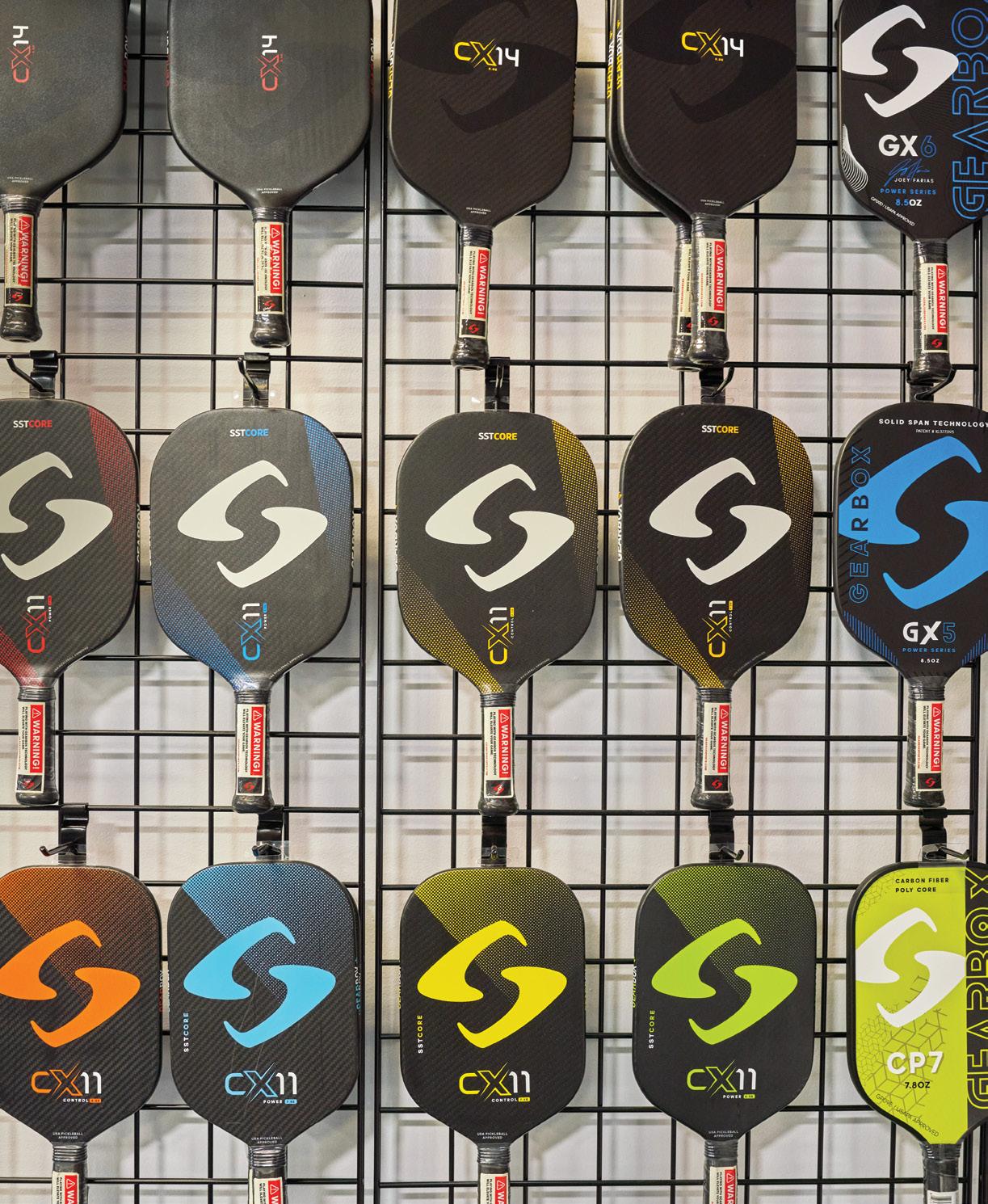


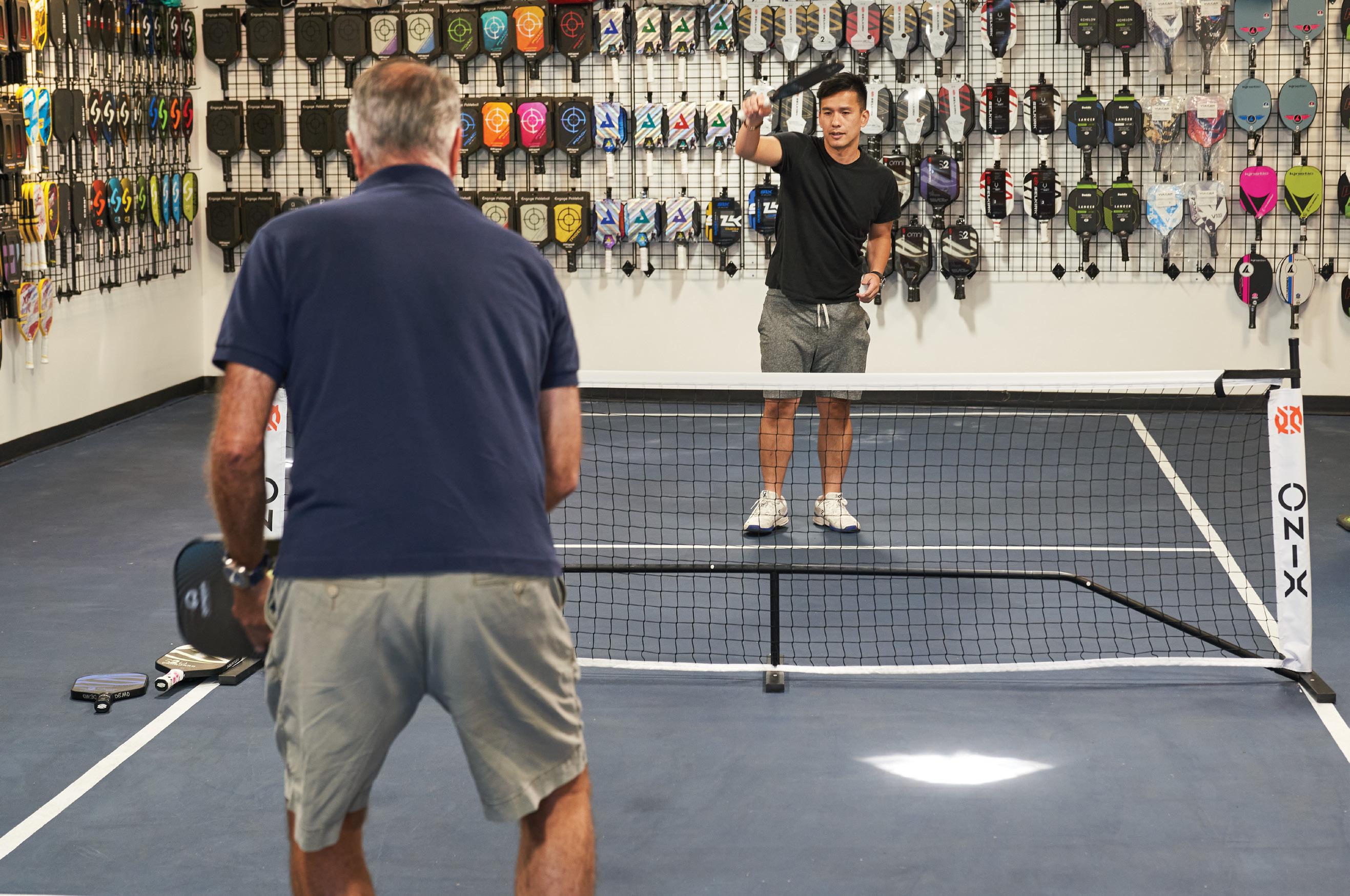
Chatsworth Recreation Center
Encino Recreation Center
Granada Hills Recreation Center
Larry Maxam Park (Burbank)
Van Nuys Sherman Oaks Recreation Center
Woodland Hills Recreation Center
Pickleball Exchange owner Joey But helps a customer try out paddles on the store’s court. Below: Joey strings a tennis racquet.What’s in a name? When it comes to street monikers, a lot. Many of our avenues and boulevards recognize not only our nation’s founding mothers and fathers, but also the pioneers and innovators who made our communities what they are today. Think Van Nuys, Sepulveda, Oxnard, Fulton and Hazeltine, to name but a few. However, for me, one stands out from the pack. Located in north Sherman Oaks between Ethel and Tyrone Avenues, Chandler Boulevard stretches like a lush oasis. The lots are huge—even by Valley stan dards—many boasting elegant and expansive homes.
The extra-wide traffic lanes are graced by a rare grassy medium adorned by soaring, mature-growth trees, the majority of which are stately pines.
The boulevard was named after Harry Chandler, a New Hampshire native who landed here somewhat serendipitously. While attending Dartmouth College in the 1880s, Chandler, on a dare, jumped into a vat of frozen starch, because … why not? That act of folly led to severe pneumonia. When his doctors advised a trip west to recuperate, he didn’t hesitate.
Chandler found a job in the San Fernando Valley fruit fields and soon fell in love with his new hometown. After starting a small delivery service that became the delivery means for the Los Angeles Times, Chandler caught the eye of the newspaper’s publisher, Harrison Grey Otis. Impressed with the young man’s entre preneurial verve, Otis took Chandler under his wing. Chandler went on to become the paper’s circulation manager—and to marry one of the boss’s daugh ters, Marian Otis. Ultimately Chandler became pub lisher of The Times and transformed it into the leading
newspaper in the West.
He later branched out into community building and large-scale real estate speculation. Chandler helped found the LA Aqueduct, the LA Coliseum, the Port of Los Angeles, the Biltmore Hotel, the Hollywood Bowl, Trans World Airlines (TWA), the Santa Anita Park race track and the Douglas Aircraft Company, among dozens of other companies. He was a partner in syndicates that owned and developed Mulholland Drive, much of Dana Point, and Tejon Ranch. At one point, Chandler was considered the largest private landowner in the U.S.
For six blocks, the street named after him cuts through the majestic Chandler Estates neighborhood. Chandler Estates was originally part of Van Nuys. But in 1991, a group of homeowners successfully petitioned the city council to have the boundaries of Sherman Oaks redrawn from Magnolia to Burbank Boulevard to the north, and from Coldwater Canyon to Van Nuys Boulevard to the west, with the goal of including their neighborhood. The residents argued that the area was originally part of Sherman Oaks, but got labeled Van Nuys through the creation of zip codes in 1962. The pe tition was granted, and Chandler Estates was officially recognized as part of Sherman Oaks.
Most of the original homes in Chandler Estates were built in the 1940s and ’50s, and some remain intact. In recent years, though, the neighborhood has seen a spate of renovations and new builds. Younger families are moving in, attracted to the large, flat backyards and proximity to some of LA’s best private schools. But remarkably, the character of the neighborhood has been preserved—much like the legacy of its namesake.

A winter wonderland awaits inside the doors of Aldik Home.

More than ever before, the magic of Christmas is a welcome relief. If you didn’t already know that there is a full-blown winter wonderland right here in Los Angeles, you have certainly been miss ing out. For nearly 70 years, Aldik Home has been putting together jaw-dropping displays of some of the most beautiful Christmas décor in the world. Each year brings a com pletely new design, and this just may be the best yet!
There are thousands of unique ornaments, twinkling lights, spools of luxurious ribbon and so much more around every corner. There are Santas, angels, glittery stems and even an overhead light display! People often describe Aldik Home as a Disneyland for Christmas—but without that admission fee and the throngs of people.
It’s impossible not to be in awe as you
stroll through this enchanted forest of delightful décor, but truly the most breath taking aspect from this entire display is the trees themselves. Every size and style of artificial Christmas tree—more than 60 total—can be found in Aldik Home’s expan sive indoor Tree Lot.


The crown jewel of the Tree Lot is the col lection of AH Gold Label Trees, which are quite simply the best artificial Christmas trees. Exponentially better than any tree you’ll find at online retailers, AH Gold Label Trees repre sent the gold standard. Expertly designed to be more realistic, longer lasting and featuring the most advanced lighting systems, these are simply the most stunning Christmas trees you have ever laid eyes upon. Don’t make a mistake and order something online that you’ll regret when you can see the world’s best trees with your own eyes.
It’s never been more important to
experience the magic of Christmas at the most incredible Christmas display in the country. When it comes to Christmas decor, lights and especially trees, there’s no place like Aldik Home!



ALDIK HOME
7651 SEPULVEDA BLVD., VAN NUYS 818-988-5970
ALDIKHOME.COM

“IT’S NEVER BEEN MORE IMPORTANT TO EXPERIENCE THE MAGIC OF CHRISTMAS.”











Bet you’ve never had bar food this gourmet before. For more, turn the page.

TV WRITER JEFF STRAUSS IS GETTING ACCOLADES FOR HIS CULINARY CREATIONS AT OYBAR IN STUDIO CITY. BUT FOR THIS ENDEAVOR, HE’S SHARING CREDIT WITH HIS MOM.
Written by Joshua Lurie | Photographed by Shane O’Donnell
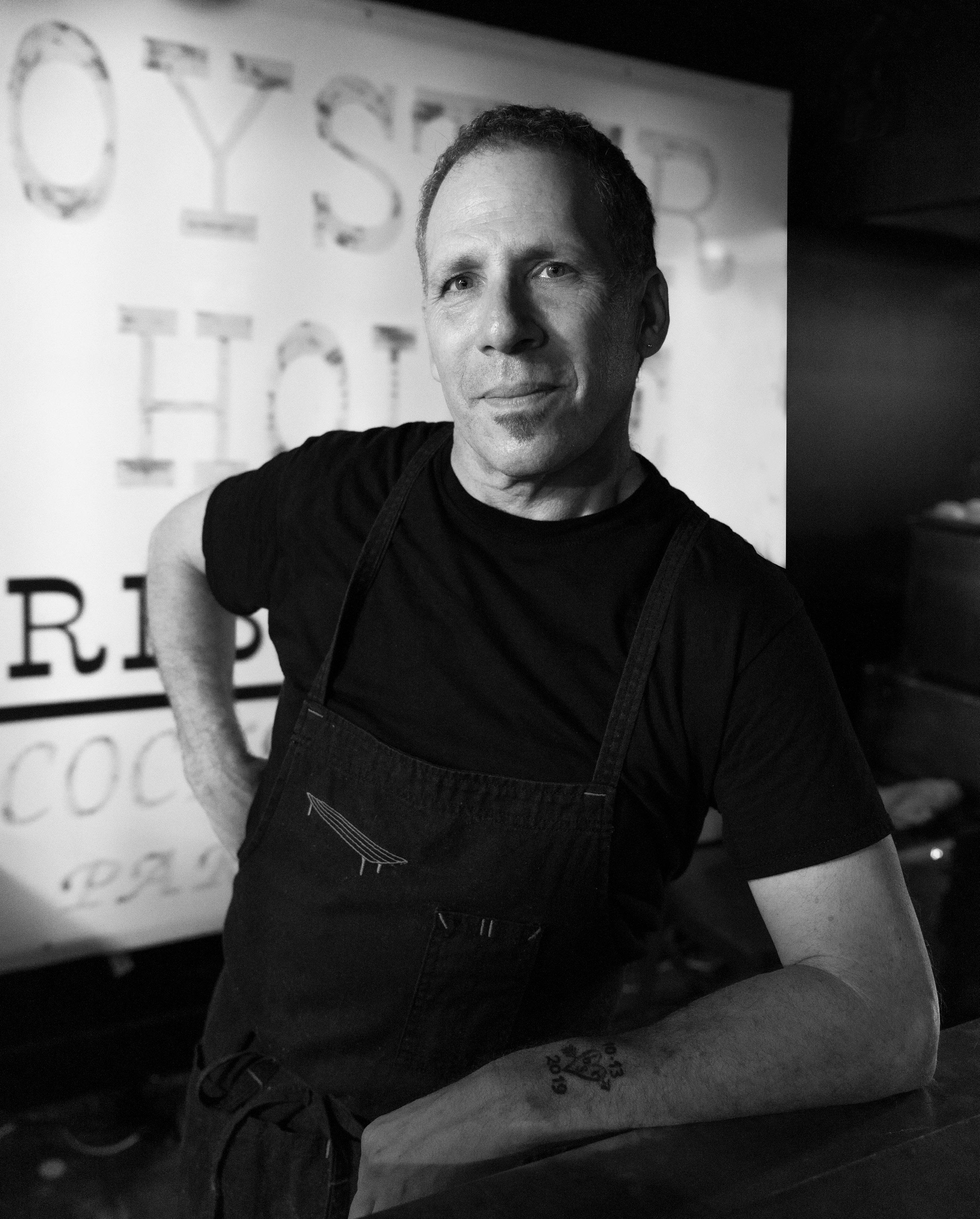
The OyBar space, with its original 1950s style bar.

Clockwise: chef de cuisine Kenya Bovey; smoked salmon yaki onigiri with red onion and crème fraiche; a cocktail with mezcal, Mexican rum, homemade grapefruit cordial and lime juice.



Jeff made a name for himself by writing on shows like Friends and Dream On, but after 30 years in the enter tainment industry, he decided to pursue his second passion—cooking “I did briefly think about cooking professionally in my 20s,” Jeff says. “Instead I cooked for friends and family and occasionally catered a school fundraiser or helped a friend throw a large party.”
In late 2018, “coming off a job on a TV series with all the usual joys and frustrations,” he mulled next steps. “My wife, Mindy Schultheis, said, ‘You know, if you’re ever going to do anything with cooking, you should probably try and do it while you can still stand up!’ Our kids were all out of school, or nearly, and we didn’t need my income to pay the mortgage, so the opportu nity to take a risk seemed ripe.”
In 2019, he worked stages—unpaid internships, essentially—at chef-friends’ restaurants and began catering for friends, calling his new business Jeff’s Table. Around that time, a friend introduced him to Peter Jarjour, owner of The Bar at Oyster House in Studio City, a neighborhood haunt known for its cock tails. Since the bar had a limited menu, they gave Jeff an opportunity to host pop-ups there. Impressed, Peter offered him a full-fledged opportunity: Run a small gourmet sandwich shop in the back of Flask Fine Wine & Whisky, his Highland Park liquor store. Carrying over the name Jeff’s Table made perfect sense.
During the pandemic, Jeff lost access to his com missary kitchen where he prepared food. Since The Bar at Oyster House was closed due to COVID-19 restric tions, he started prepping there for Jeff’s Table. Once LA County lifted restrictions, he proposed flipping the
business into OyBar, a nighttime concept with elevated bar food that draws on Jeff’s family traditions and in ternational influences.
“I wanted to do something that reflected my roots,” he says. “So some Jewish deli East Coasty stuff, but also Los Angeles. There’s so much food in the city that reflects these cross-cultural experiences.” To work alongside him at OyBar, Jeff hired chef de cuisine Kenya Bovey, who had experience working for chefs including Suzanne Goin and Nancy Silverton, and sous chef/pastry chef Alex Madayag. And then it clicked.
“There were a couple of pieces that Eater did and then website The Infatuation named us best LA burger, and more people started coming,” Jeff says. Thursday through Saturday, on most nights, the line starts form ing out front before 6 o’clock (no reservations accepted).
Jeff credits his mother, Jane, as his biggest culinary influence. “My mom taught me to cook,” he wrote on an Instagram post. “And to think about what I was eating and the flavors and textures. She taught me that food was culture and communication. She taught me to be fearless in eating and in cooking and that feeding someone is an act of love and that eating with someone is an act of community.”
Jeff was raised, with sister Sarah, in several East Coast cities, including Boston, Rochester and Washington, D.C. His dad would barbecue and help cook fish they caught while camping, but Mom, a Massachusetts native, made most meals.
In the ’60s, “when most women were cooking either from convenience and simplicity” in the frozen dinner era, she scoured magazines, newspapers and cook books for international recipes like sukiyaki or hot and sour soup. “I was one of those kids who grew up not knowing that Chinese food wasn’t part of the Jewish traditional diet,” Jeff jokes.
Jane had signature dishes like hamburger soup and crisp, toasty chicken wings coated with sesame seeds and served with tangy orange sauce or tossed in lemon juice, soy sauce and ketchup. Jeff also recalls broiled
At first glance, it might not seem like TV writing and helming a restaurant have much in common. “But they do,” explains Jeff Strauss. “In both cases you are putting on a show for an audience each night.”
chicken, lamb chops and steak, trout almondine, and “fresh green salad with homemade dressing.” She drew from the Jewish canon for holidays, including matzo ball soup, kugel and sticky braised brisket. Her willing ness to go off-recipe to suit her mood was an approach that influenced Jeff’s cooking.
Looking back, Jeff’s becoming a chef may have been inevitable. “He was not quite 4 years old and we had gotten him a goldfish,” his mother recalls. “It lived for a few weeks, and then died. I was really worried about telling Jeff the news and having to explain to this little boy what had happened, and what death was. I put it off as long as I could, but I finally had to do it. I sat him down and told him. And Jeff took it in, and he looked at me with his big brown eyes and asked, ‘So can we eat it now?’”
“The first time my mom suggested that I pick up a spatula or pan was when I was 6 or 7 years old,” Jeff recalls. “I didn’t like what she was making for dinner. She said, ‘Make something yourself. Make yourself some eggs.’ She showed me how to crack eggs into a bowl and scramble them up and put them in a pan with some but ter and stir. It was this really empowering feeling to be able to control a hot dish that I ate and enjoyed.”
Jeff’s mother is now 83 and lives in Connecticut. She visited in July and tried her son’s latest creations. “Her being here and getting to go to these things was really meaningful in a ton of ways,” he says.
She recently savored OyBar’s entire menu during a group dinner, including a pastrami quesadilla with crispy Gruyere-and-jalapeño crust, a combo play on his signature Jeff’s Table sandwich and LA street burritos.

“Certain dishes absolutely come deeply from my mother’s roots,” Jeff says. OyBar’s fiery habanero honey hot wings certainly qualify. So does matzo ball ramen.
Mom also appreciated smoked salmon yaki onigiri, a riff on lox and cream cheese that features a grilled Japanese rice ball topped with silky salmon, crème fraîche, red onion, dill, and miso butter, coated with an everything spice that includes caraway and toasted nigella
“MY MOM TAUGHT ME TO COOK AND TO THINK ABOUT WHAT I WAS EATING AND THE FLAVORS AND TEXTURES. SHE TAUGHT ME TO BE FEARLESS IN EATING AND IN COOKING AND THAT FEEDING SOMEONE IS AN ACT OF LOVE AND THAT EATING WITH SOMEONE IS AN ACT OF COMMUNITY.”
seeds. Her influence was evident throughout the meal.
Mom’s commitment to sharing food with family and community has also left a lasting impression. Jeff remembers potluck dinners in Rochester, where he found inspiration from nearby farmstands, local legend Wegmans supermarket, and Mr. Courtney, a neighbor who farmed a full acre and would let Jeff and his sister pick apples and berries.
During our interview, a passerby addressed Jeff as “chef.”
“I still wonder who they’re talking to,” says Jeff, half jokingly. “It’s been hard for me to get used to being OK with that. I mean, that’s what I’m doing, but for a long time, as I would joke with Kenya—who has a lot more professional culinary time than I do—I was Jeff, not chef.”
Although fully immersed in food, Jeff hasn’t closed the door on the entertainment industry. “I’m not writing, but I’m never not a writer,” he says. So Jeff remains a storyteller. “I like food that tells stories,” he says. “I like surprising twists, things that make you smile, and things that make you think of things from your past or present that are either fun or awkward or funny.” ■
(makes about 1 cup)
This cucumber dish is great for eating alone, or on burgers and sandwiches. “It’s really a slightly sweet, slightly salty cucumber salad pretending to be a pickle. While nothing matches the wonder of a truly great, traditionally fermented deli pickle, the freshness brings a playful flavor that out-competes many bottled/store-bought pickles,” Jeff says.
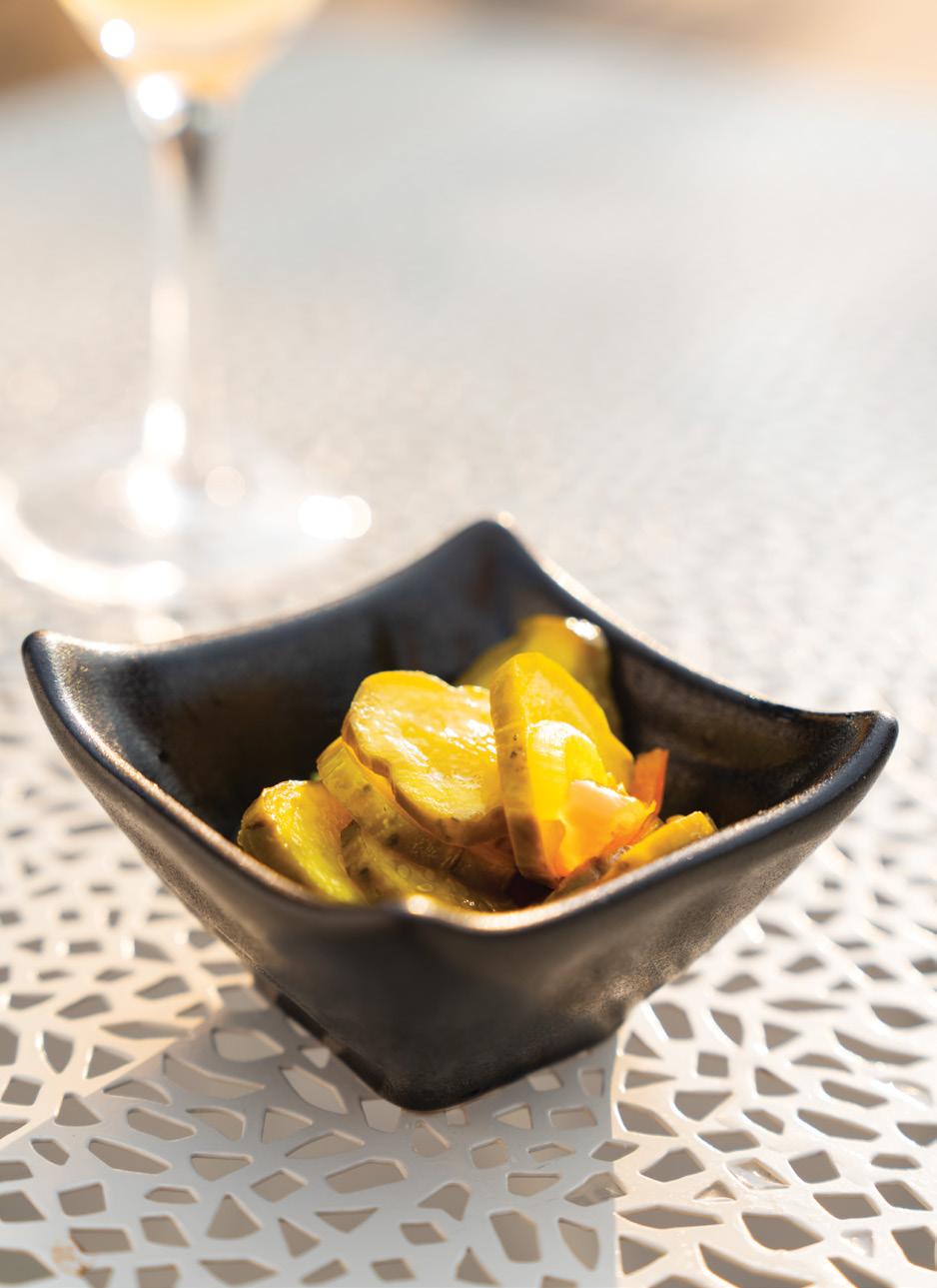
4 Persian cucumbers, medium large 2 teaspoons sugar 1 teaspoon salt
1 large clove of garlic grated on a microplane or finely minced 1 tablespoon minced fresh dill
Slice off ends of cucumbers; then slice them into roughly 1/8-inch-thick rounds. Make them look like sliced pickles, or just slightly thicker. Combine these with the other ingredients in a nonreactive bowl and stir gently once or twice over 10 minutes. Serve immediately, or refrigerate to use within a few hours.

CHEF MARK OKUDA DRAWS ON YEARS OF EXPERIENCE AND HIS OWN UNIQUE VISION TO TRANSFORM THE BROTHERS SUSHI INTO A BUSTLING, INNOVATIVE HUB THAT AIMS TO DELIGHT—AND SURPRISE—DINERS.
Written by Dakota KimWhen Valley native Mark Okuda saw the sushi masters who were his mentors retiring, he worried that the traditions they guarded would die with them. Carrying on what they taught him, he now hopes to nurture the next generation of chefs at The Brothers Sushi in Woodland Hills, which he purchased in 2018. It had operated under the same owner for 36 years.
From the playful street-art mural outside to the low-key Japanese hip-hop on rotation, it’s clear that Brothers is a cool spot for both the hip younger clien tele and no-fuss sushi lovers alike. Mark, who previ ously was a sushi chef at Michelin-starred Asanebo in Studio City, has transformed what was once a popular roll house that catered primarily to a West Valley crowd into an epicenter of culinary innovation.
Mark’s first big moves were physical. He more than doubled the ceiling height from 10 to 25 feet and added recessed lighting and three slanted skylights for a modern feel. For the sushi bar, he replaced an ancient, rusty display structure with a beautiful pressed-cedar countertop. Realizing the need for outdoor, distanced seating, he broke ground on a new patio with a retract able roof and cooling misters in June 2020, completing it just in time for a sweltering August. And just in time for a protracted COVID shutdown.
“Not only did I have to support my family, but my employee family as well,” Mark recalls. “We originally heard the lockdown would be only two weeks, so we didn’t think much of it.” As time passed, Mark realized Brothers needed to switch gears to takeout. “Menu
items like the hand-roll kits and chirashi bowls saved our business,” he says.
Mid-pandemic, Brothers found solid footing in the neighborhood, reopening to a packed dining room and newly distanced diners on a twinkling patio.
Mark may have been destined for the sushi business. His mother was a server in a Japanese restaurant for more than 30 years, and he started busing tables at age 16. One day when he was 19, the kitchen needed help, so he started cleaning fish. “I really enjoyed what I was doing, and it became a career,” he says. “I always wanted a restaurant in the Valley, and I eyed this loca tion for a long time, until the gentleman who owned it decided to retire.”
Mark is proud that the diners at Brothers are so diverse. “We have everyone pulling up, from Civics to Rolls Royces and Ferraris.” Lately he’s noticed the trend of more young groups of friends from Calabasas and Hidden Hills visiting his restaurant, along with the traditional clientele of couples on dates, work col leagues and local families.
The modern, bright dining room at the Woodland Hills location serves seasonal sushi, which Mark sources according to what region is offering the most exciting catch. That means the menu varies wildly— from a light, flavorful hikarimono silverskin fish in the spring to a whole Hokkaido hairy crab with Astrea Caviar in the summer. In the fall there’s a persimmon salad with salmon tartare and matsutake tempura with sudachi lime.
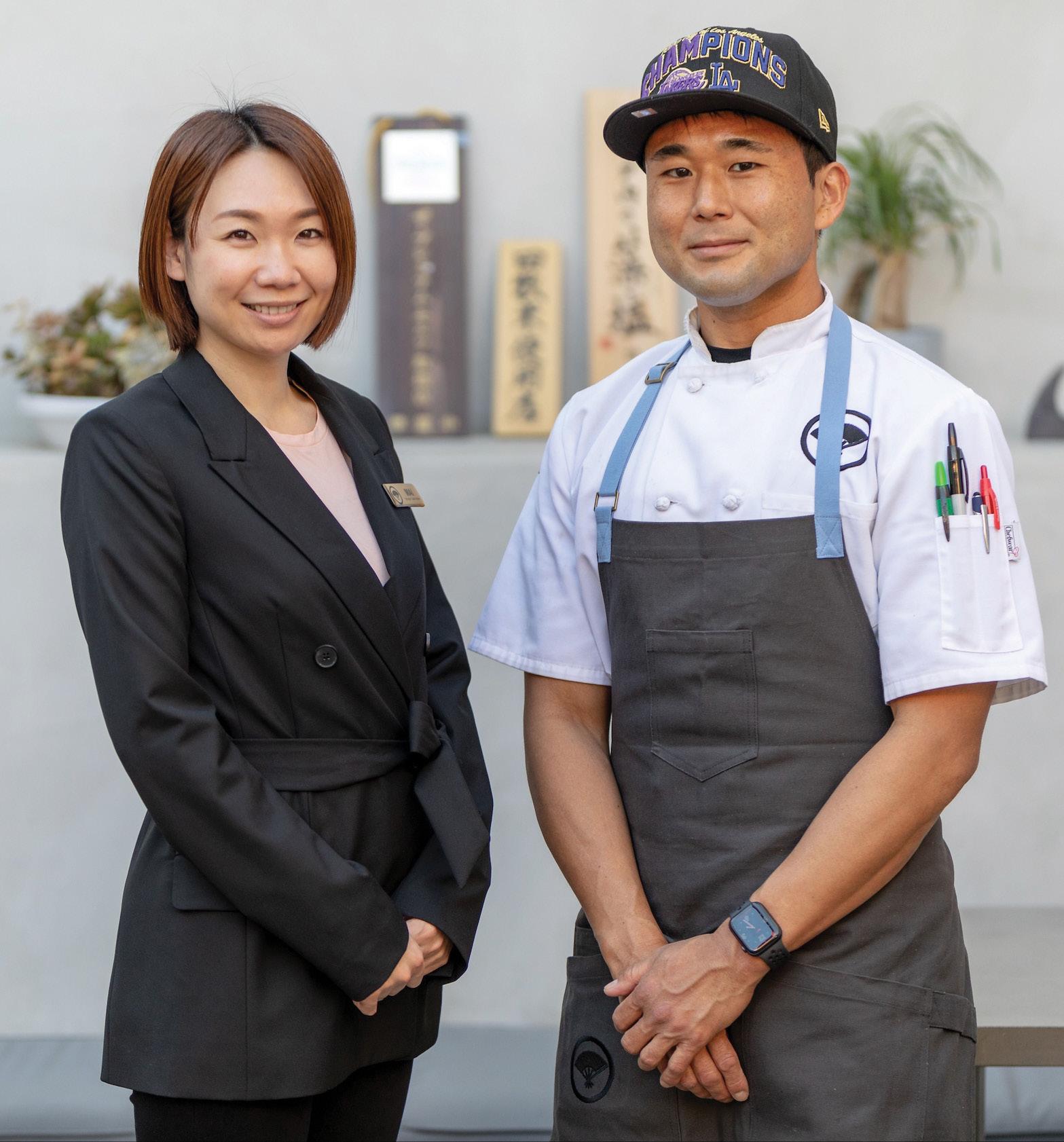

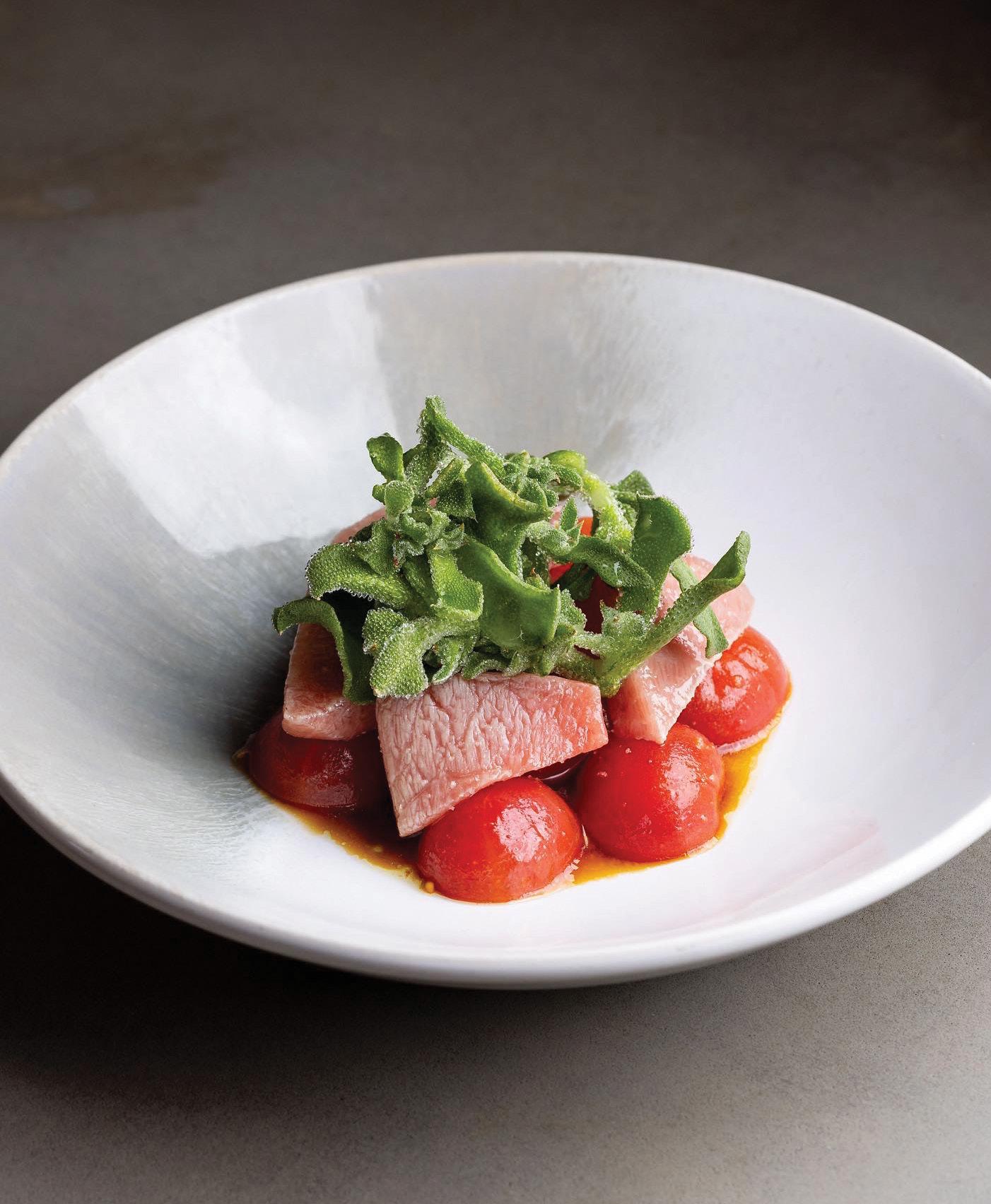 Brothers Sushi manager Mai Tominaga and owner Mark Okuda
Brothers Sushi manager Mai Tominaga and owner Mark Okuda
Whatever the season, Mark’s menu always includes dry-aged fish done in-house, a popular trend that al lows chefs to concentrate flavor by removing excess moisture from the cut. “Dry-aging takes away that slippery texture by removing the water content from the fish,” Mark explains. “What’s left is a really nice, clean, concentrated flavor.”
The fattier the fish, the longer you can dry-age. For many fish, it’s three to four weeks, but for a king salmon from New Zealand, Mark likes to age for two weeks. For a whitefish, it wouldn’t be more than five weeks. “You want that nice aged flavor you get from aged beef, but from salmon,” he says.
Guests keep coming back for Mark’s perfectly aged fish, including the dry-aged kanpachi with amberjack on a sesame miso base, and seared dry-aged toro with pickled, wasabi-marinated ice plant, a beachside suc culent. The latter is accompanied by a soy citrus tomato medley that alternates between Japanese Momotaro tomatoes from the farmers market, and purple and green “Acid Trip” tomatoes from Girl & Dug Farm. “It’s savory, succulent, tart, fatty, bright—all the ingredients make a really delicious combo,” the chef says.
With its $200 omakase (includes appetizers, sushi and soup), $140 sushi omakase, superior sake, fun
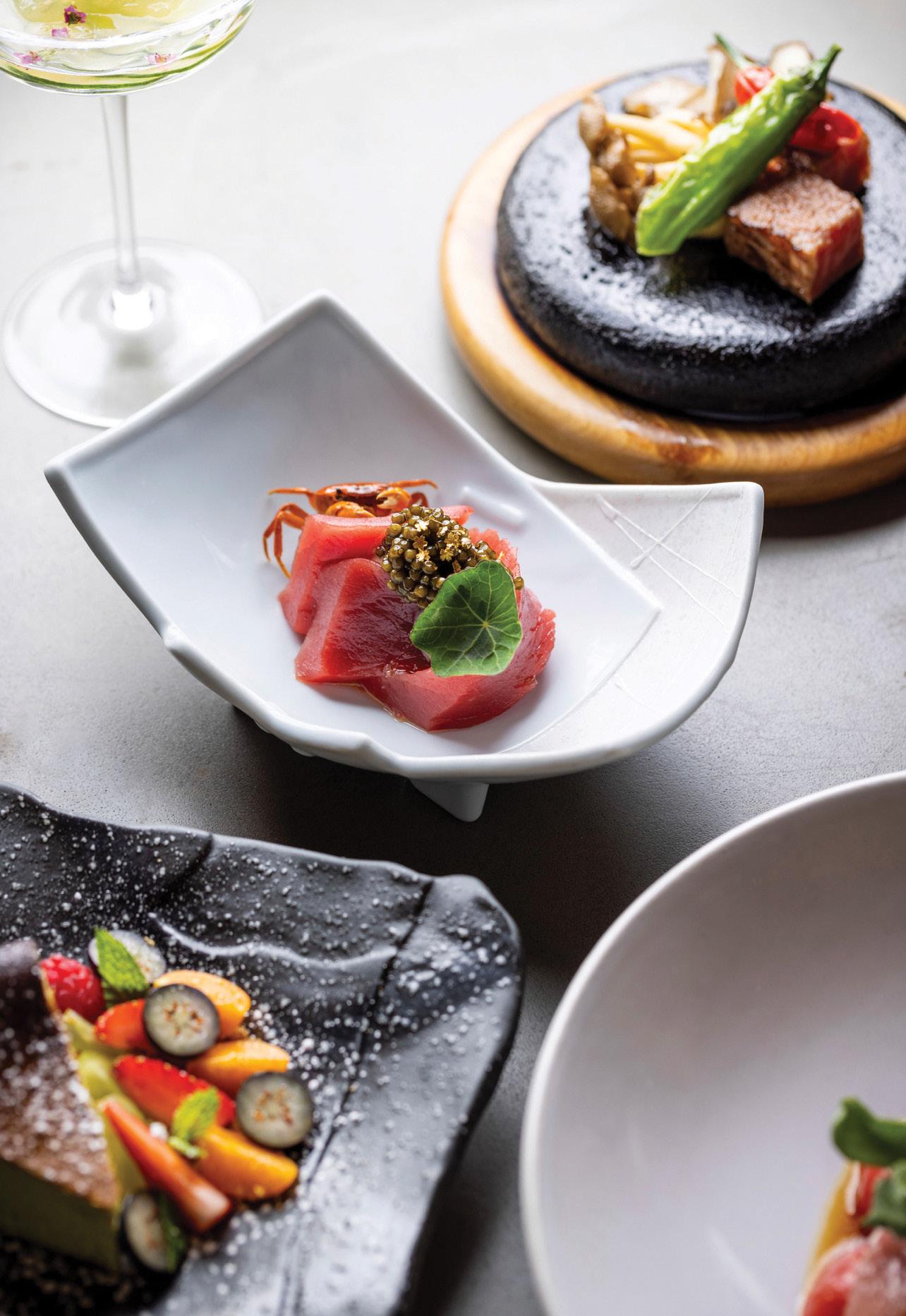
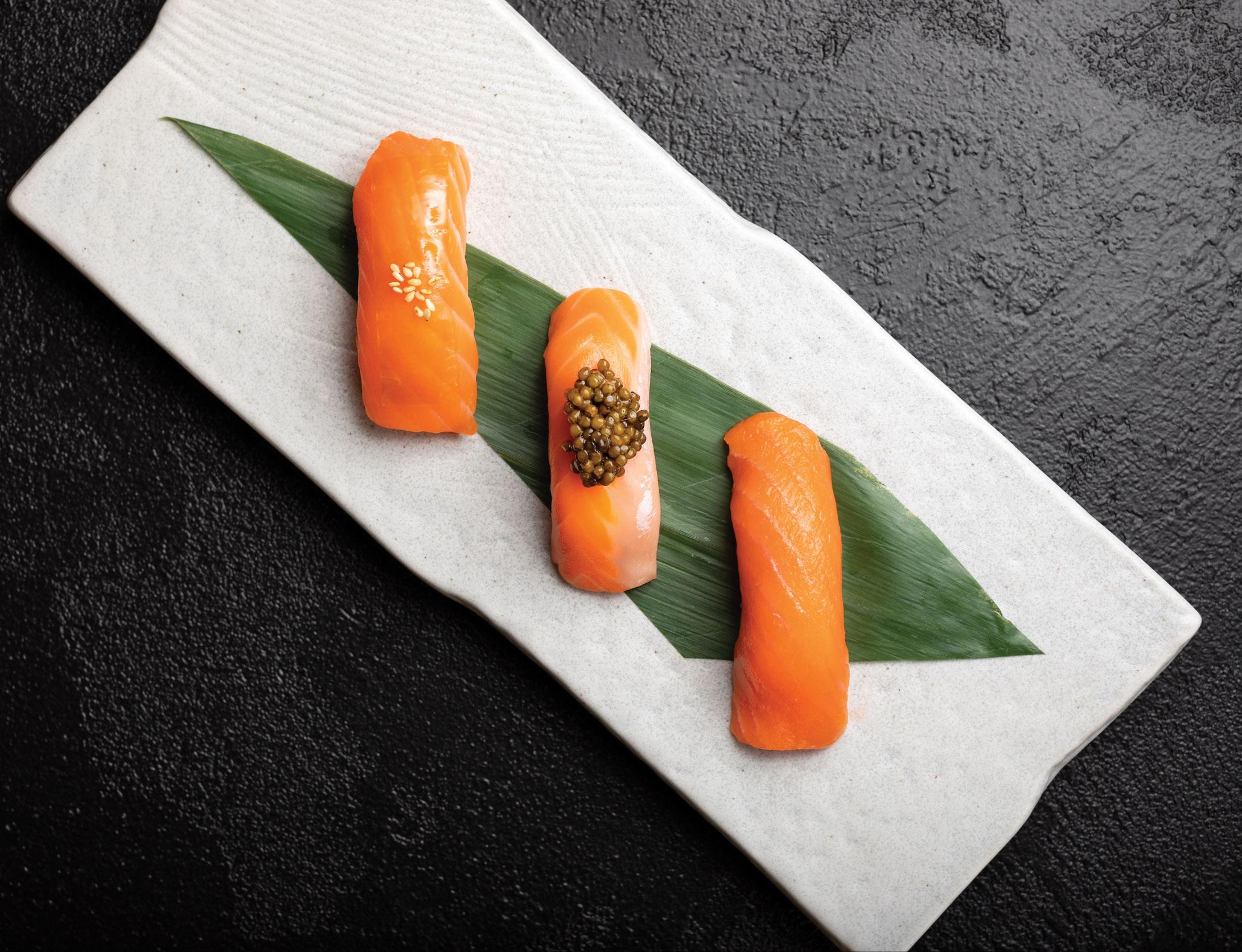
cocktails, and diverse a la carte menu, Brothers seems to have mastered the happy medium between being a fan favorite and an elite destination.
Mark credits several dedicated, time-honored tech niques he uses to two highly regarded sushi chefs he trained under at Asanebo: Tetsu and Shunji Nakao. He says he also learned what it is to be an LA chef from them. “They taught me basic techniques, but they also taught me the process of using seasonal ingredi ents from Japan and products from our local farmers markets,” he says. Mark stops by the Torrance farmers market on Saturdays, where he purchases La Bahn Ranch gourmet chicken and specialty Asian produce like Momotaro tomatoes and K&K Ranch peaches.
The chef is expanding his network. This past June he opened another Brothers Sushi on Santa Monica’s bus tling thoroughfare, Montana Avenue, where he serves a smaller, more refined menu than at his family-friendly Woodland Hills location. “Diners have been so excited to have us in Santa Monica, and are just as supportive of us there,” Mark says. “They’re really ready for nice fresh sushi and sashimi, and we knew how to refine and simplify our menu because of what we’ve learned in Woodland Hills.” ■
Specializing in wholesome, handcrafted recipes and libations. With warm hospital ity, good vibes, globally inspired food and music, we are a culture—not a concept.
Silver Triangle District 12345 Ventura Blvd., Studio City 818-506-7050 | granvillerestaurants.com
IG: @granville
A casual, local gathering place for food, friends, wine and cocktails with a menu that reflects an uncomplicated, classic, grassroots approach to Italian country food inspired by our Southern California backyard.
14235 Ventura Blvd, Sherman Oaks 818-456-1216 | osterialabuca.com
IG: @osterialabuca
A family-owned scratch kitchen that puts a unique twist on your breakfast and lunch favorites. Featuring draft beer, wine, mimosas and a monthly Supper Club with a chef-driven tasting menu.


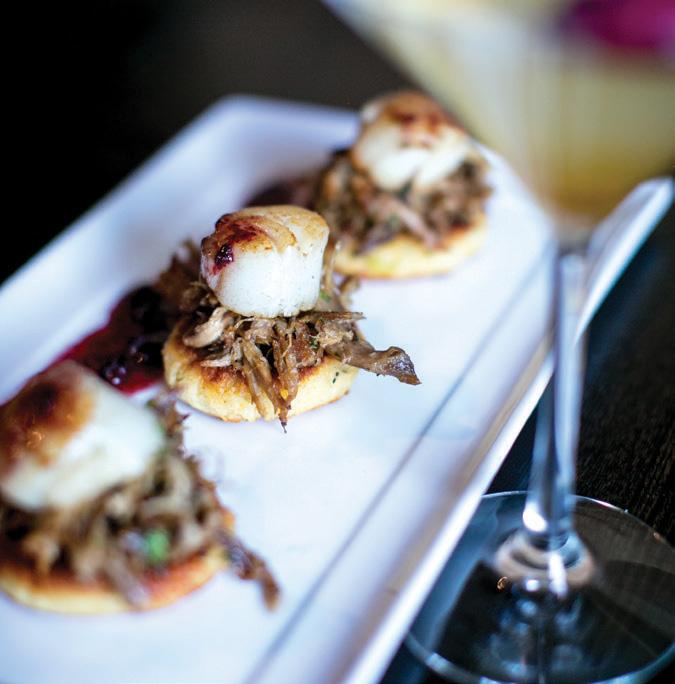
17823 Chatsworth St., Granada Hills 818-488-9841 joescafegh.com
IG: @joescafegh
A modern restaurant and bar with influ ences from traditional Persian flavors. Fresh cuts of meat and produce grilled over an open flame, served in a relaxed, chic atmosphere.
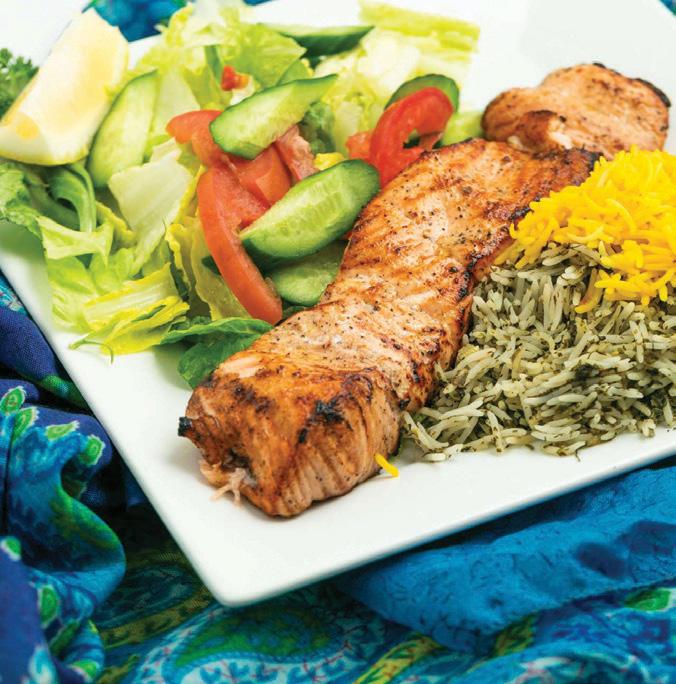
16240 Ventura Blvd, Encino 818-981-8100 sadafencino.com
IG: @sadafrestaurant_la
An homage to New York delicatessens with a contemporary edge. The menu features traditional Jewish fare and an eclectic array of international and American cuisine.

24005 Calabasas Rd., Calabasas 818-223-8777 | lovisdeli.com

IG: @lovisdeli
Experience a modern American restau rant and bar with multicultural influences, featuring the freshest seafood, produce, proteins and oyster bar.
13359 Ventura Blvd., Sherman Oaks 818-855-1661 woodandwaterla.com
IG: @woodandwaterla
A YOUNG ENTREPRENEUR PARLAYS AN OLD FAMILY RECIPE AND SOME DEFT SOCIAL MEDIA TO CREATE THE NEXT GENERATION OF HUMMUS.
Written by Steven Stiefel | Photographed by Shane O’DonnellJonathan Srour isn’t your typical budding entrepreneur. First, he’s only 19 years old. Second, his business has nothing to do with the digital world, music or any of the other pursuits young businesspeople typically set their sights on. Instead, he’s come up with a hip ver sion of an unhip idea: a hummus company.
To Jon it was the most natural thing in the world. He began Habiza Hummus out of his family home in Toluca Lake in 2021. Not only did Jon grow up in the Valley, but so did both of his parents. “The Valley is my true home and favorite place,” he says.
In the beginning, he hade the hummus in the family garage and sold it from the driveway. At the time he was a freshman at Santa Monica College, planning to transfer to Loyola Marymount University. He left LMU after just one day.
Point of fact: He was staunchly bullish on his idea, which is based on a recipe he learned from his Lebanese great-grandmother that uses high-quality ingredients.
“Try other grocery store versions of hummus,” Jon challenges. “None of them taste like restaurant-quality hummus. But Habiza does.”
Jon concluded that going into business for himself was likely to pay dividends that exceeded the typical college career path with the accompanying debt. An increasing number of high school graduates are choos ing a similar business model as they decide against the astronomical cost of a college education. While many parents may balk at their offspring’s decision to drop out, Jon’s parents were behind him.
And maybe Jon is onto something new and different with Habiza. “Take a look at our Instagram page,” he insists during our interview. “It isn’t a product page;
it’s a party.” He’s not wrong. If you’re going to choose a hummus brand based on images, then Jon’s rules. It’s filled with attractive 20-somethings (and some elders) eating hummus—and having a great time. His com petitors’ pages are full of stuffy pictures, one after the other, about how to use hummus.
One can’t help but ask: Why does the world need another brand of hummus? “The key things to making good hummus are simplicity and quality ingredients. Hummus is a metaphor for life: Keep it simple,” Jon says.
Hummus is a creamy Middle Eastern dip made from garbanzo beans. With Habiza, Jon follows a unique Old World process that’s reminiscent of the way his greatgrandmother made hummus. “We’re scaling homemade cooking,” he says.
Another ingredient in hummus is tahini—a paste made from sesame seeds. “This is where a lot of com panies cut corners,” he says, explaining that Habiza uses high-quality tahini sourced from Lebanon.
So why is grocery store hummus inferior to restau rant-quality hummus? A lot of grocery store versions substitute other ingredients for high-quality tahini. “Many of our competitors also use preservatives and vinegar. But vinegar doesn’t belong in hummus,” he explains. Those other ingredients create longer shelf life but a less tasty product.
Once the product developed a local following, Jon got in touch with the buyers at Erewhon. “I submitted an ap plication on their website on a Saturday.” Then, while
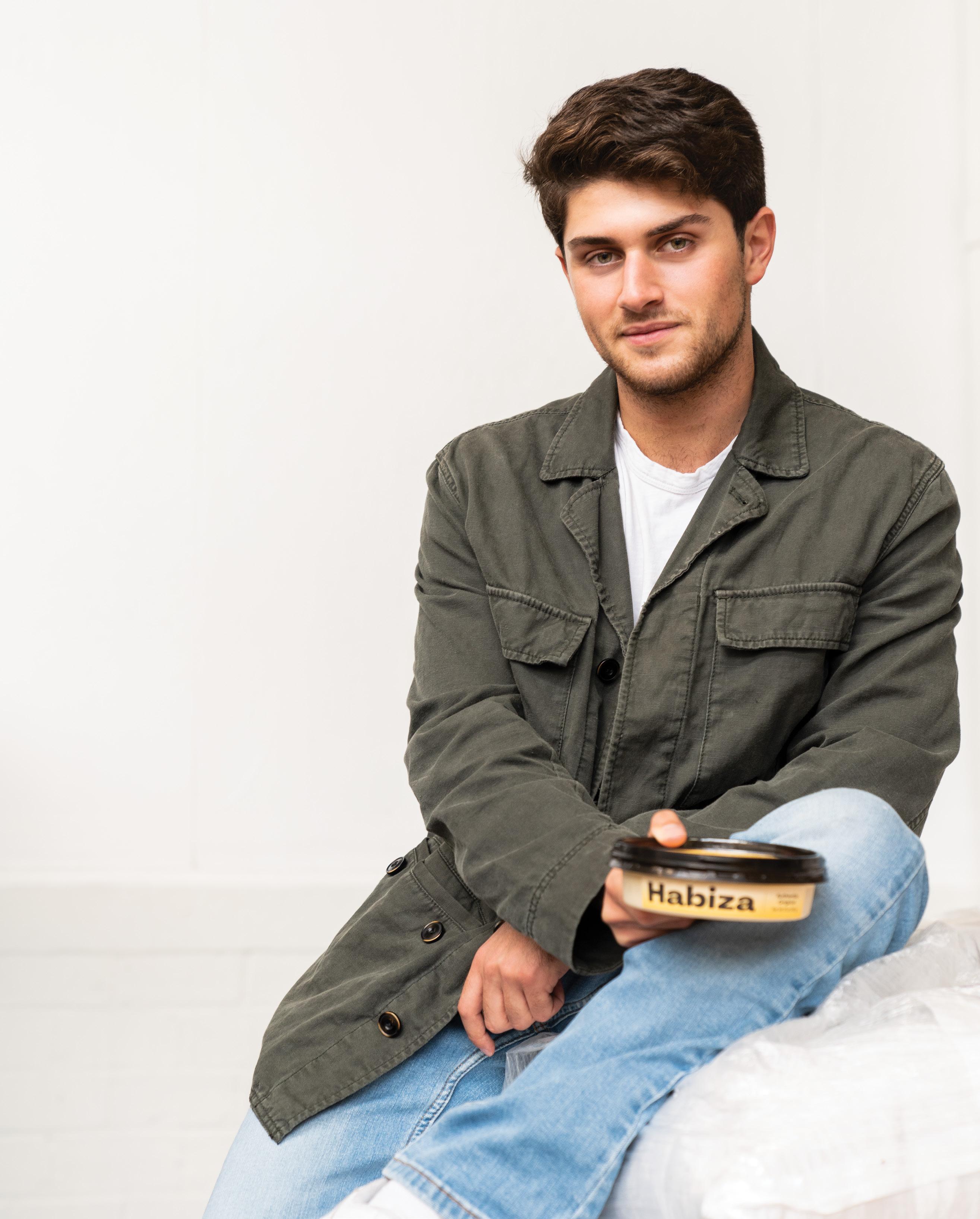


selling the product from his driveway the next day, he told everyone he’d give them $2 off if they submitted a product request for Habiza on Erewhon’s website. “Samples were delivered to them on Tuesday, and we were notified on Thursday that we’d been accepted to be sold in the store.”
During that time, Jon was also doing his own version of disruptive marketing. “I would go into grocery stores and sit in the hummus aisle.” When someone was interested in buying a competing brand, he would offer them a container of Habiza Hummus for free—with contact info on the label. “I would tell everyone that I was a pollster from UCLA, but people wondered why this young guy was so excited about hummus.”
After Habiza was stocked into Erewhon, Jon went in to one of the stores. “I introduced myself to the man ager, and I asked how Habiza was selling. He told me that they sold out on the first day.”
As one might expect, Jon’s pitch is youthful—and infectious. “We want Habiza to feel like a party,” he says. “You have dinner with your grandma, who serves hummus, and then you hit the club afterward and dance to ABBA.”
Habiza is currently available in two flavors: basic, and a spicy version: jalapeño with serrano. Jon says his hummus will soon be available in single servings for those on the go, as well as a garlic flavor.

Like any industrious entrepreneur, he has his sights set on expansion. “I’m really pleased with the growth and current trajectory of the company,” Jon says. “I have a lot of belief in our product and brand, and I’m looking forward to seeing what the future holds as we begin expanding.” ■

 Written by Chelsee Lowe | Photographed by Shane O’Donnell
Written by Chelsee Lowe | Photographed by Shane O’Donnell

Jessica Love Williams is many things. She is first and foremost mother to Hunter, 6, Parker, 4, and Slater, 2. Other roles include life coach, teacher, writer and artist. Despite all those responsibilities, when a project or challenge arises, she prefers to take it on herself.
That’s precisely what happened when she and her husband, Eric Williams, purchased a ridgetop house in the gated community of Bell Canyon four years ago. Living in Santa Monica at the time and looking for more space for their family, they fell in love with the hilltop home’s serene, majestic mountain views. The house was traditional French-country in style, but Jessica envisioned something else—something more akin to the couple’s favorite place in Bali, Bagus Jati Health & Wellbeing Retreat.


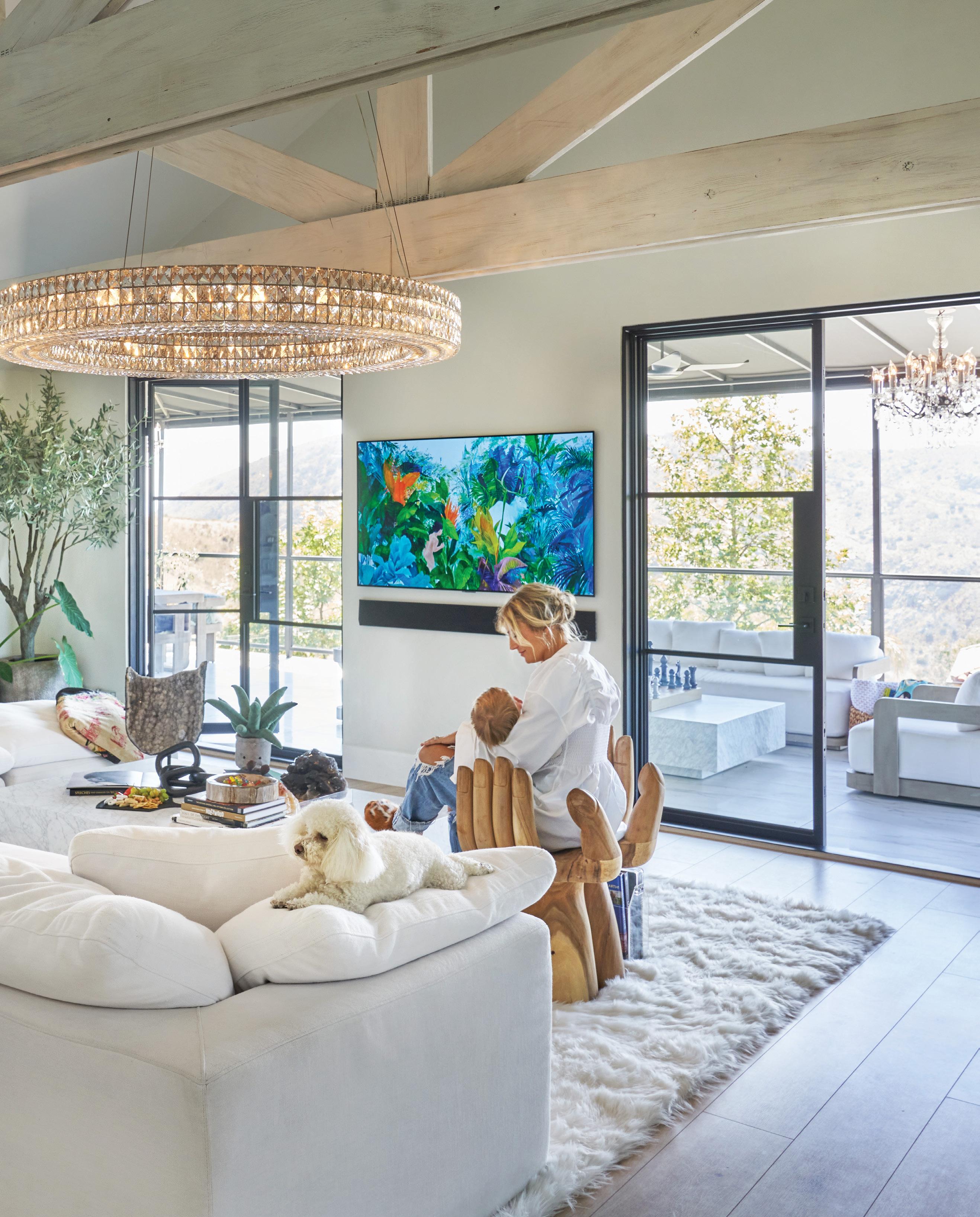

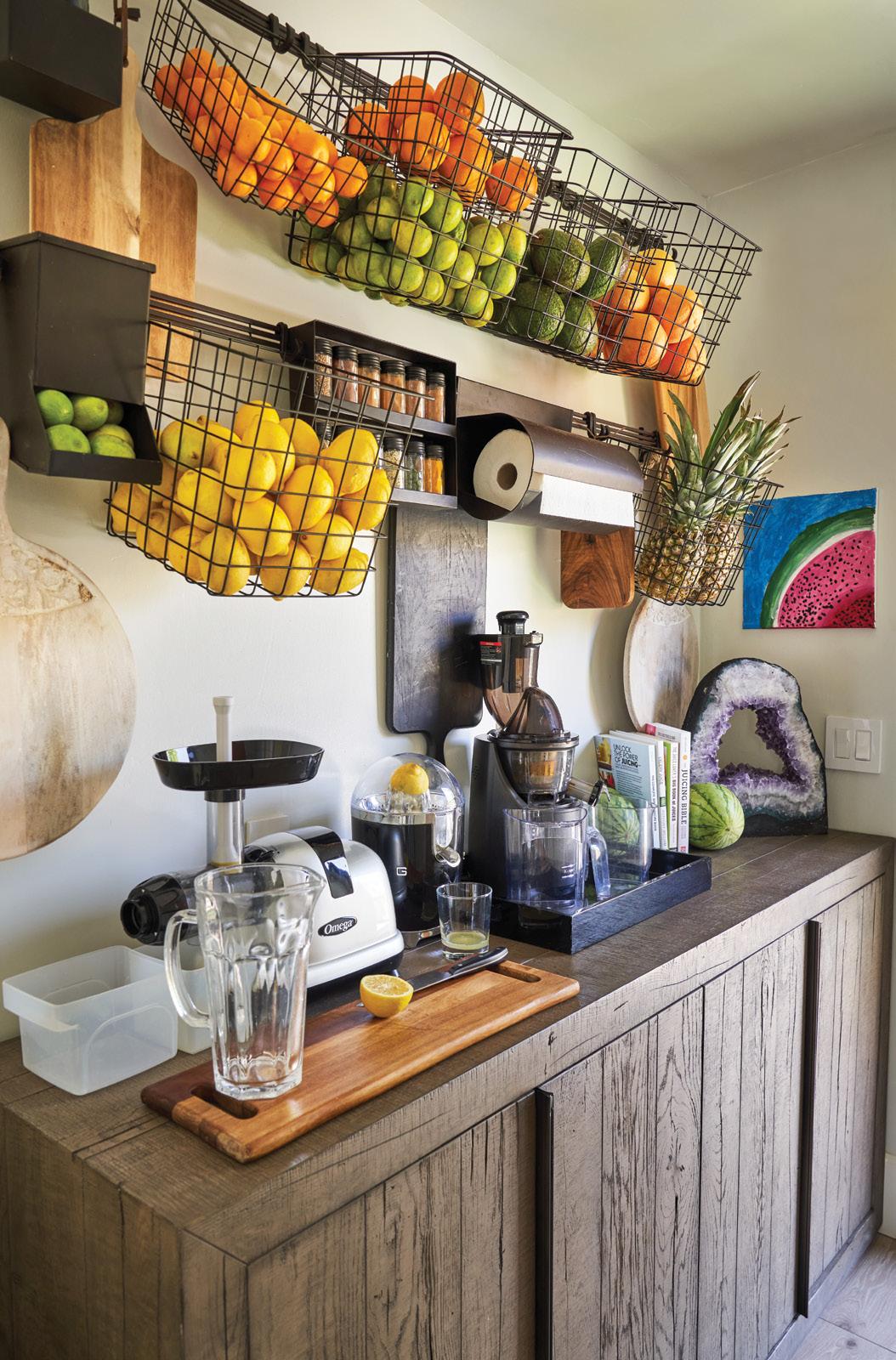

“The homes are built into the hillside, so you feel like you’re in a treehouse,” Jessica says. “I wanted it to feel like that.”
She decided to redesign the entire 3,500-square-foot home phase by phase, hiring subcontractors willing to work alongside her. The exterior was modernized with crystal white Santa Barbara stucco, new black-trimmed windows and custom steel doors from Pinky’s Iron Doors. Inside, a curved staircase to the second floor that dominated the entry was replaced with floating steps off to the side.
Nearly all the surfaces in the house were replaced. Cool gray tones greet guests in the new foyer, which, via the oversized iron and glass doors, looks through to the new pool, a putting green and mountainscape. Floors here are marbled, polished porcelain that transi tion to white oak vinyl floors down the hallway. Walls are an unsealed Santa Barbara dove gray stucco, which Jessica helped lath herself.
“The cracks I see, the different colors through out—it’s just so yummy to me,” Jessica says. “I like getting my hands dirty. Hunter helped, too; he was our cement mixer.”
Also on the first floor is a large room with a mini kitchen that Jessica uses to homeschool the kids. “Learning to cook is all part of it,” she quips. Art sup plies and more peek through metal mesh cupboard fronts in the cabinetry, similar to some Jessica spotted at Shutters on the Beach in Santa Monica.
“I like the kids to be able to see things. They dress themselves. They pretty much do anything themselves that they can,” she says. “I want to teach them an ex ecutive philosophy: They make choices, they can make mistakes, they can fail. Now’s the time.”
Countertops are porcelain, which Jessica says “are easily cleanable, even when the kids get paint on them.” Down the hall: a jungle-themed playroom with a climbing wall, a ball pit, a swing, and toy bins full of
Magna-Tiles and sports gear. Also here is Hunter and Parker’s cloud-ceilinged bunk room. In an alcove back near the entry is a space filled with large wooden lock ers for each family member to put away their things.
Jessica shares that the kids’ preferences influenced several other design choices. Parker loves crystals, and she selected the large citrine geode that’s displayed in the foyer. Larger-scale art includes a beautiful piece of moss art done by Jessica and friend Nikki Davis, and a 7-foot-long photograph of a lion and a lioness resting in a tree in Kenya, taken by National Geographic pho tographer Beverly Joubert.
Nearby is the family office, where the Aviator Wing Desk by Restoration Hardware is piled with paperwork for Jessica’s private coaching and homeschooling, along with Eric’s work. He co-owns a film and TV manage ment company with his brother, as well as Celebrity Championship Boxing gym in Woodland Hills with Zab Judah. Just outside the office is the floating staircase, and beneath it is a trickling water fountain. As you climb to the second story, it indeed feels like you are entering a treehouse in a rainforest.
At the top of the stairs, a pristine and open living, dining and kitchen space looks out into the canyon with better-than-180° views. Interiors are transitional, blending a contemporary sectional sofa with crystal chandeliers. On the south side of the room, facing the canyon, is a sprawling, porcelain-tiled covered ter race with more sparkling crystal chandeliers lining the ceiling. It’s an alfresco space that’s wildly loved by the whole family.
“This patio, with its panoramic views, is my favorite feature of this house,” Eric says. “Watching the sun rise over the city and set over the mountains—it’s a reset button for the soul.”
In the open kitchen, everything is hidden—a tes tament to Jessica’s minimalist decor sensibilities. Built-in, sleek and nearly incognito German appliances
by Gaggenau include a steamer and an espresso machine. Across the galley are hands-on breakfast and smoothie stations, with everything strategi cally placed within reach for the kids. The pris tine produce on display feels like art—an edible rainbow in hanging wire baskets. Jessica sourced the professional-style acrylic bins for the smoothie additives herself. “I pretty much just go online and find whatever I’m looking for,” she says. The couple’s bedroom suite on this floor is sparse yet sophisticated. Jessica holds onto just a few items in her custom-made, floor-to-ceiling steel and glass closet, where red-carpet looks can be assembled when needed. As with all other rooms in the house, everything has its designated space—from the de signer handbags to the gowns. “I call this closet my boutique; it’s more for special occasions,” she notes

“THIS PATIO, WITH ITS PANORAMIC VIEWS, IS MY FAVORITE FEATURE OF THIS HOUSE. WATCHING THE SUN RISE OVER THE CITY AND SET OVER THE MOUNTAINS— IT’S A RESET BUTTON FOR THE SOUL.”

as she moves into the bedroom. “This is where I put my everyday wear,” she adds, pulling out a drawer filled with black pants and tops.
“I do not like clutter,” she says, “even in what I wear. Anything I can do to unclutter my mind—whether it’s the landscape I look at or the drawers I open—I will do. My goal is to be still, be present, and soak it all in.” ■


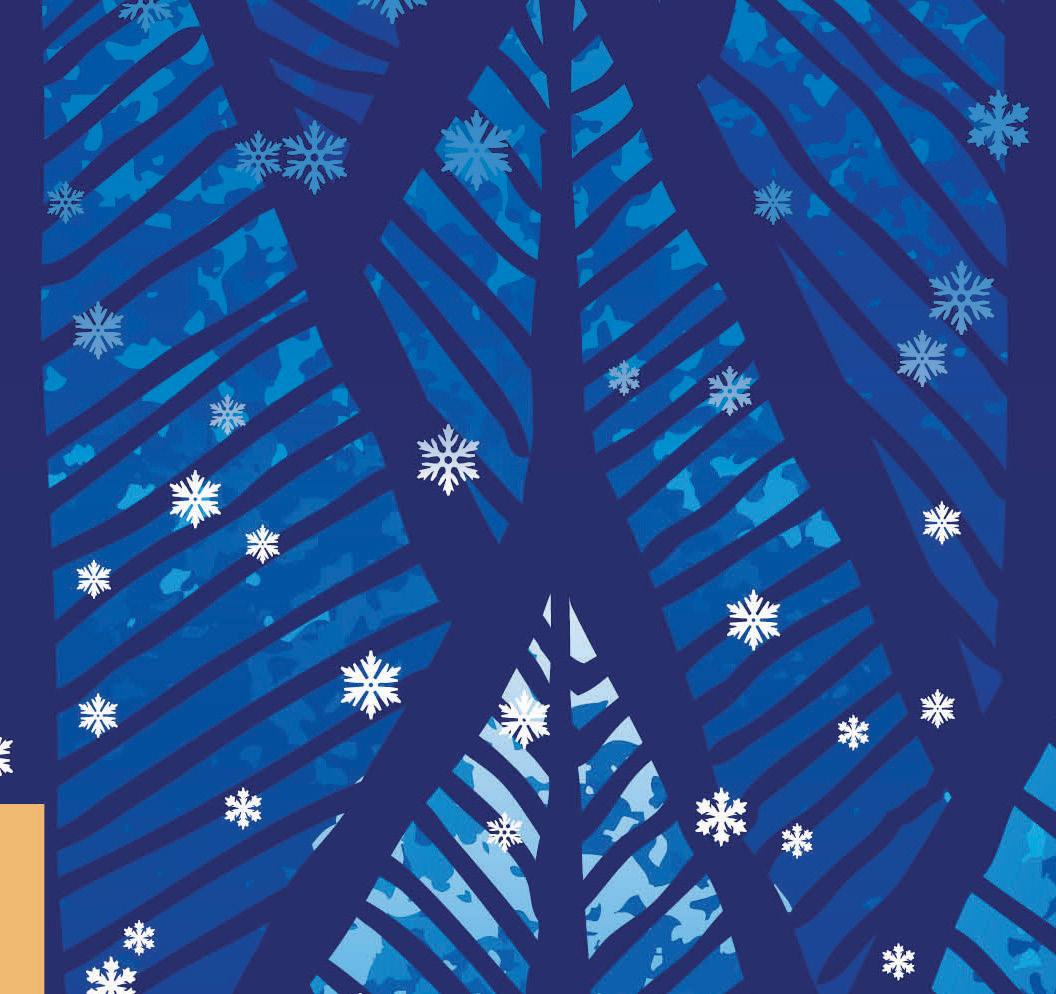
Share your best gift ideas and must haves for the perfect holiday season this year. From table decor to holiday fashion, home essentials, tree decorating and more — we have the ultimate gift guide for Valley residents.




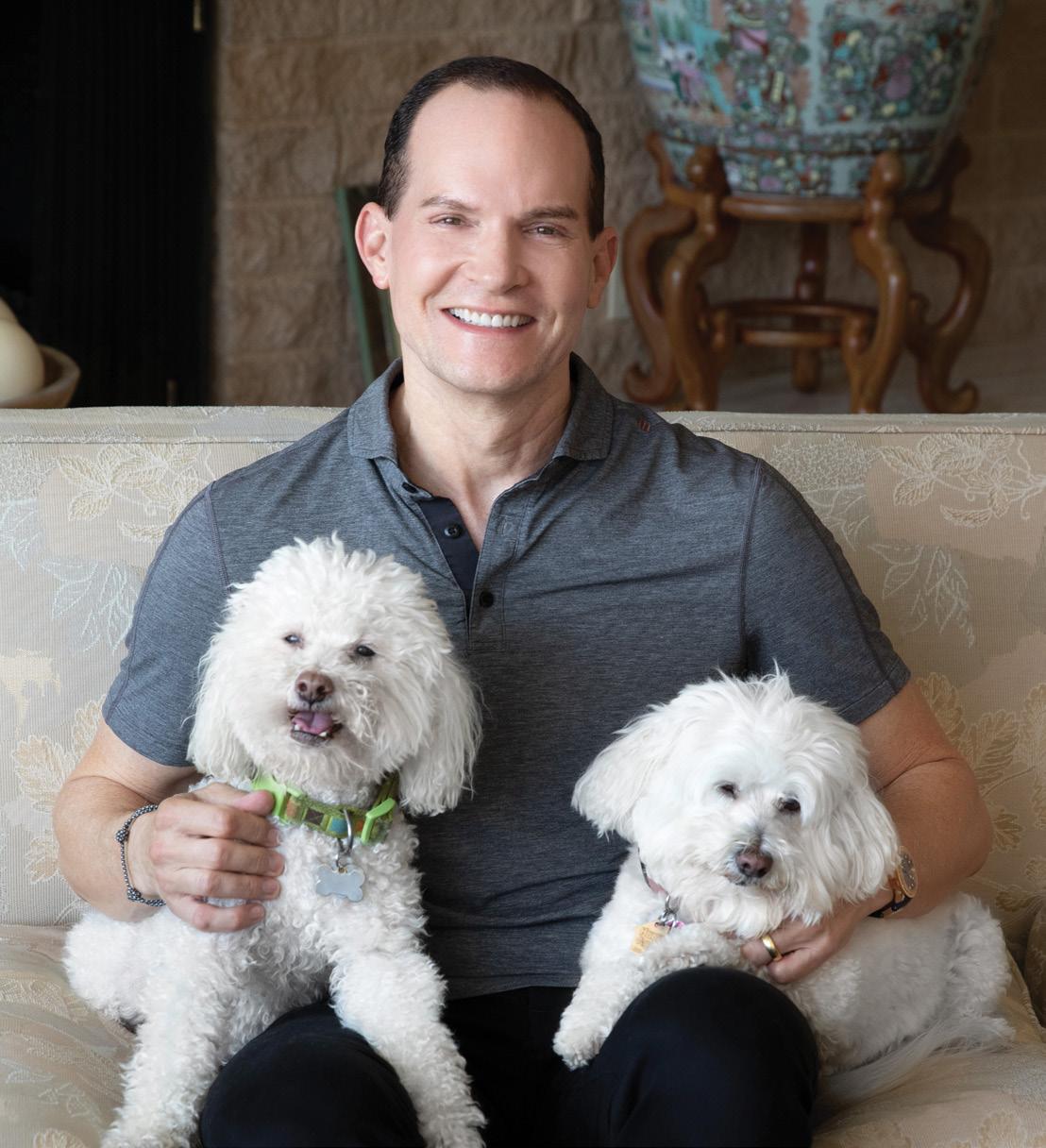

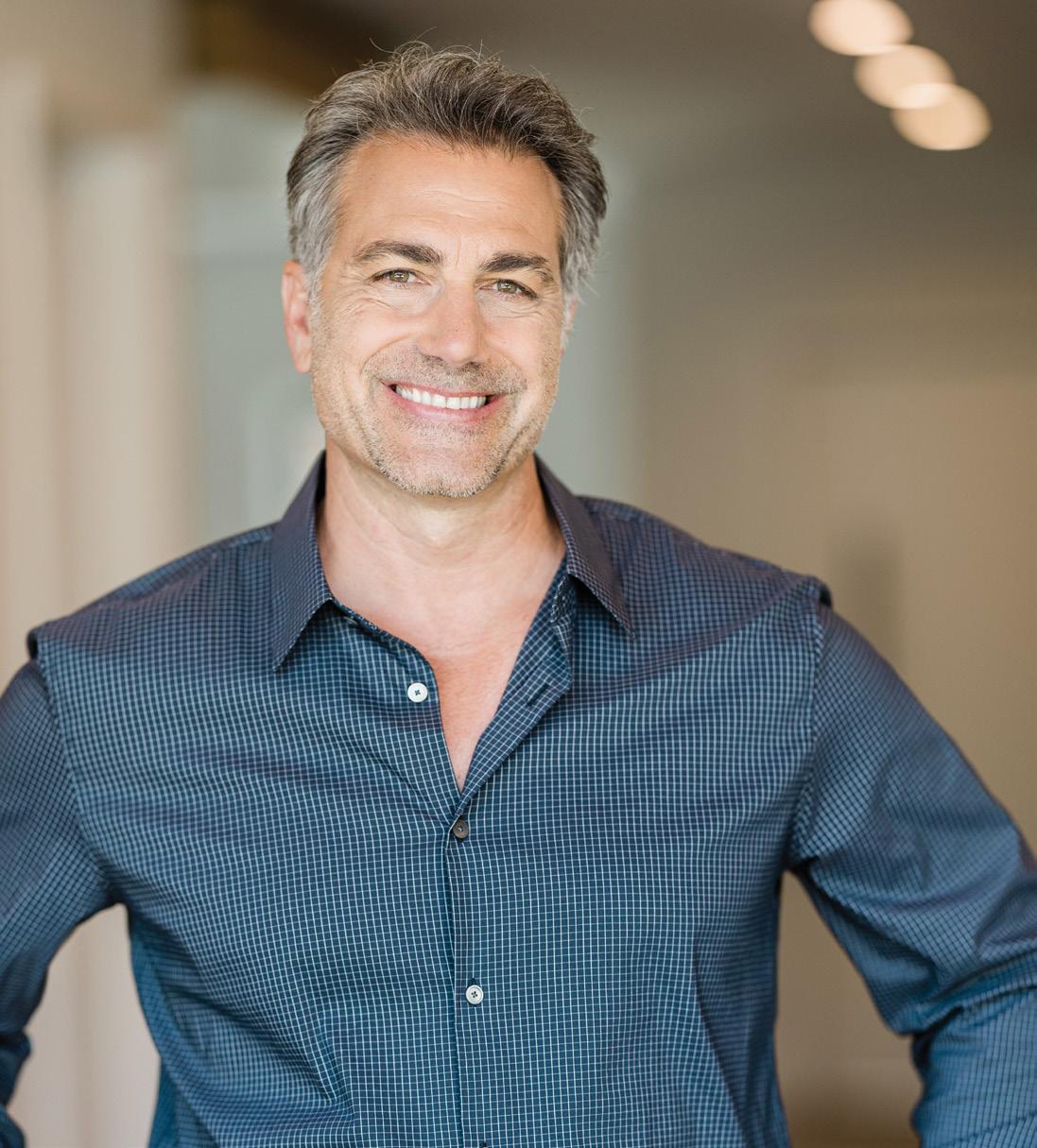
Meet some of our community’s top-tier professionals in this special section of our annual Men’s Issue. On the following pages you’ll meet several well-regarded local experts who have the experience, skills and commitment to excellence to get the job done. Discover the stories behind their success in this special profiles section: Men of the Valley.
82 DENNIS CHERNOV CHERNOV TEAM | THE AGENCY
84 ANDREW MANNING BERKSHIRE HATHAWAY HOMESERVICES CALIFORNIA PROPERTIES
86 GEORGE OUZOUNIAN THE AGENCY
87 MICHAEL BERGIN MICHAEL BERGIN REAL ESTATE | COMPASS
Dennis Chernov began his real estate journey when he owned a property loan business in the early 2000s—building a foundation in the transactional processes necessary to buy and sell property and developing a keen aptitude for qualifying potential buyers quickly. In 2009 he transitioned to working as a full-time real estate agent and since then has consistently ranked as a top-producing agent in Los Angeles County year after year. Now with nearly two decades of experience in the field, he has joined The Agency.
I was working as a lender in the early 2000s. One of my clients wanted to purchase a property, and I helped him do so. After closing three deals with him, I quickly realized that I enjoyed this part of the real estate process and could see myself doing it full time.
The Chernov Team embodies integrity and vitality across all of our business operations. We hold ourselves personally accountable to the highest standard of performance, vigorously working together to achieve dynamic results and remaining equitable and ethical—even in the most difficult situations. We share a resolute passion for what we do and an unwavering drive to excel in every move we make. We spare no effort, make no excuses and leave no stone unturned in realizing optimal success for all our clients.
AND HOW YOU LEAD OTHERS.
I lead my team by example. I see everything from a salesperson’s perspective. I provide support and mentorship to all our agents and internal staff on a daily
basis. In addition, our team holds weekly Motivational Monday Meetings in which we discuss the current market, new marketing strategies and business growth opportunities.
I aim to create a collaborative environment; I have an open-door policy and continuously encourage all employees to bring new ideas to the table. There must be open communication in the team for trust to develop. If our employees can’t speak openly, the integrity of the team will be lost. We all are working together toward a common goal; brainstorming and collaboration are essential for success.
WHAT IS THE #1 THING YOU DO TO ENSURE YOUR BUSINESS IS SUCCESSFUL?
Deliver consistent, transparent and timely communication to our clients. I pride myself on my attention to my clients. Our team does a large volume of business, but I provide a boutique level of service. I aim to make sure every single one of my clients knows that they are my priority. With this core value, I have earned the loyalty and trust of both home-sellers and home-buyers, many of whom have become lifelong clients and, most importantly, valued friends.
WHAT IS THE BEST ADVICE YOU’VE HEARD?
The best advice I’ve heard is the same advice I give my kids: Stay humble, work hard and don’t lose sight of what’s truly important.
WHAT ROLE DOES YOUR FAMILY PLAY IN YOUR CAREER?
My family is my biggest motivation. My wife, Yana Chernov, is my business partner and the head of operations and marketing in our company. Yana has been deeply involved in the business since its inception, and the Chernov Team wouldn’t be where it is today
without her. We both work hard to instill the same ethics in our two boys and set a great example for them.
HOW DO YOU BALANCE WORK AND PLAY?
I make it a priority to spend quality time with my wife, kids, family and friends. Whether it’s going on a date night with my wife, watching my boys play basketball or going on a family vacation, I believe a good worklife balance is important if you want to live a happy and fulfilling life.
TELL US ABOUT A FEW OF YOUR PASSIONS. My main passion is being a good father to my two boys by being present in their lives. We share a passion for basketball and living an active lifestyle, so I spend most days supporting them through their basketball activities. I also enjoy exercising by going to the gym and exploring the Valley’s plethora of hikes.
HOW DO YOU FIND TIME TO FIT IT ALL IN?
Thankfully I have a great team and support system—both at work and home—to help keep me organized. All my appointments, showings and personal events are input into my calendar, which helps keep my days in order. It also helps to create a strict daily routine and stick to it. Although every day looks different in this business, I know what my day will look like each morning.
TELL US YOUR FAVORITE QUOTE. “You can’t conquer your goals if you can’t conquer your mind.”
I’m a volunteer coach on my boys’ youth basketball team. I support local businesses and charities, and I encourage homeownership in the Valley.

ealtor® Andrew Manning joined Berkshire Hathaway HomeServices California Properties in 2013 as a founding member of the Luxury Property Division. Now serving as a designated Luxury Property Specialist, he continually achieves the ranking of #1 individual agent in the San Fernando Valley and top 10 in the country and has brokered more than $2 billion in closed transactions.
Andrew grew up in Sherman Oaks and Tarzana and had an early interest in real estate, attending open houses as a teenager because design, style and architecture fascinated him. He majored in political science/communications at UCLA and earned his broker’s license during his junior year of college. He began working full time in real estate and also worked as an assistant manager at a family law firm for more than three years during that time. After getting the Rookie of the Year award at his brokerage in 1986, he quit law and focused solely on real estate.
I truly enjoy the matchmaking process of finding the perfect buyer for a listing or the perfect home for a great buyer. There is no greater feeling than having a client tell you, “We really love our new home” or “Thank you for all you did to get us so seamlessly from our old home to our new home.” I have had the great pleasure of selling multiple homes to the same families/buyers and watching families grow over the years. I have helped people upsize, downsize and “rightsize” to the perfect home many times.
WHAT IS THE BIGGEST MISCONCEPTION ABOUT REALTORS?
Many people think Realtors are only concerned about making a commission and moving on to the next deal. My
philosophy since day one is to create “clients for life.” Clients call me 10 to 15 years later asking for referrals for painters, contractors, window cleaners, etc., and I am always happy to help. We have developed an ever-changing list of curated professionals to help smooth out the homeownership experience.
WHAT ARE SOME WAYS YOU AND YOUR TEAM HELP CLIENTS FEEL THEY ARE IN GOOD HANDS?
We continually get positive reviews from both new and past/repeat clients. At this point in my career I am about 80% referral, which is every agent’s endgame. When meeting with clients, it is important to listen. Find out what their goals are and work to help them achieve or hopefully surpass their expectations.
We assist with both premarketing preparation for homes as well as staging, repairs, cosmetic improvements and advice on what to do prior to presenting your home for sale. In these times, 99% of first views are online, so staging and professional photography have never been more important. If your home does not show in its best light online, you are limiting your audience as well as your pricing potential.
In pricing we are aggressive without being overly so. Pricing remains key in any market, but overpricing can damage your potential and lead to an eventual lower sales price.
I am a glass-half-full person and find that my sense of humor and positive attitude help me and others through their days. Making people laugh, more than ever, is a crucial goal for me. I am grateful for my health and my family’s health most importantly.
My partner, Steve, is my best source of advice and an integral part of our team. He has run a small company and has been a Realtor for even longer than I have. He is my go-to for discussing both positive and negative situations.
Self-care and time management. You have to take care of yourself first mentally and physically to be able to service your clients at a continually high level.
I truly love helping others—friends, clients or even the occasional stranger in need. Doing good for others and working to find something nice to say to everyone you meet is so important with all the negativity that surrounds our daily lives.
TELL US ABOUT YOUR FAMILY.
We have the ultimate modern family. Steve and I have helped raise two amazing kids who are now in their 30s, and we have two amazing grandsons. We are friends with Steve’s wonderful ex-wife and her husband, and we all enjoy spending time together. Everybody gets along and has each other’s backs.
WHAT WAS YOUR VERY FIRST JOB?
Scooping ice cream at 31 Flavors in Tarzana at 14. I knew I was destined for bigger things when they made me staff leader at 16 and I was in charge of people in their 20s!
Disclaimer: ©2022 Berkshire Hathaway HomeServices California Properties is a member of the franchise system of BHH Affiliates LLC. BHHS and the BHHS symbol are registered service marks of Columbia Insurance Company, a Berkshire Hathaway affiliate.

Alicensed broker and seasoned real estate investor, George Ouzounian has been a real estate agent for 18 years. He joined The Agency in 2019 and is a Certified Luxury Homes Marketing Specialist and a Certified Negotiation Expert.
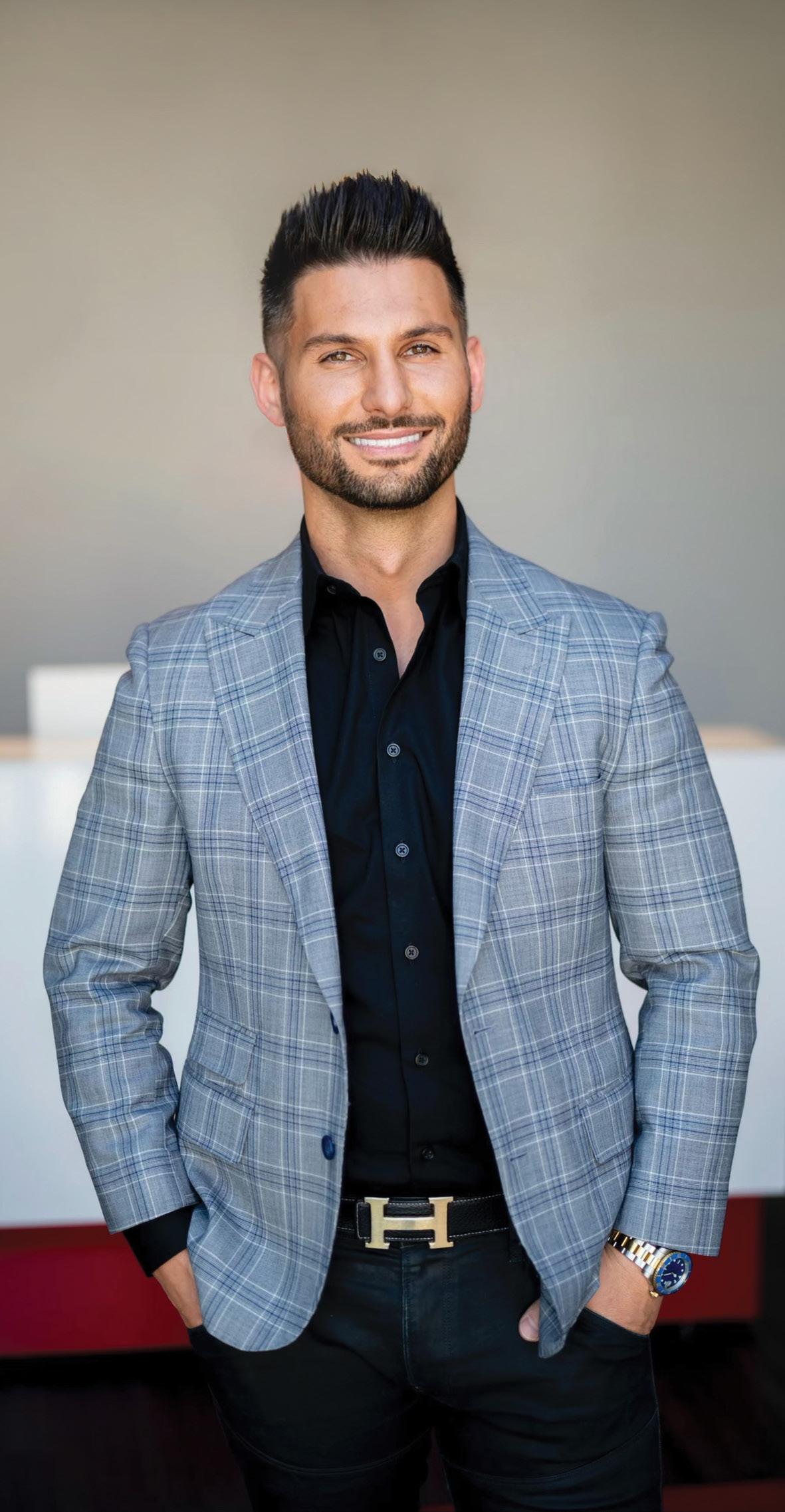
I chose The Agency as I believe this is the best real estate com pany in the world. We are a boutique luxury firm like no other. We enjoy an uplifting culture of mutual support, working hard, playing hard and being true to your word. Along with my own experience and expertise, my clients benefit from The Agency’s world-class sales and marketing team—no matter how large or small the transaction.
Our team made a commitment several years ago to make social media a priority for our marketing. Today we connect with family, friends and clients multiple times a day on all social media channels. It’s become a proven way to stand out from others—not only marketing our listings but also showing our audience a glimpse of our personal lives.
Our attitude is that if we don’t exceed their expectations, we have not met ours! We set a very high bar for client service on our team and believe strongly that real estate is much more than just a sale. It is a very personal transaction for most of our clients. Thus we have a seasoned team experienced in making sure the client is receiving white-glove service throughout the entire experience. We service our clients in all aspects of the transaction from listing to closing, cosmetic improvements, staging, repairs and whatever may occur. We value this service so much, we recently added a client experience manager to our team. Her sole job is to make sure the client is taken care of and that we’re always a step ahead of their needs. Our work ethic is why we have more than 250 five-star reviews on Zillow and the majority of our business is based on client referrals.
This has been the most life-changing year because I became a father for the first time. We have a beautiful, healthy baby boy named Enzo who is about to turn 1. The amount of joy he has brought us is beyond words. To be able to have my beautiful wife and son, to work in the business I love and in the city that always has something going on is truly a blessed life!
Ranked as a top Los Angeles Realtor®, Michael Bergin has been helping Southern Californians buy and sell homes for 14 years. He founded the Compass Studio City office and is host of The American Dream real estate TV show.
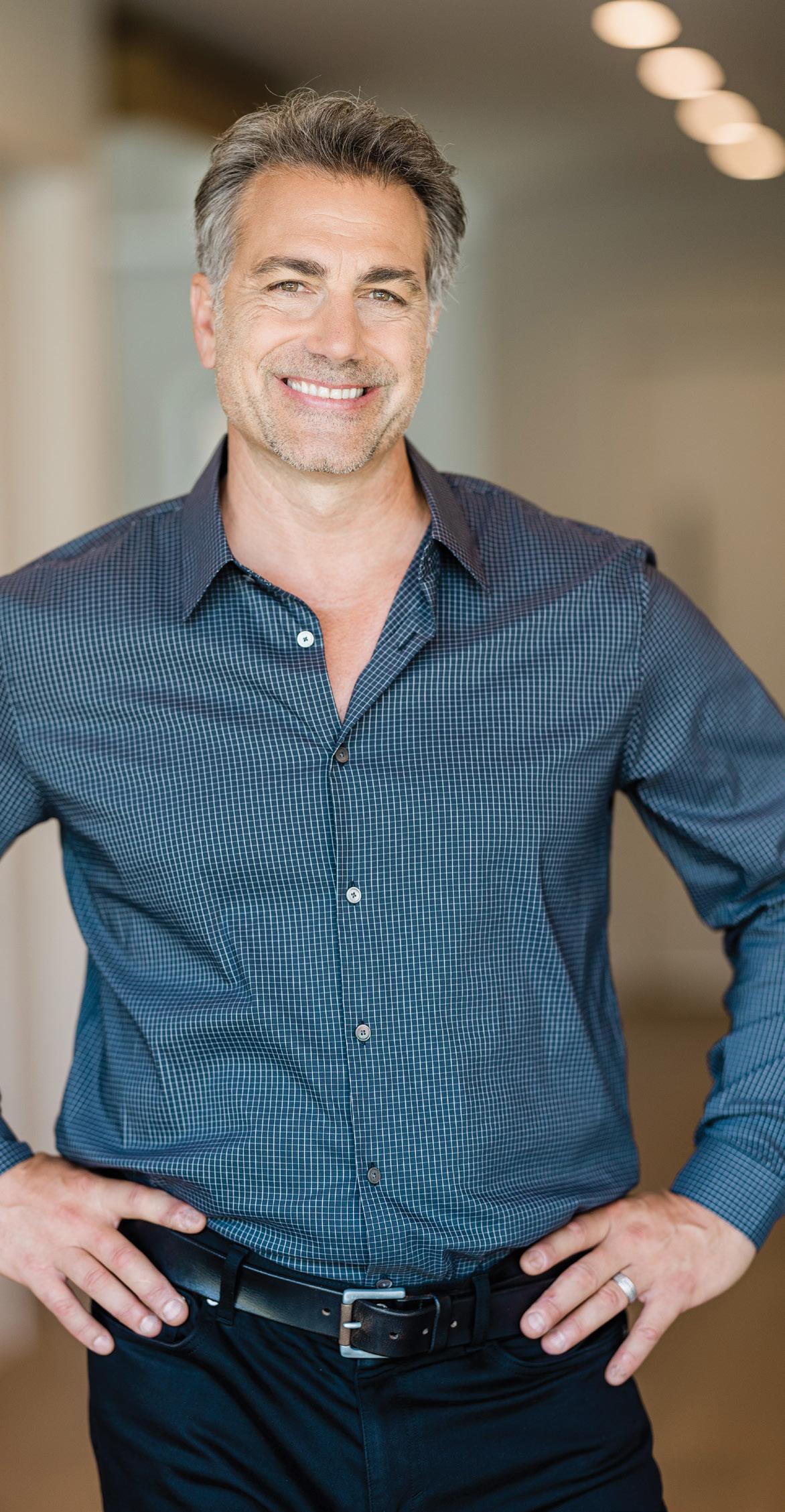
It was a no-brainer. This show was a perfect fit for what real estate is all about. We get to highlight not only the homes that I list but also the neighborhoods surrounding these homes. The first thing people think about when looking for a home is the location. So why not show them what makes these areas so special? From restaurants to local events to schools, we dive in and show these off.
Honestly, who doesn’t want to have their home featured on an Emmy-nominated show with more than 10 million viewers per month? But to go even further, it gives us an incredible oppor tunity to spell out the special qualities of the home along with highlighting something very special about the neighborhood.
Ha, how much time do we have? Even though I was an actor and best known for being on Baywatch for four years, I still get nervous in front of the camera! It helps that I shoot the show with my wife, Joy, who happens to be a natural at it and makes it fun. But I don’t think those nerves will ever go away. Secondly, it’s very challenging to narrow down what we will highlight in the neighborhood. There is so much to choose from—especially in Los Angeles. We do our best to think of what the audience would most like to see.
The show is shot once a month, and it helps that my wife pro duces the episodes. So she works on the in-depth aspects of the show and tells me where to be and what to say—while I still get to focus on real estate.
It’s completely unscripted. No one is making up drama. We focus on the positive aspects versus the other way around. And it’s more of a lifestyle show. Yes, we feature homes, but we spend more time talking about the areas and what makes them spe cial. We ask viewers who we should feature next. Let us know if you have any ideas for us!
Women who make us think Women who make us better Women who make us laugh

And women who make us believe.
The SheSez podcast—for women who want to make every moment count.
Available wherever you listen. More on SheSez.com.

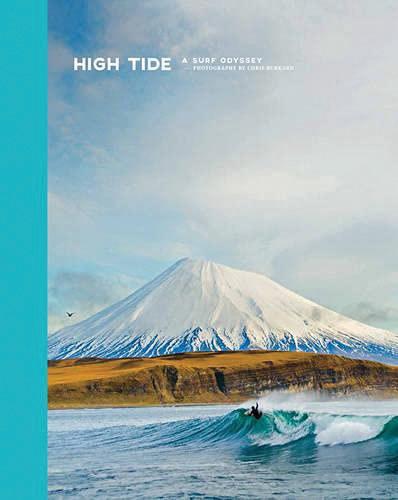 By Chris Burkard
By Chris Burkard
Breathtaking landscapes, remote and desolate places, the highest waves, the most spectacular jumps and a story of surfing to the ends of the world. A photographic homage to surfing in extreme conditions, made by an international surfer and his team, High Tide, A Surf Odyssey follows the surfers in their epic journeys and achievements in countries like Iceland, Norway and Russia. This book portrays the ultimate battle between the elements and man kind: the water and the waves against the board and man.
$65
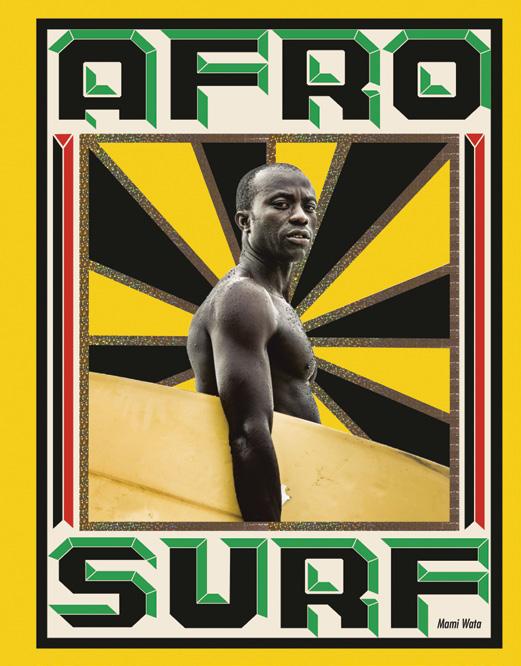 By Mami Wata
By Mami Wata
This collection is compiled by Mami Wata, a Cape Town surf company that fiercely believes in the power of African surf. Mami Wata brings to gether its cofounder Selema Masekela and some of Africa’s finest photogra phers, thinkers, writers and surfers to explore the unique culture of 18 coastal countries—from Morocco to Somalia, Mozambique, South Africa and beyond. Packed with more than 50 essays, Afrosurf features surfer and skater pro files, thought pieces, poems, photos, illustrations, ephemera, recipes and a mini comic.
$40
In the 1970s, photographer Hugh Holland masterfully captured the burgeoning culture of skateboarding against a sometimes harsh Southern California landscape. This collec tion showcases his black-and-white photographs documenting young skateboarders sidewalk-surfing off Mulholland Drive in concrete drainage ditches and empty swimming pools in a drought-ridden Southern California. The young outsiders evoke the some times reckless but always exhilarating origins of skateboarding lifestyle and culture. $40

A PASSIONATE CYCLIST AND ARGENTINA NATIVE SHARES HOW HE ACCOMPLISHED A BIKING PILGRIMAGE ON THE FAMED CAMINO DE SANTIAGO.
Written by Diane E. Barber | Photographed by Shane O’Donnell and Alex QuintanaAlex Quintana has enjoyed a lifelong soul connection to Spain—or the motherland, as the local Argentinian expat fondly refers to his ancestral country. During the pandemic, the former marathon runner took up cycling. Soon he became immersed in long-distance riding, and Spain once again beckoned to him and his desire to complete a Camino de Santiago historical pilgrimage.
“The Camino de Santiago (the Way of St. James) is a network of pathways in Spain, Portugal and France that lead to the shrine of the apostle Saint James the Great in the cathedral of Santiago de Compostela in Galicia,” says Alex. “The pilgrimage began over 1,000 years ago and was originally how one of the largest movements of people traveled through Europe. I was always intrigued by the idea of traveling a path that millions have trav eled throughout centuries. When I joined my closest friend, Eduardo, at the cathedral as he finished his 30+ day walk 10 years ago, I was inspired to do it myself.”
Alex began researching for his adventure in 2020. “I spent hours online reading and watching videos made by people from around the world who documented their experiences. I also visited websites and blogs and asked a lot of questions to learn as much as possible. That is how I discovered that cycling at least 200 km (124 miles) is recognized as a pilgrimage versus walking or horseback riding 100 km (62 miles),” he says.
With a watchful eye on global travel restrictions, he started to train for an October 2021 solo pilgrimage along Spain’s El Camino del Norte (the Northern Way). “I was riding two to three times per week the year before my trip. I had a good base, but I needed to add miles and time in the saddle,” he says. “Three months
before I left, I did more climbs to prepare for the chal lenge of the Basque country’s continual long hills.”
For distance training, he mostly rode the bike path along the ocean from Redondo Beach to Pacific Palisades, approximately 42 miles round trip. “I didn’t exceed 50 miles because I knew that my daily average in Spain was going to be 35 to 40 miles.”
His riding apparel was carefully planned for the autumn trip, including a helmet, waterproof shoes that could also be worn walking, temperature-regulating merino wool shirts and socks, padded mountain bike shorts, gloves, long rain pants and a windbreaker jack et. Before he departed, he reserved a hardtail mountain bike in Spain that was equipped with panniers (side bags), repair tools, a water bottle and a lock. He had
“THE TRIP BROUGHT BACK THE SENSATION OF FREEDOM AND ADVENTURE THAT I FELT RIDING MY BIKE WHEN I WAS GROWING UP AND CONNECTED WITH NATURE.”




many options to choose from, as he discovered several companies in Spain that rent bikes with additional ser vices for pilgrims such as bike delivery and pickup with luggage transfers from the starting point to the final destination hotel.
“When I arrived at the hotel in the town of Irun in the Basque country where I started, the bike was waiting for me in a box and ready to go. My suitcase was picked up and taken to my hotel in Santiago de Compostela, so I only had to carry essentials for the duration of my ride. The bike weighed 31 pounds with out gear. After I loaded it with my clothes, toiletries, water, food, phone and GPS, it was 52 pounds.”
Alex averaged 40 miles per day at 9 to 10 mph during his 875 km (544-mile) trek, which he completed in 16 days with three resting days. Other than the first and last hotel, he did not make reservations for places to stay along the way so he could enjoy a more flexible schedule. Weather was favorable with mild tempera tures (50s and 60s), and seasonal rain only fell at night when he was not riding.
However, the journey was not all smooth sailing. By the third day of riding the picturesque hills of the Basque country, the initial adrenaline rush waned and he began to experience muscle fatigue and exhaustion.
“The first few days were tough as I began to ques tion if I could finish 13 more days with 30,000+ feet to climb. I started to feel the lack of adequate hill training, and I wasn’t accustomed to doing back-to-back rides or climbing 3,000- to 4,000-foot elevations with the added weight on the bike. However, by the fourth day I found my rhythm, and with eight hours of rest I was ready for another day.”
According to Alex, one of the most important aspects during long rides is timely refueling and hydrating. “I learned that the hard way a long time ago. When I go longer than 45 minutes biking, running or hiking and I forget to drink or eat, my energy level drops radically. If I refuel every 45 minutes, I avoid that. So I scheduled
my meals and snacks accordingly.”
A good breakfast was always available at the hotels to start the day. Lunch, during typical Spanish lunchtime between 2 and 4 p.m., was at roadside cafes or res taurants in the many small towns he passed through. “Dinner was easy to plan,” he says. “I was already off the bike and relaxing, with time to go out walking to enjoy fresh local cuisine near the hotels.”
A GPS device, his phone and the iconic pilgrimage signs with yellow scallop shells that marked the route aided his navigation on the demanding terrain along the Cantabrian Sea and the Cantabrian Mountains. He got lost three times during the entire trip, which he at tributed to fatigue.
Remaining grounded in his spiritual appreciation for being present, he turned those mistakes into “cycle tourism” experiences and enjoyed the sights. When he asked locals for directions, he was grateful to experi ence warm and pleasant conversations and an occa sional history lesson. He also met many other pilgrims along the way who took time to share some stories about their experiences.
“The trip brought back the sensation of freedom and adventure that I felt riding my bike when I was growing up and connected with nature,” Alex shares. “There were numerous highlights, including the magnifi cent scenery and wonderful Spanish people. The most exhilarating moment was finishing in front of the cathedral in Santiago de Compostela. The sense of ac complishment and self-satisfaction was overwhelming. I was filled with gratitude for my body responding well to the challenge, for the bike not breaking (not even a flat tire!) and for my family waiting for me at the end. I would do it again in a heartbeat!” ■




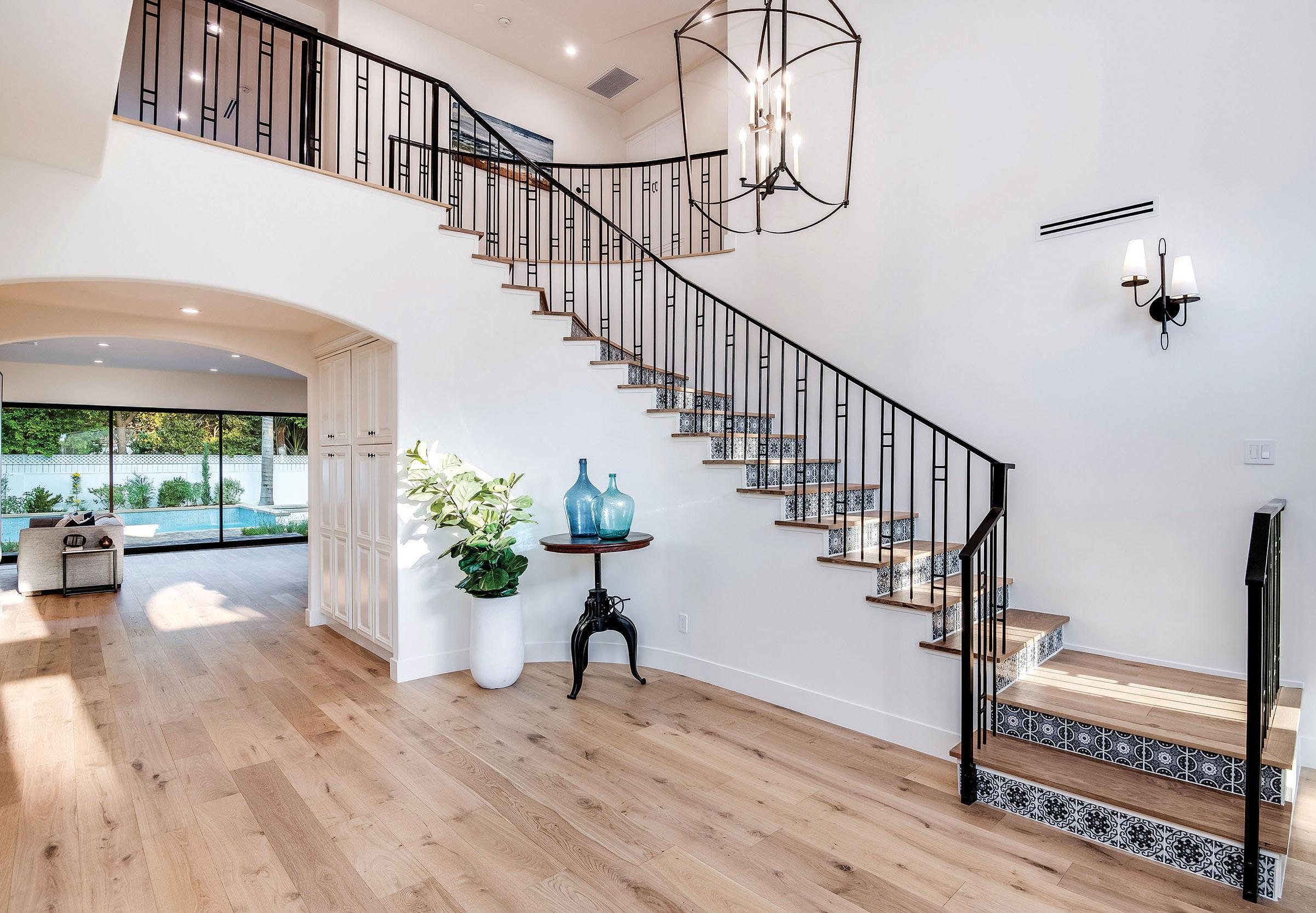





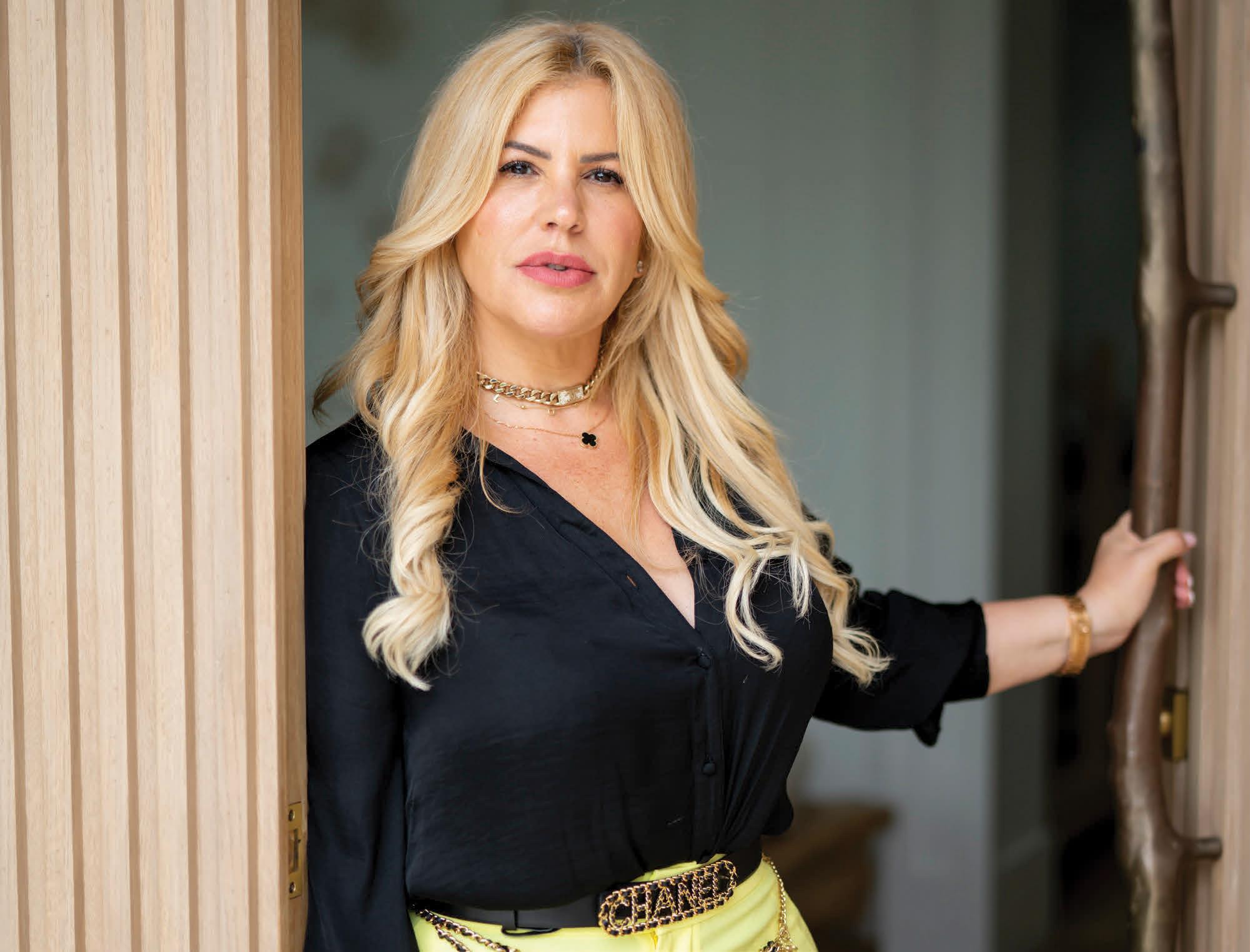
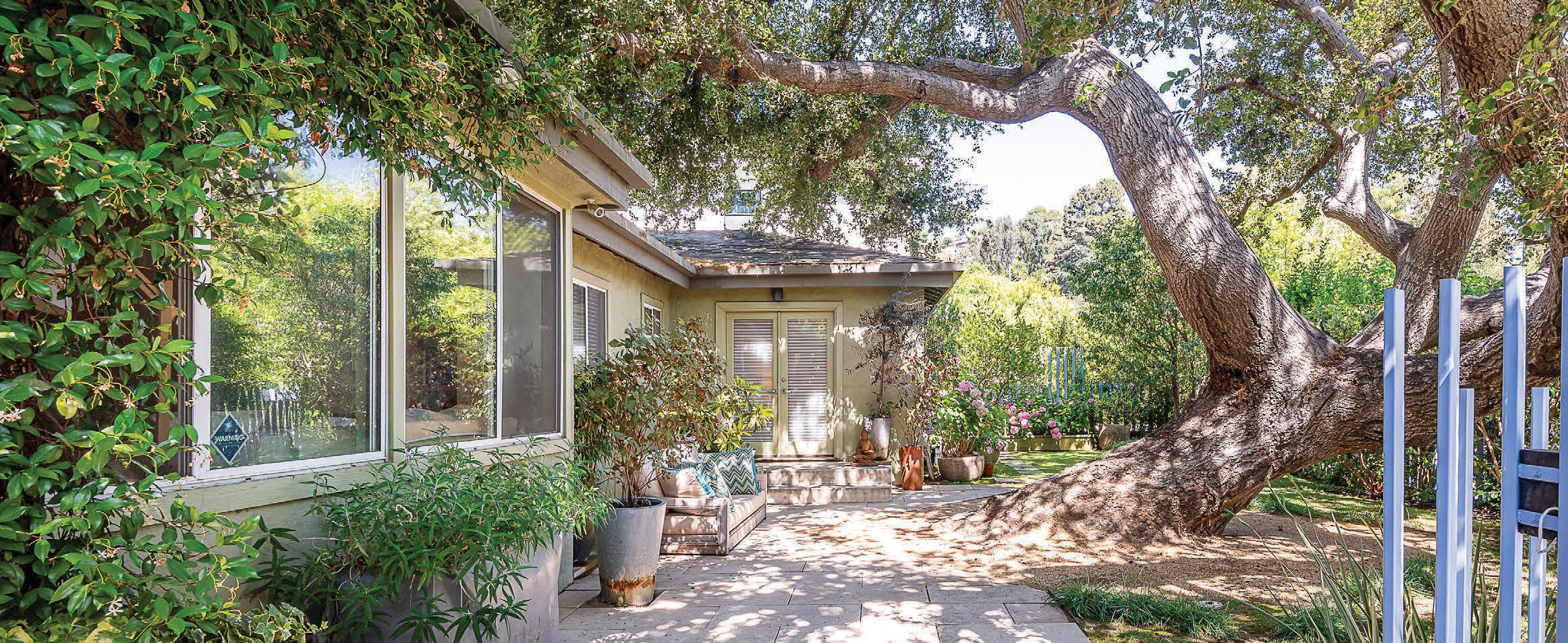





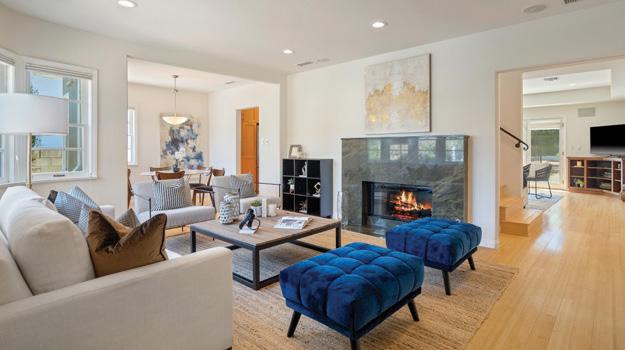










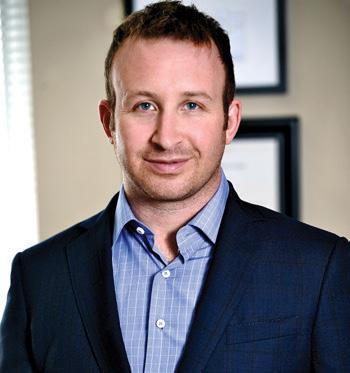
– EN- $2,995,000 5Br+3.5Ba in 3,838 SqFt on a 43,679 SqFt Lot – This amazing home in Sherman Oaks is on the end of a cul de sac. Features 5 bd and 3.5 ba with jet-liner views of the SFV, an open floor plan, wine room, two fireplaces, and much more. The home also has an open office space, a wine room, and a spacious family room which could be made into a fantastic home theater. Wake up to the sounds of birds singing, canyon breezes, and spectacular sunrises every morning. There is simply nothing else in the marketplace like this amazing property - it has to be seen to be believed.




3843 Longridge Ave- SO- $12,500 Monthly




4Br+3.5 Ba in 3,382 SqFt on a 15,146 SqFt lot- A timeless Contemporary Mid Century architectural home in the prestigious Longridge Estates. This unique home offers designer touches throughout, with the perfect entertaining space. The first level features the master suite, a den, a laundry room & a guest bathroom. This stunning architectural home which has stood the test of time doesn’t come around often, especially on the most sought-after street in Sherman Oaks!


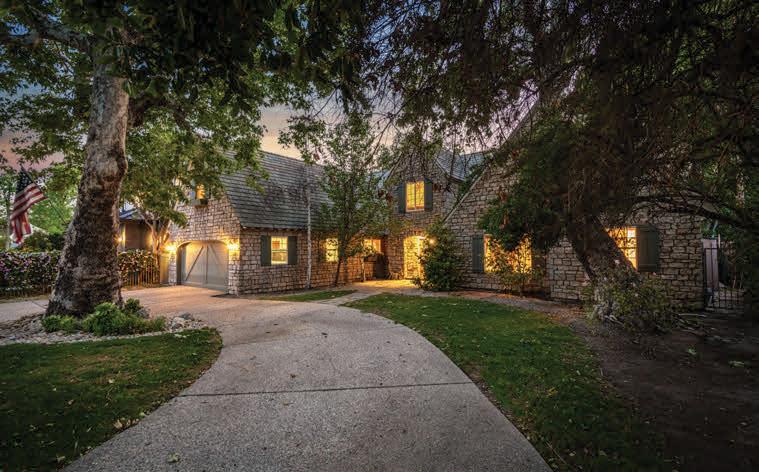
















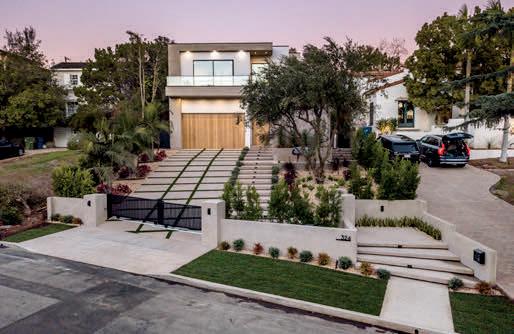
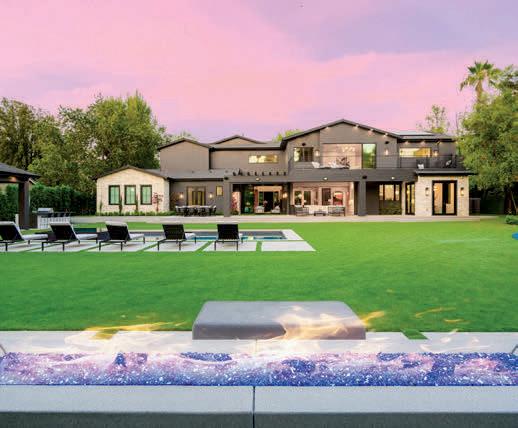


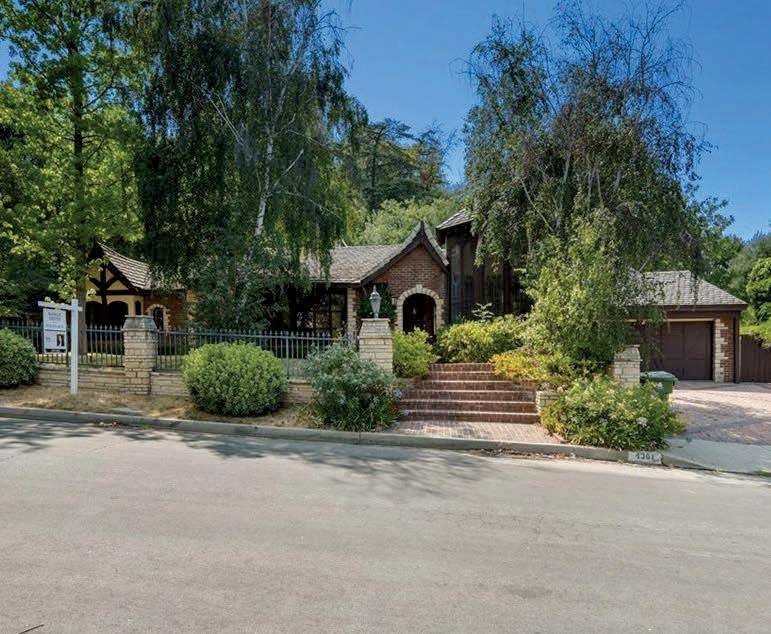

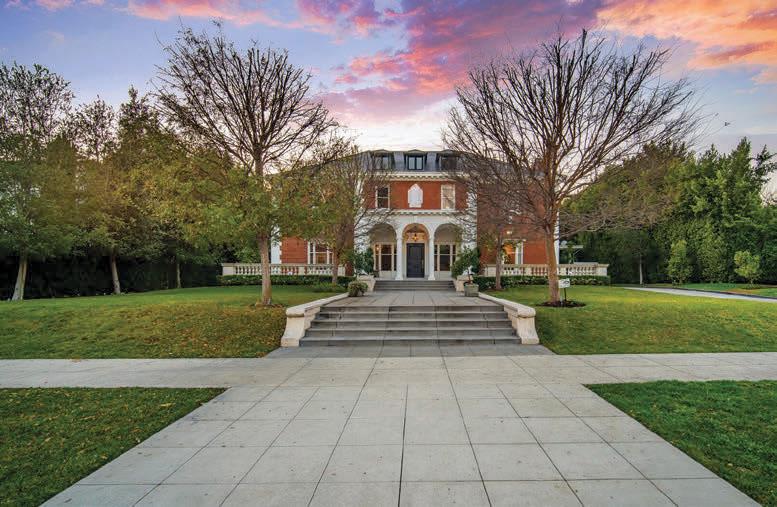

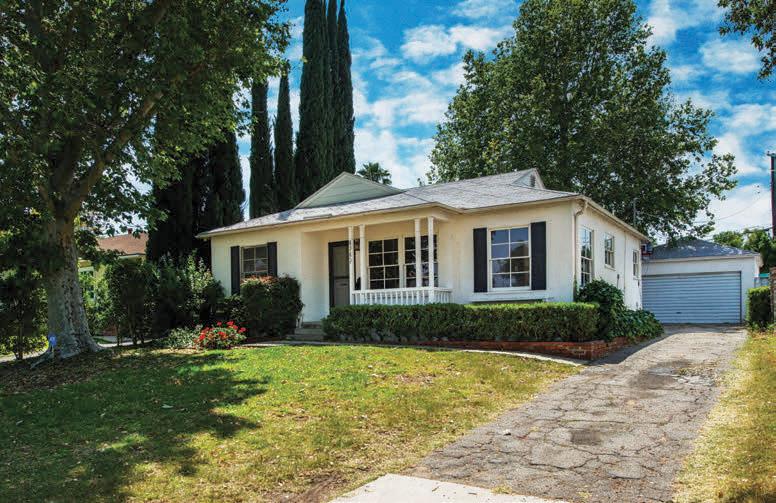

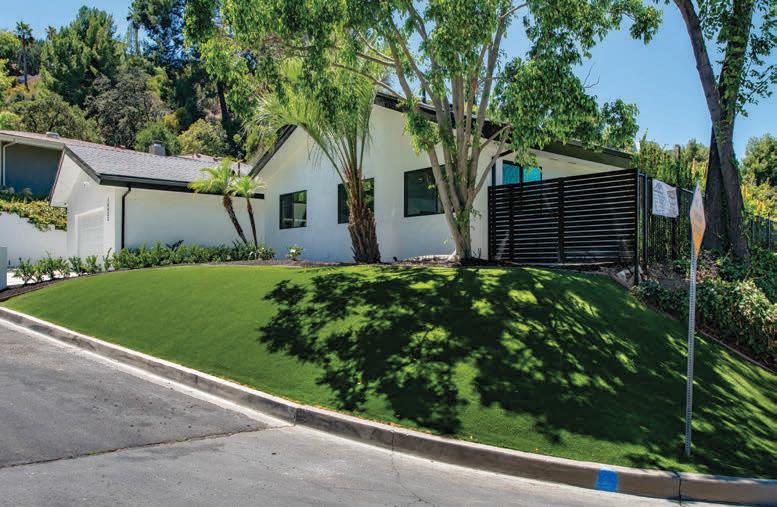




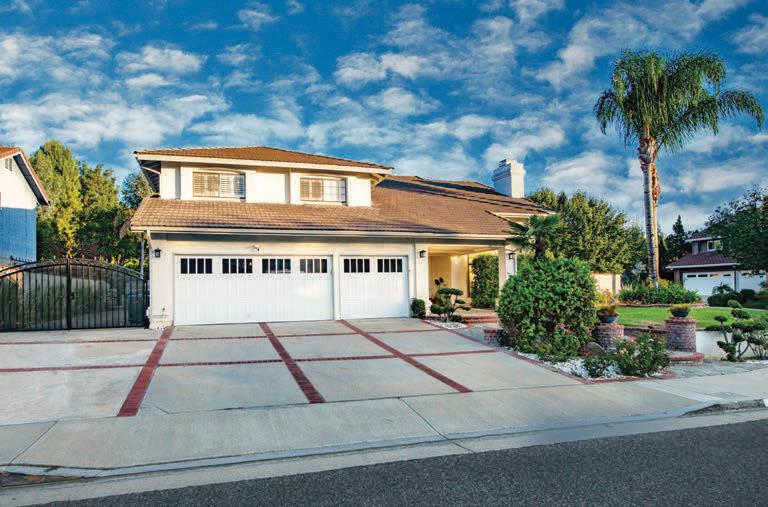





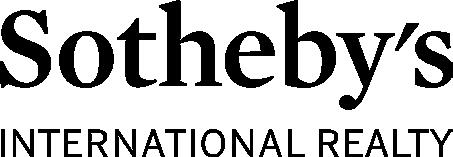
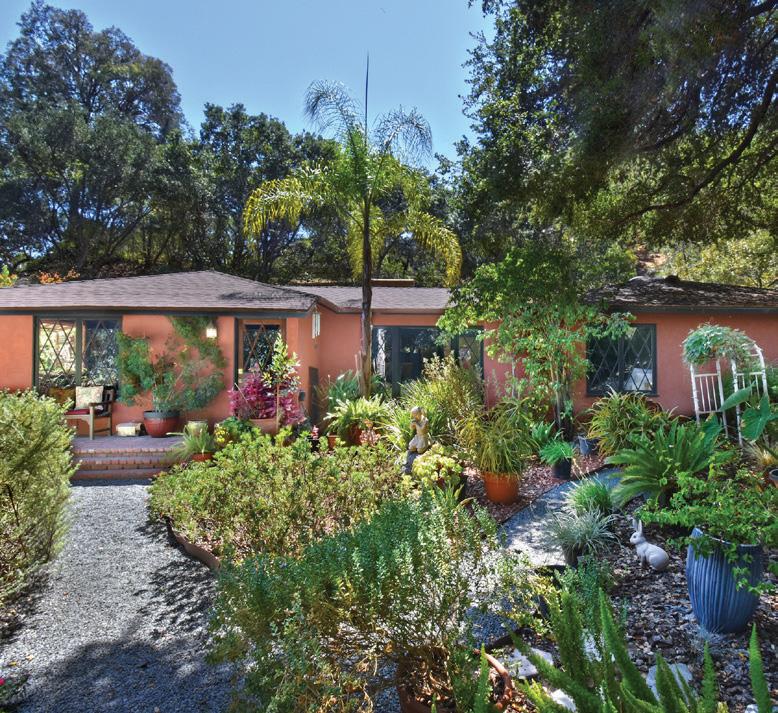
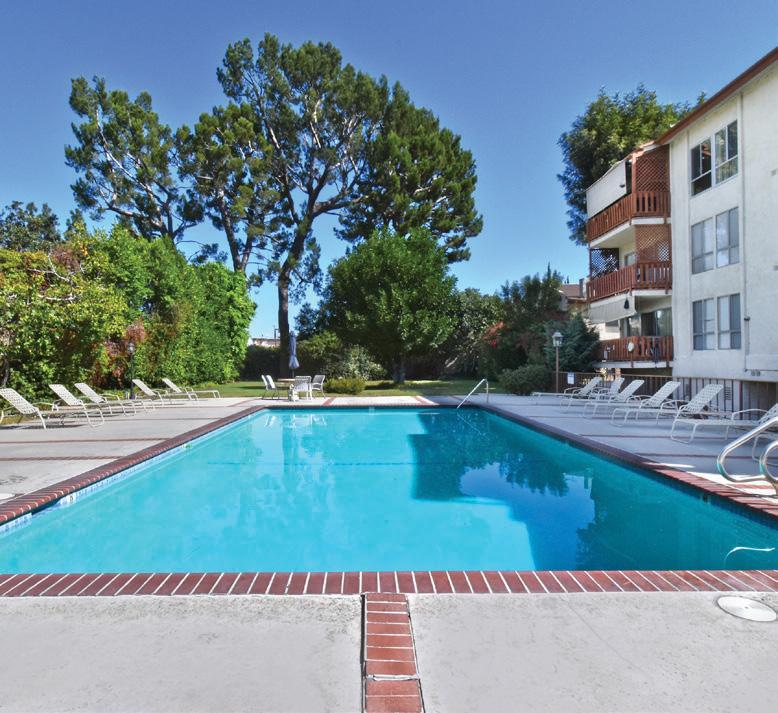








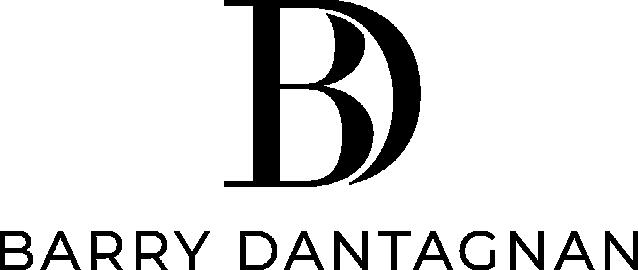




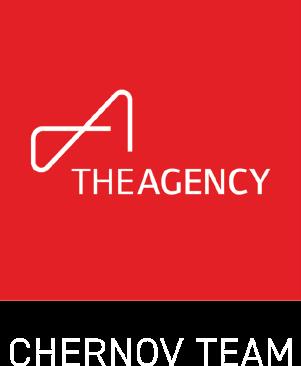

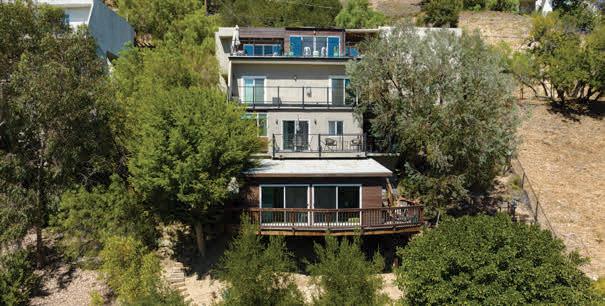





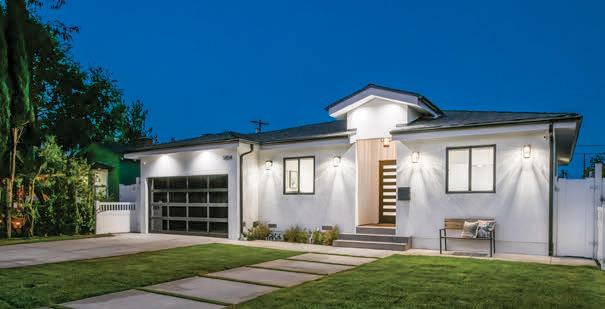

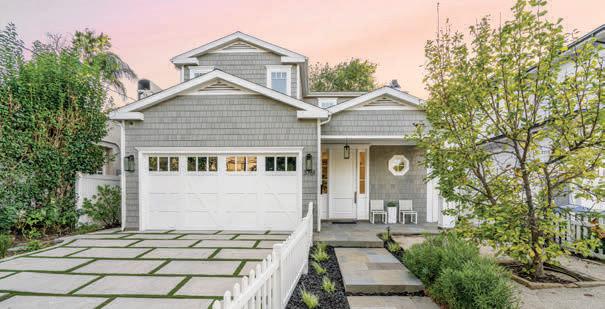





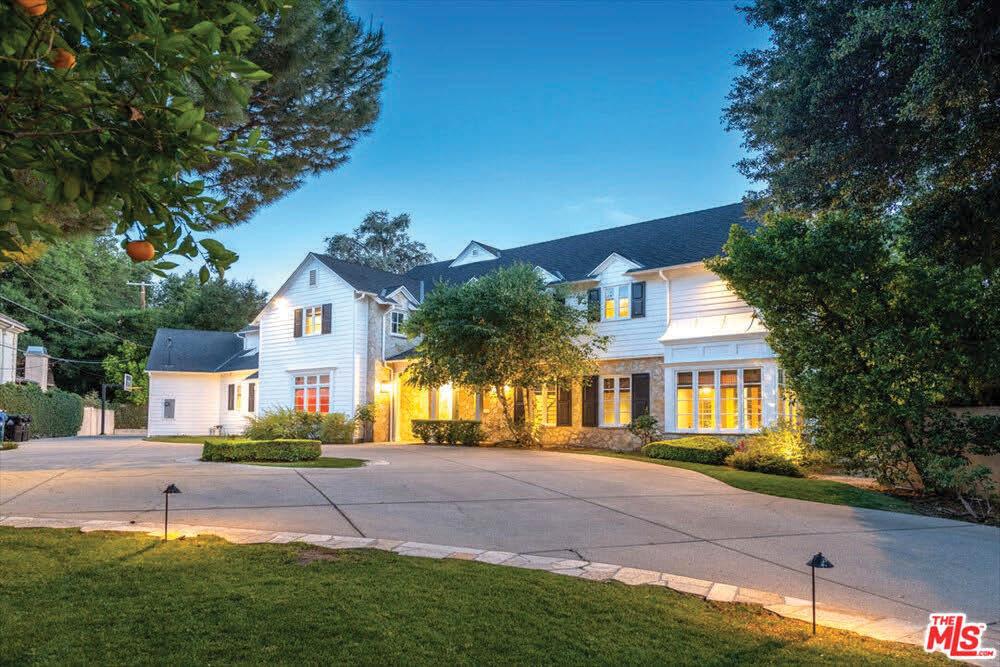

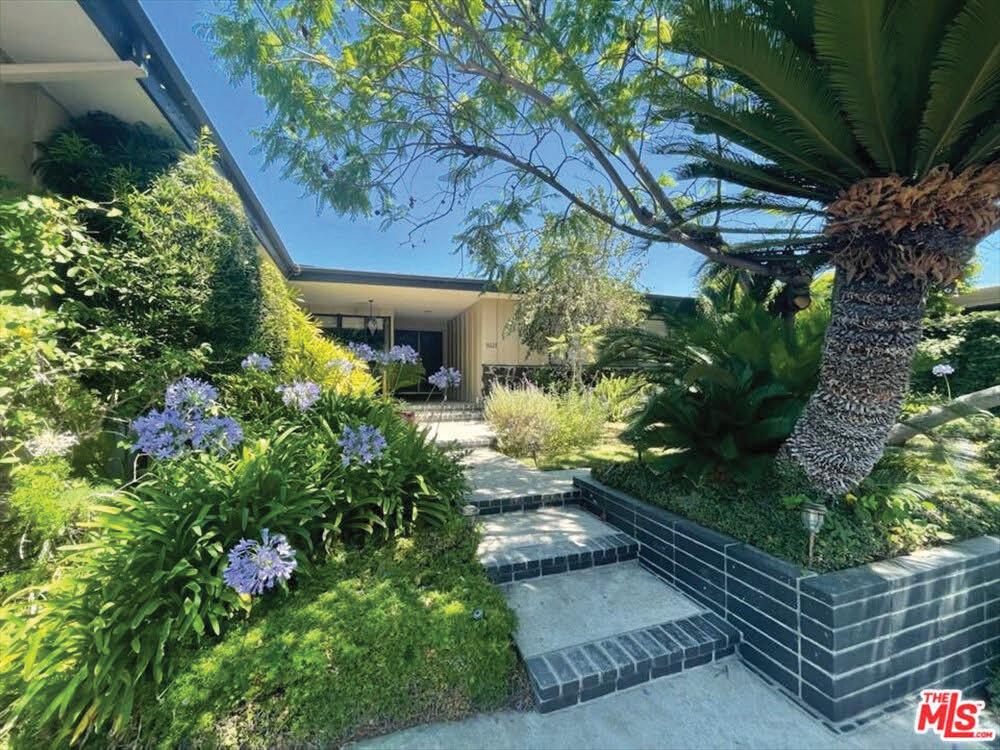









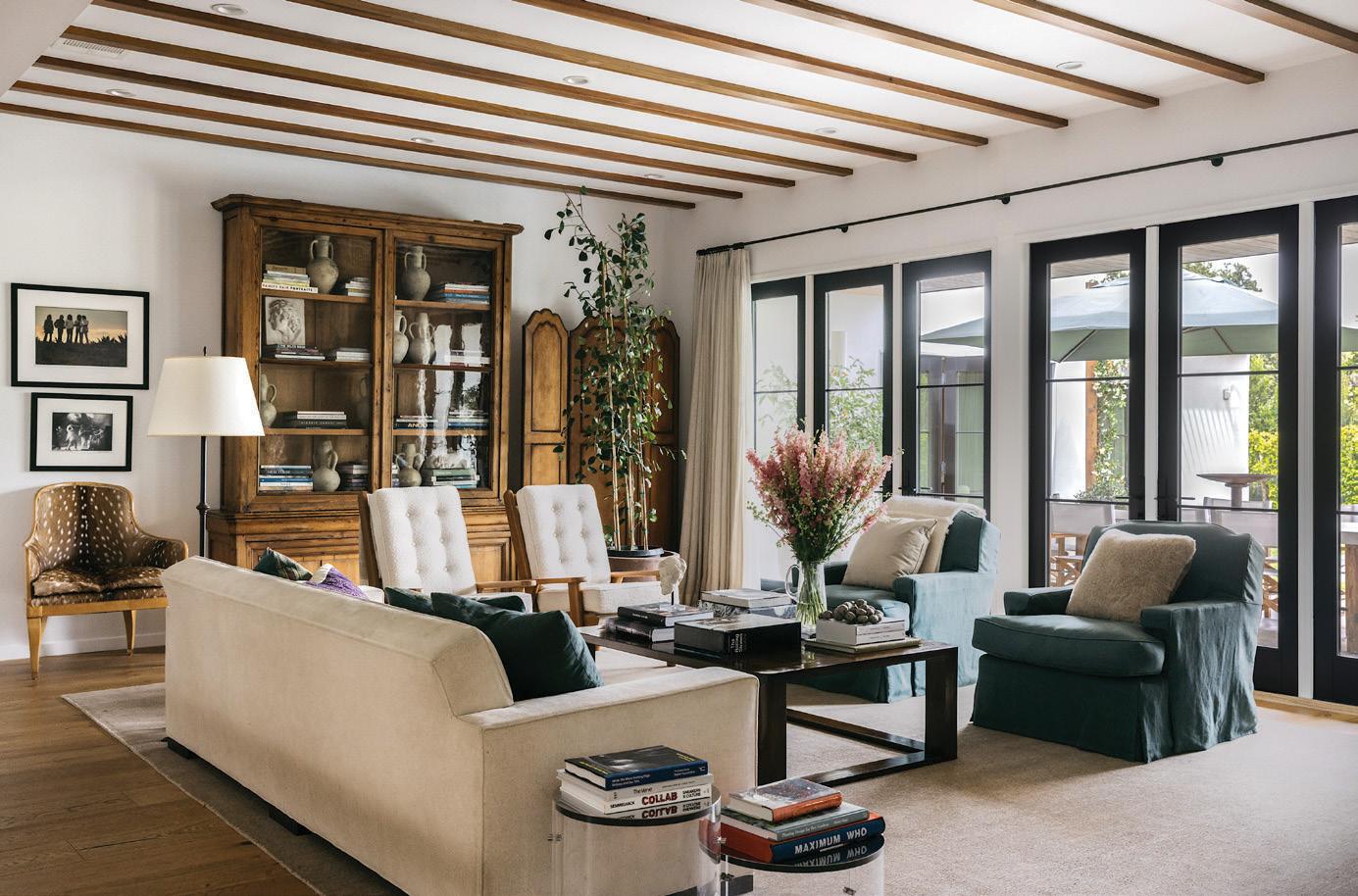

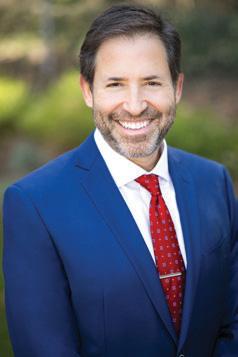
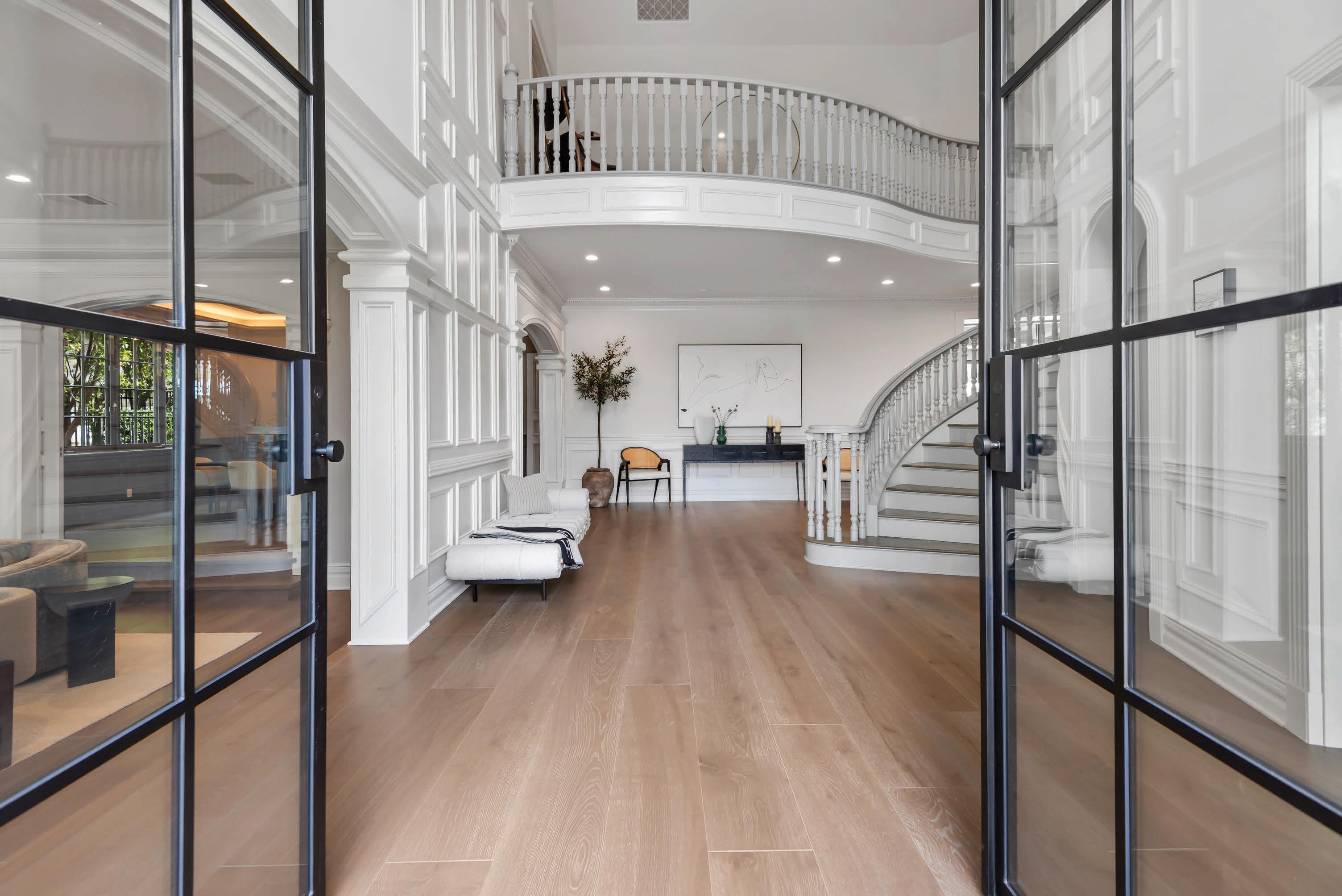
















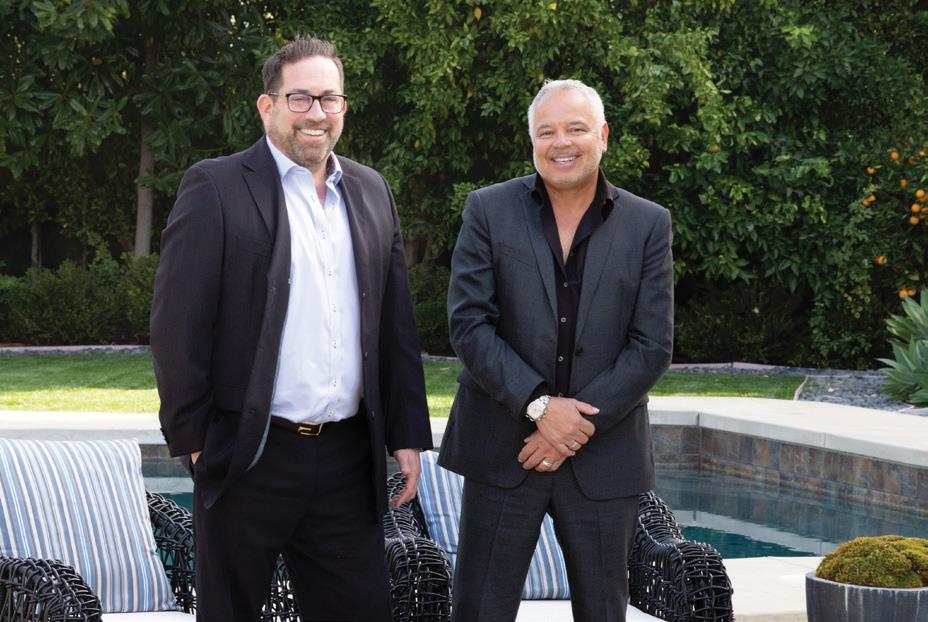



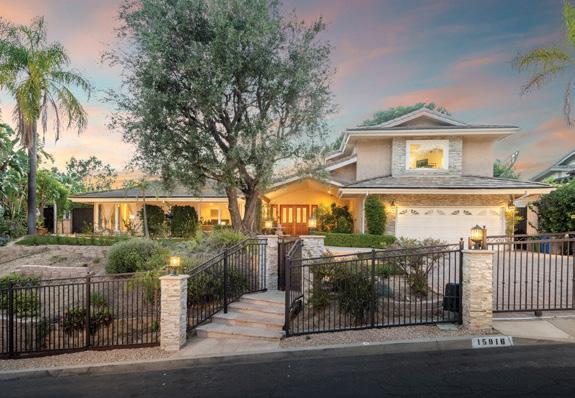

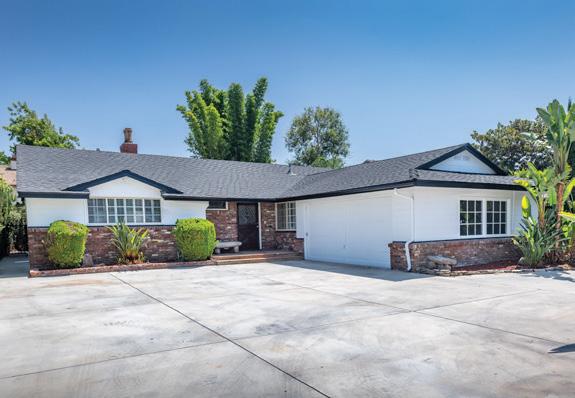

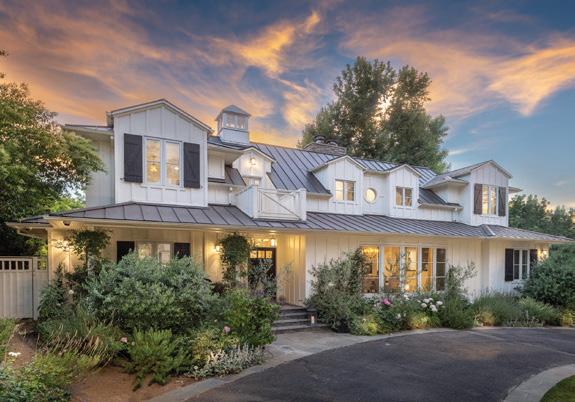
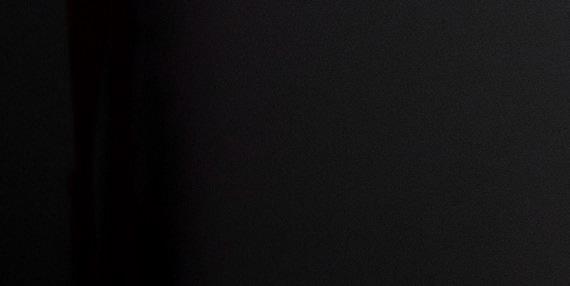

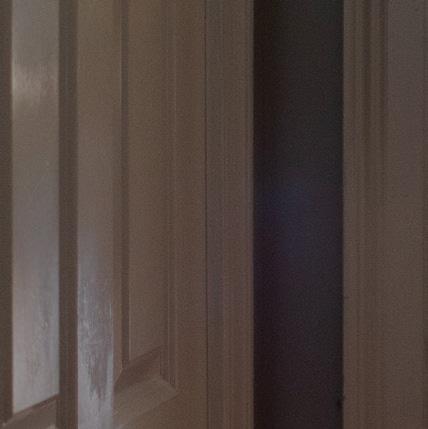







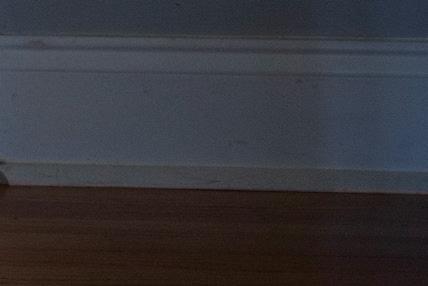
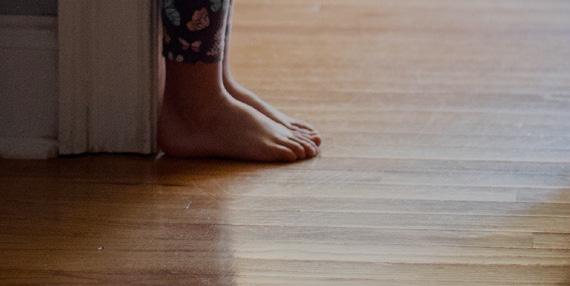





* Citi Mortgage Relationship Pricing - A Citibank deposit account is required to receive the interest rate discount or closing cost credit.
Automated monthly transfers of the mortgage payment from a Citibank Deposit Account using automated drafting will be required. Actual interest rate discount or closing cost credit will depend on the level of the Citi Eligible Balances, which will be verified after final loan approval.
Citi Eligible

$1 - $49,999.99 $500 off closing cost
$50,000 - $199,999.99 1/8% (0.125%) off interest rate
$200,000 - $499,999.99 1/4% (0.250%) off interest rate
$500,000 - $999,999.99 3/8% (0.375%) off interest rate
$1,000,000 - $1,999,999.99 1/2% (0.500%) off interest rate

$2,000,000 or more 5/8% (0.625%) off interest rate
Deposit Account Balances must be in the account five (5) Business Days following final loan approval and Investment Account balances must be in the account six (6) Business Days following final loan approval. Citi eligible accounts include a personal, consumer Citibank Deposit Account in which the borrower is a direct signer, Citibank IRAs, and Investments held in linked Citigroup Global Markets Inc. (“CGMI”) accounts. The borrower must be an account holder on investment accounts. IRA and annuity positions shown on linked CGMI Account statements are eligible (except tax qualified annuities under sections 401, 403, or 457 of the Internal Revenue Code). Balances from Citibank Business / Commercial accounts, ERISA accounts, Keogh accounts, Bank Collateral accounts, Foreign accounts, Fiduciary accounts, and Trust accounts where the borrower is only listed as the Beneficiary are excluded. All Custodial type accounts are excluded with the exception of Custodial IRA accounts through Citibank or Pershing LLC where the borrower(s) is the beneficiary, which are eligible unless otherwise noted. Citibank IRAs that are not linked to a Citibank Deposit Account are excluded.
The closing cost credit offer will be applied at closing and may not be used prior to closing. In Texas, the credit may not result in you receiving cash back.



If you are interested in Citi’s banking account relationship offers, please contact your Home Lending Officer or Mortgage Representative. Speak to your loan officer about whether the relationship offer is best for you.


Citibank Mortgage Relationship Pricing for Citibank account holders can only be applied prior to loan closing and is subject to account and balance validation. Citibank Mortgage Relationship Pricing is subject to change without notice.
Terms, conditions and fees for accounts, programs, offers, products and services are subject to change without notice at any time. Offer may be modified or withdrawn at any time without notice. Offer cannot be combined with other offers, except when applied with specific Community Lending Programs. Offers are not applicable on Home Equity Loans and Lines of Credit. This is not a commitment to lend. This offer contains information about U.S. domestic financial services provided by Citibank, N.A. and is intended for use domestically in the U.S. Investment products are offered through Citigroup Global Markets Inc. (“CGMI”),
I grew up in Iowa, where fall signified the death of every thing. After Halloween, the last beacon of hope, you settled into a phase of endless gray skies and unbearably cold tem peratures. I hated this time of year.
But when I was 10 years old, a visit to my San Fernando Valley-dwelling great aunt turned me on to a revelatory con cept: endless summer.
Aunt Gerry lived in Reseda, where she had a ginormous, ancient turtle living in the backyard. She had moved to the Valley shortly after World War II and lived in the same home until she died a few years ago—a worshipper of the sun and heat to the very end.

That long-ago vacation planted the seed of a goal: to relo cate to LA as soon as humanly possible.
I finally arrived in Tinseltown to attend USC, where I earned a master’s degree in screenwriting. I reconnected with the Valley when I took a life-changing job working for Joe Weider and his fitness-oriented publishing empire (think Muscle & Fitness magazine) in Woodland Hills in 1997. Joe was a legendary figure in bodybuilding who helped popularize the sport and introduced Arnold Schwarzenegger to the world.
The job would be yet another step in my “Go west, young man” saga. I ultimately found magazine publishing more re warding than writing screenplays and sitcom specs (and chas ing after agents). I’ve worked as a freelance writer ever since.
I eventually bought a place and moved to the Valley, where
I found the quality of life better than in my old neighborhood in West Hollywood. From my home in Woodland Hills, I’m a quick jaunt to the beaches in Malibu to surf. Dozens of hik ing trails are within a short drive, and I can quickly immerse myself in nature. It is essentially my meditation.
And then there’s the wildlife entertainment. On any given hike I may see a coyote that looks as though it was styled by José Eber. Or a mass of mesmerizing native wildflowers that look like they could be fake. Some years are rife with snakes; in others there are bunnies everywhere. 2022 seems to be the year of the crow.
After several years of living in the Valley, my only com plaint is the scorching summer heat. It makes everything from getting into a car to exercising outdoors patently unpleasant. But then—just when I feel like I can’t take it anymore—along comes fall. I look forward to October the way kids anticipate Christmas.
Fall in the Valley creeps up on you. First there’s that subtle shift in the early evening light. The nights get cooler. The sun actually starts feeling good on your back. Daytime tempera tures shift to moderate. The ocean water is tepid. Trees drop leaves—but now instead of signifying death, fall signals rebirth. It is a reawakening of the very concept that brought me here: endless summer. Every October I remember exactly why I came to California.
■















You never know when one of life’s great moments will happen, and we want to make sure you’re ready for them. At Facey, our rheumatologic care doesn’t stop at joint issues. We make sure to provide specialized care for accurate diagnoses and precise treatments. And together with Providence, we provide a seamless care experience whether you’re seen in our exam room or a hospital room.

Make a resolution to live with less pain and reclaim your life. Call us at 818-466-7700 and schedule your visit with Dr. Singh today. We welcome patients with PPO insurance, Medicare Supplement plans, and more. For a complete list of the health plans we currently accept, give us a call or visit our website at: facey.com/insurance
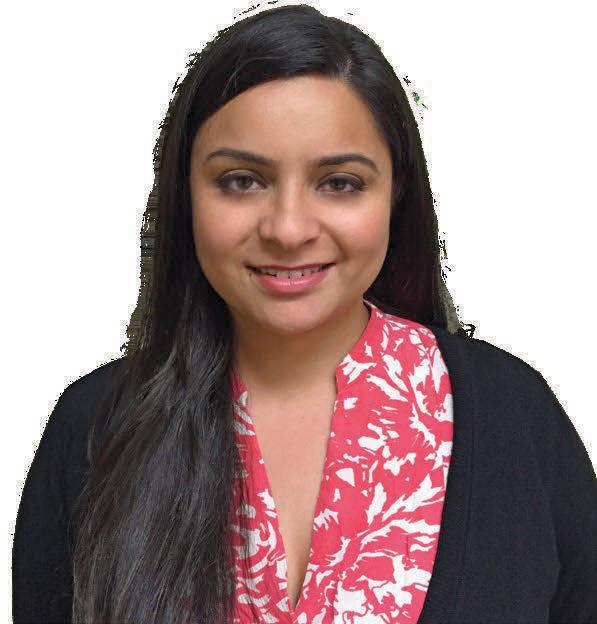
Don’t let joint and inflammation issues get in the way of enjoying every moment.